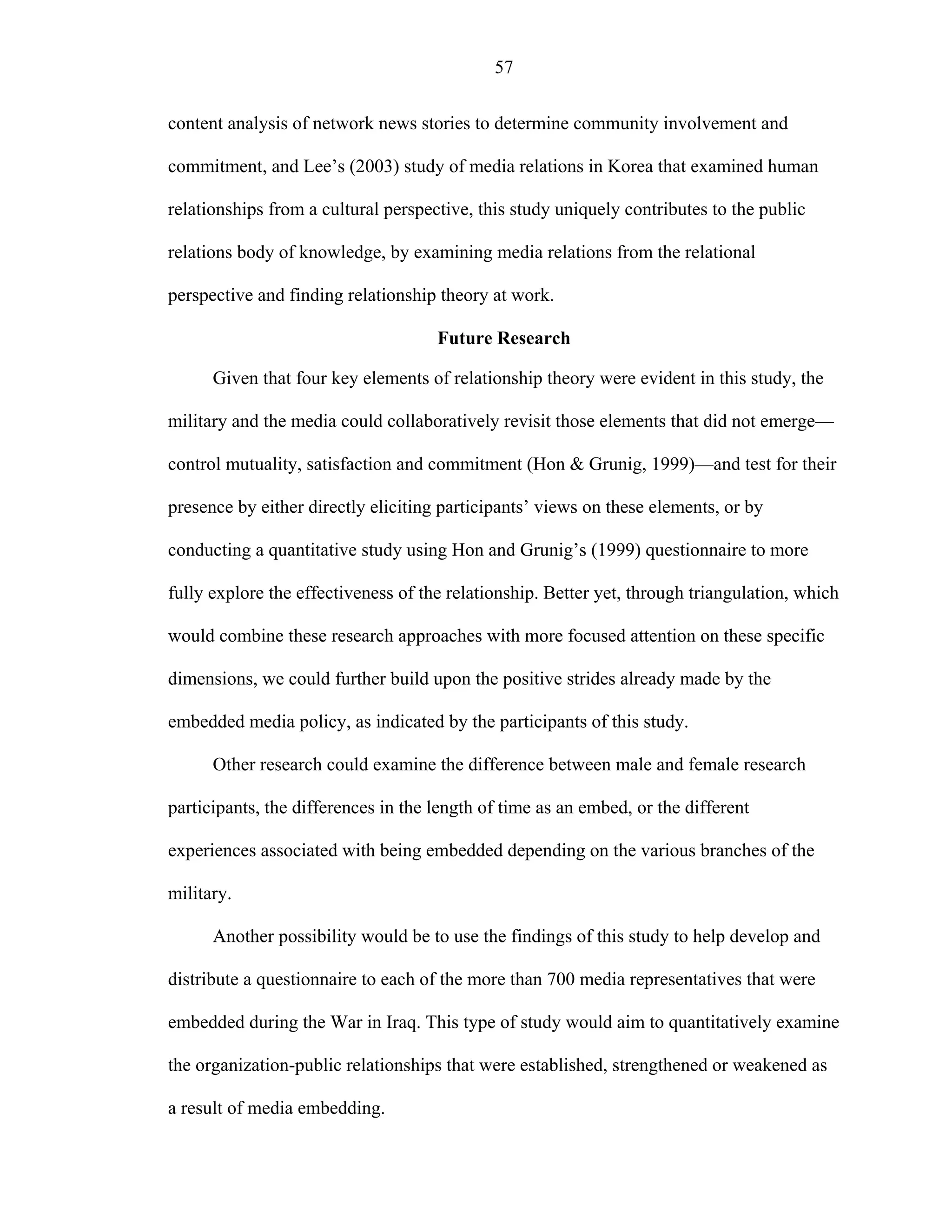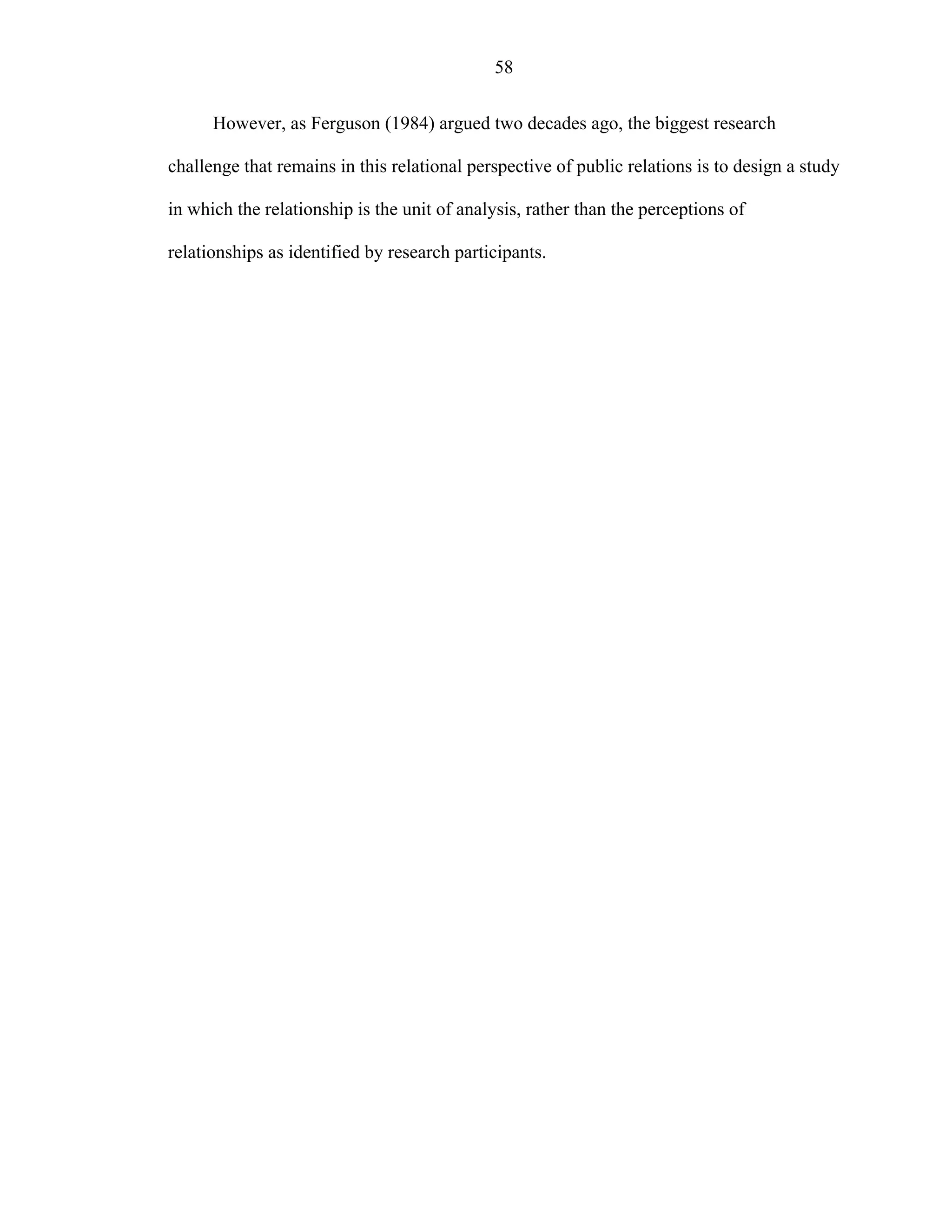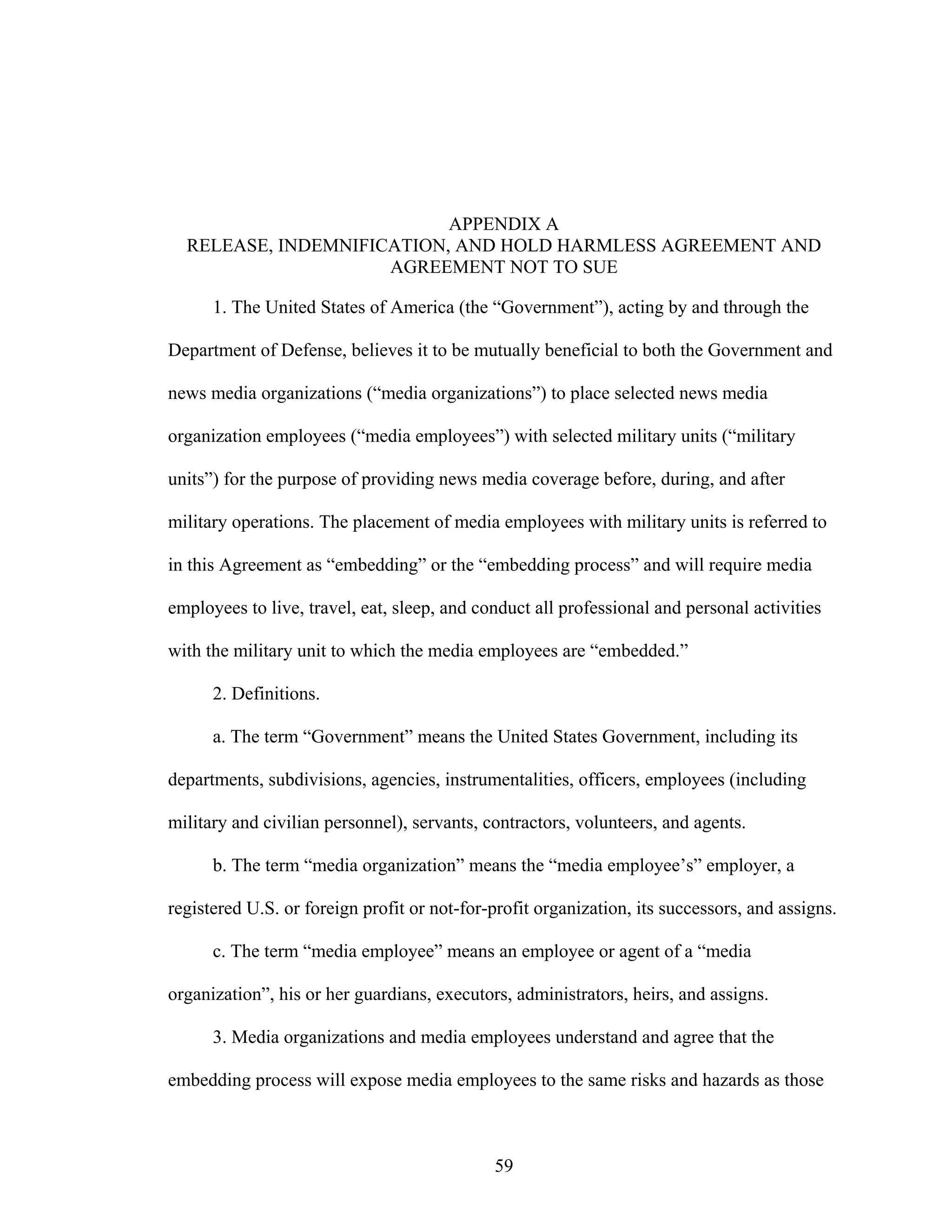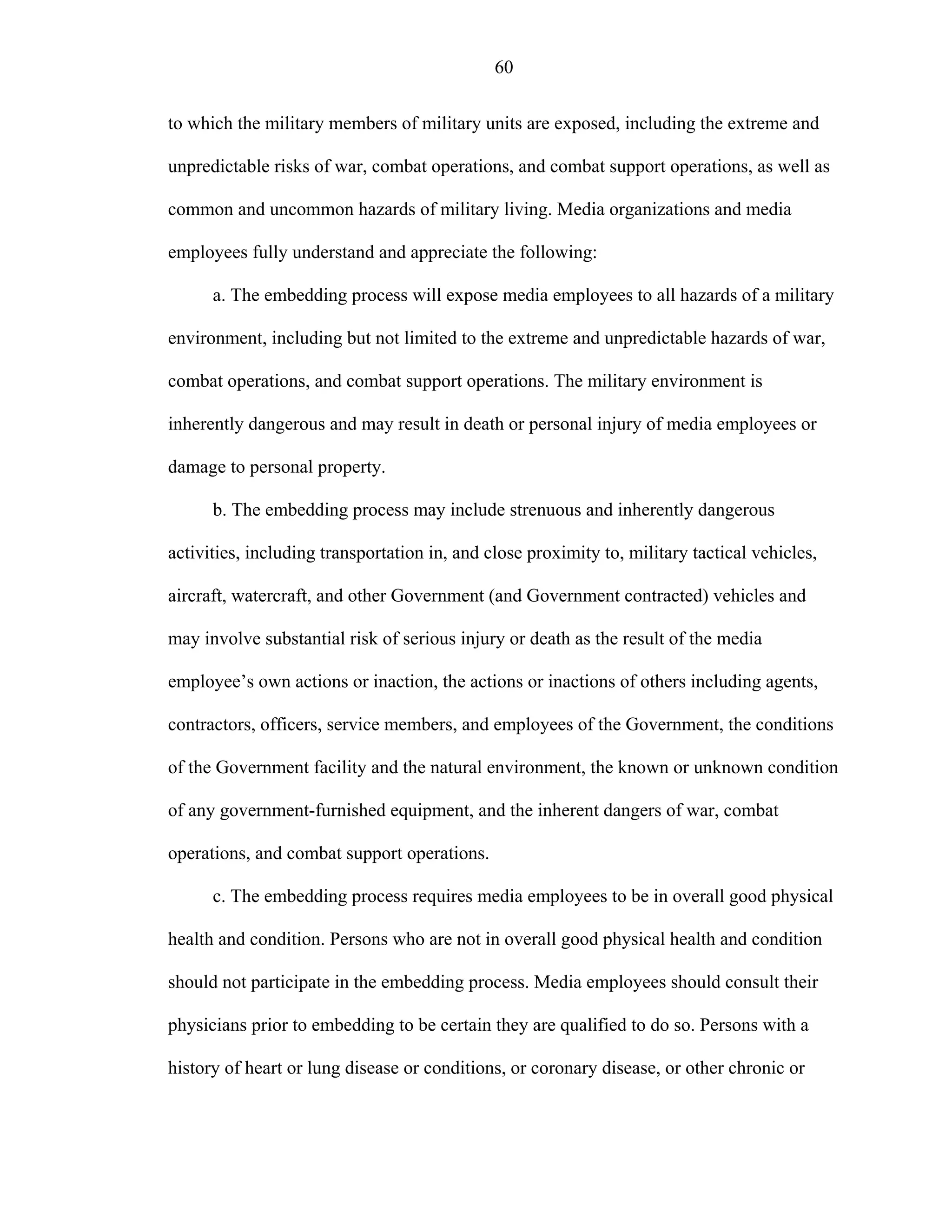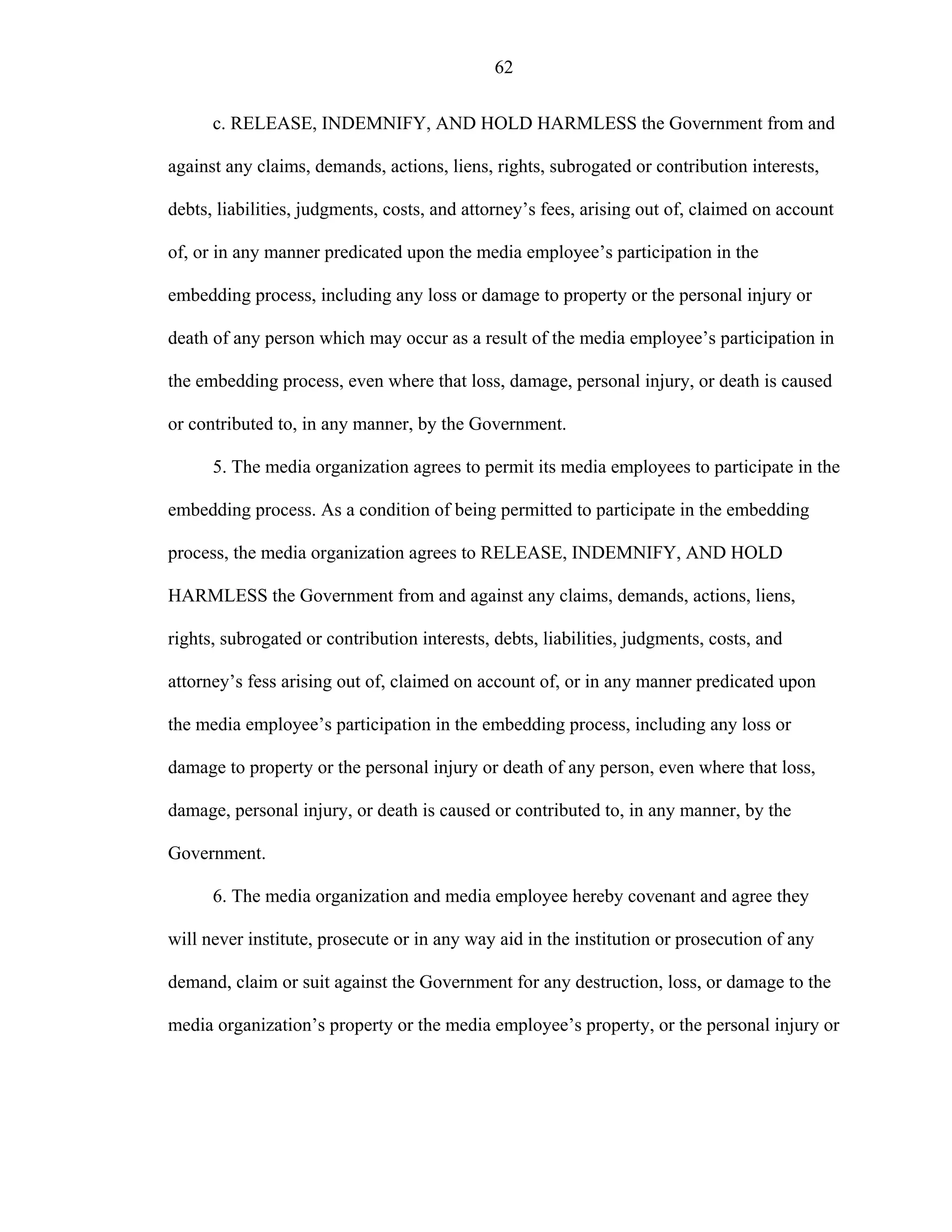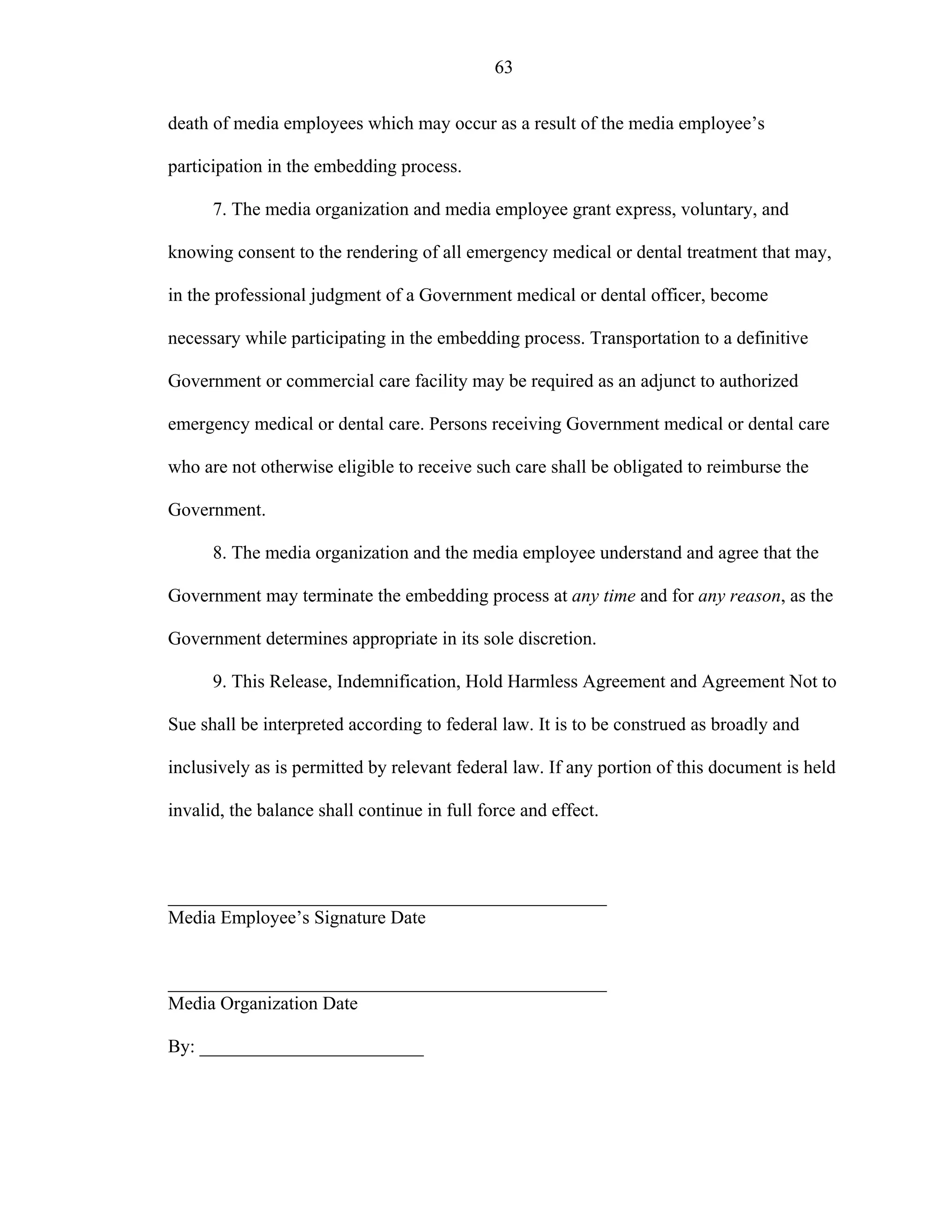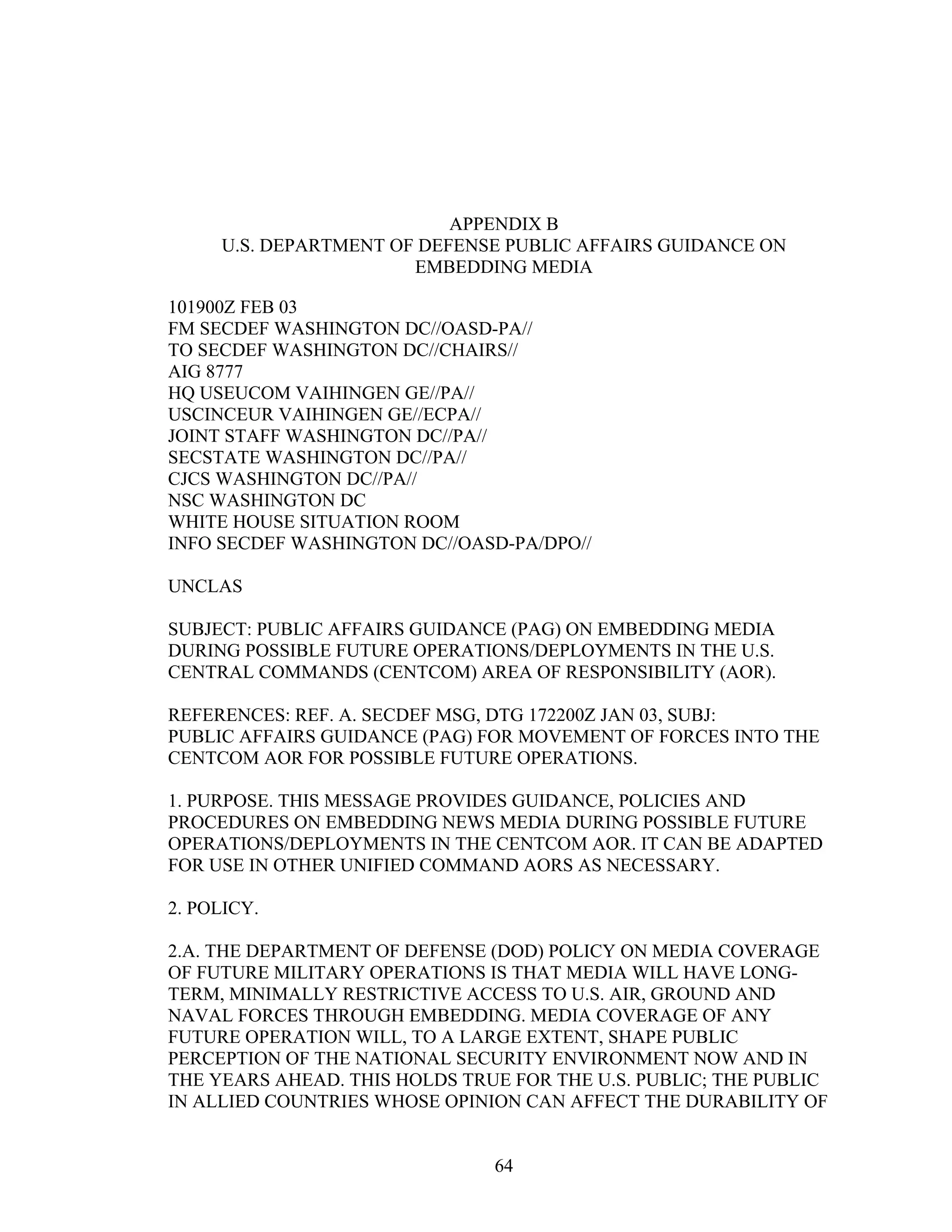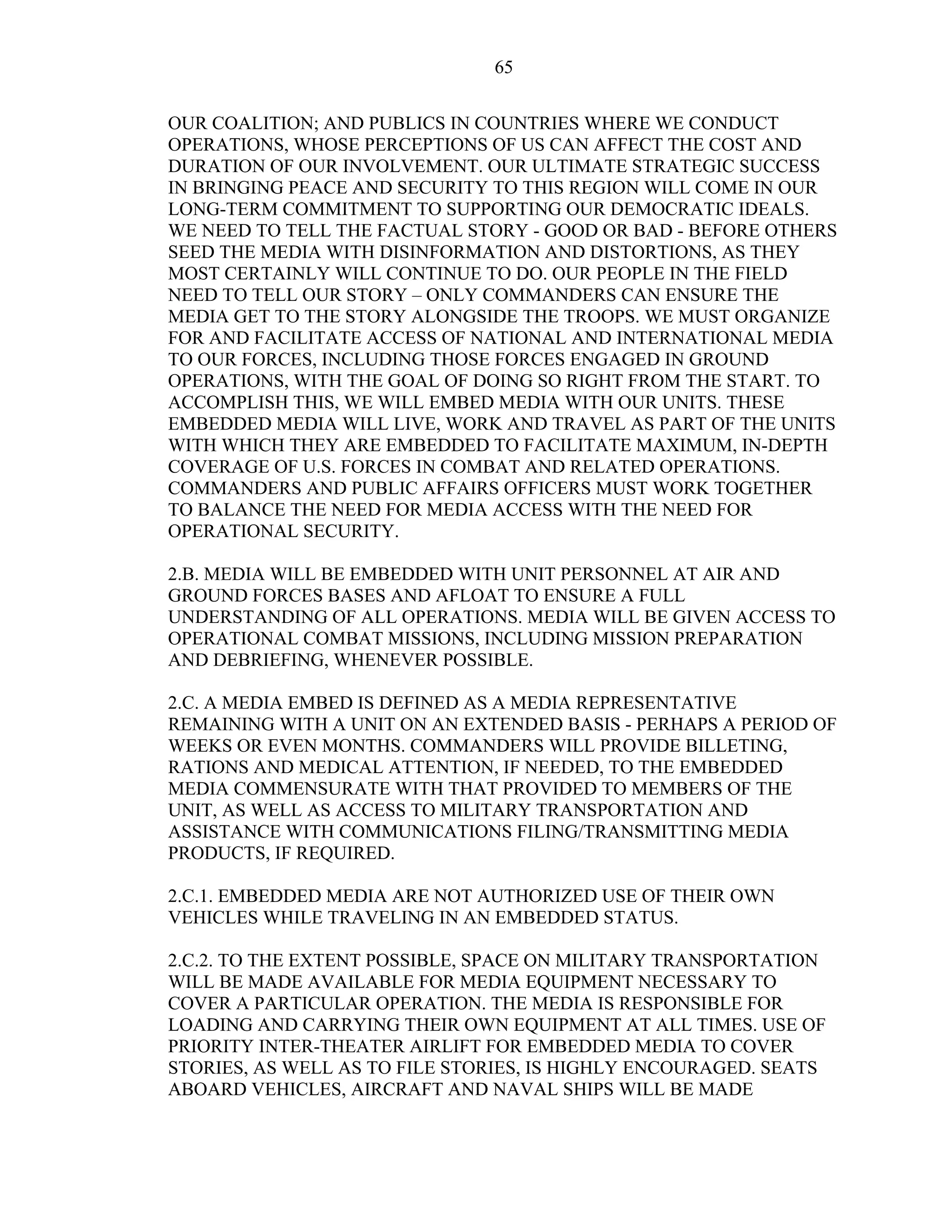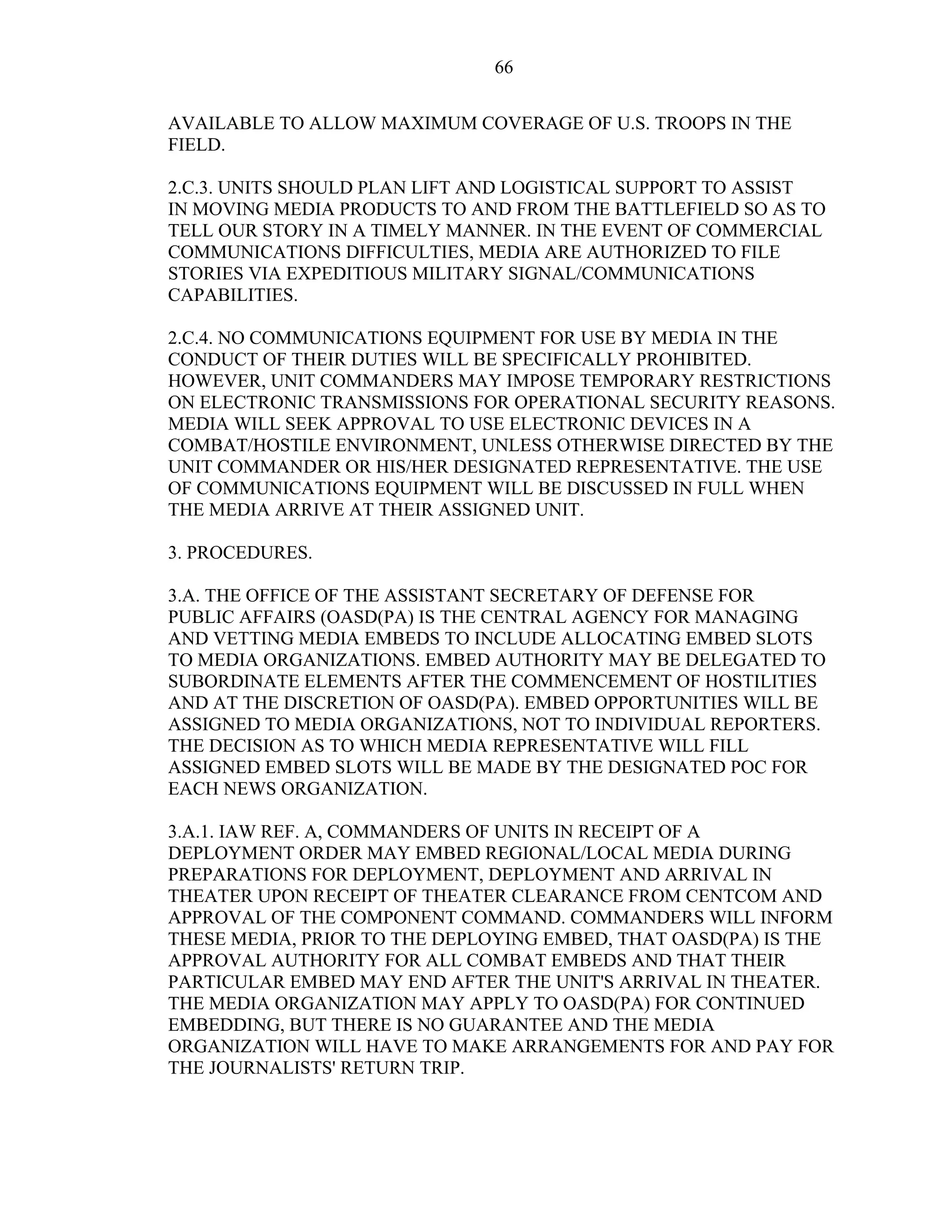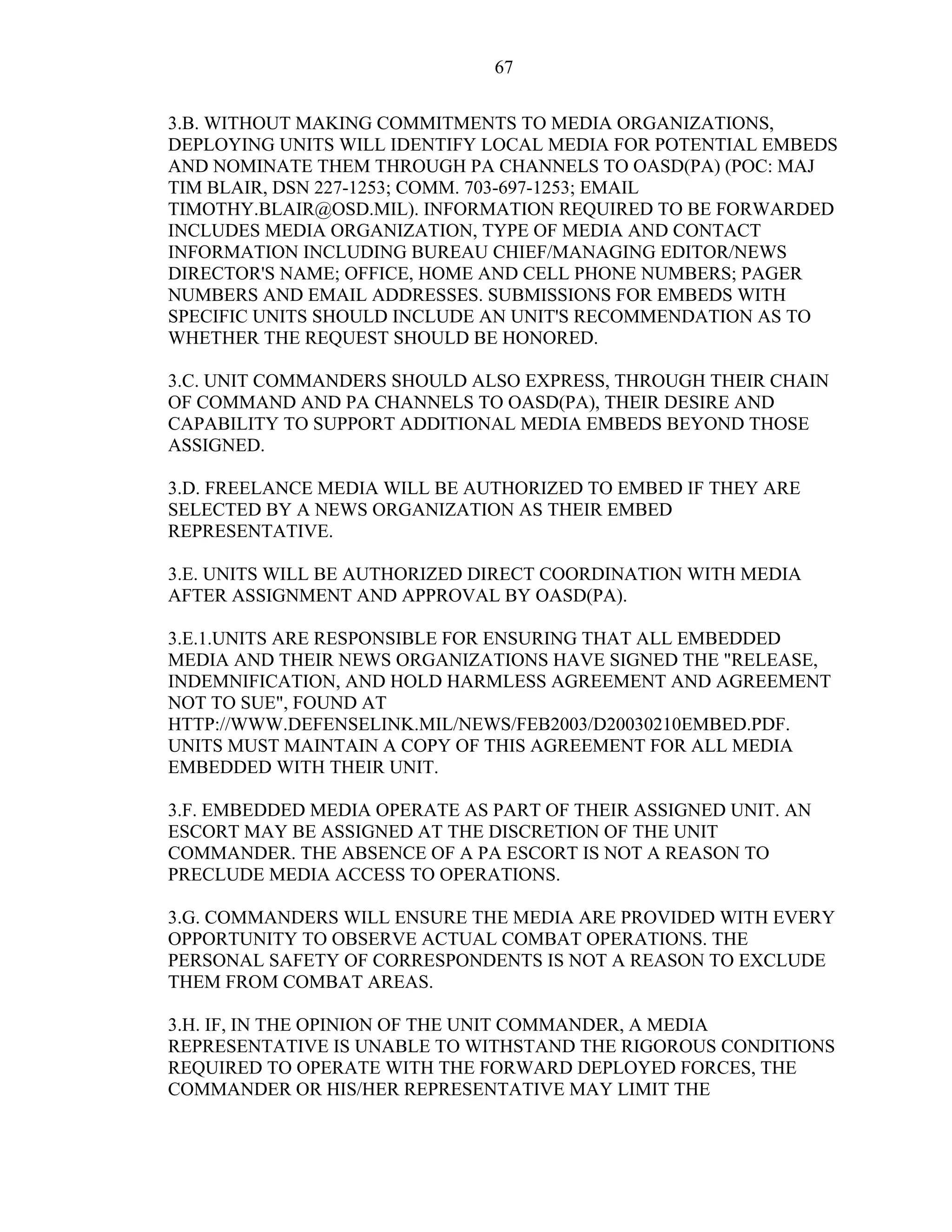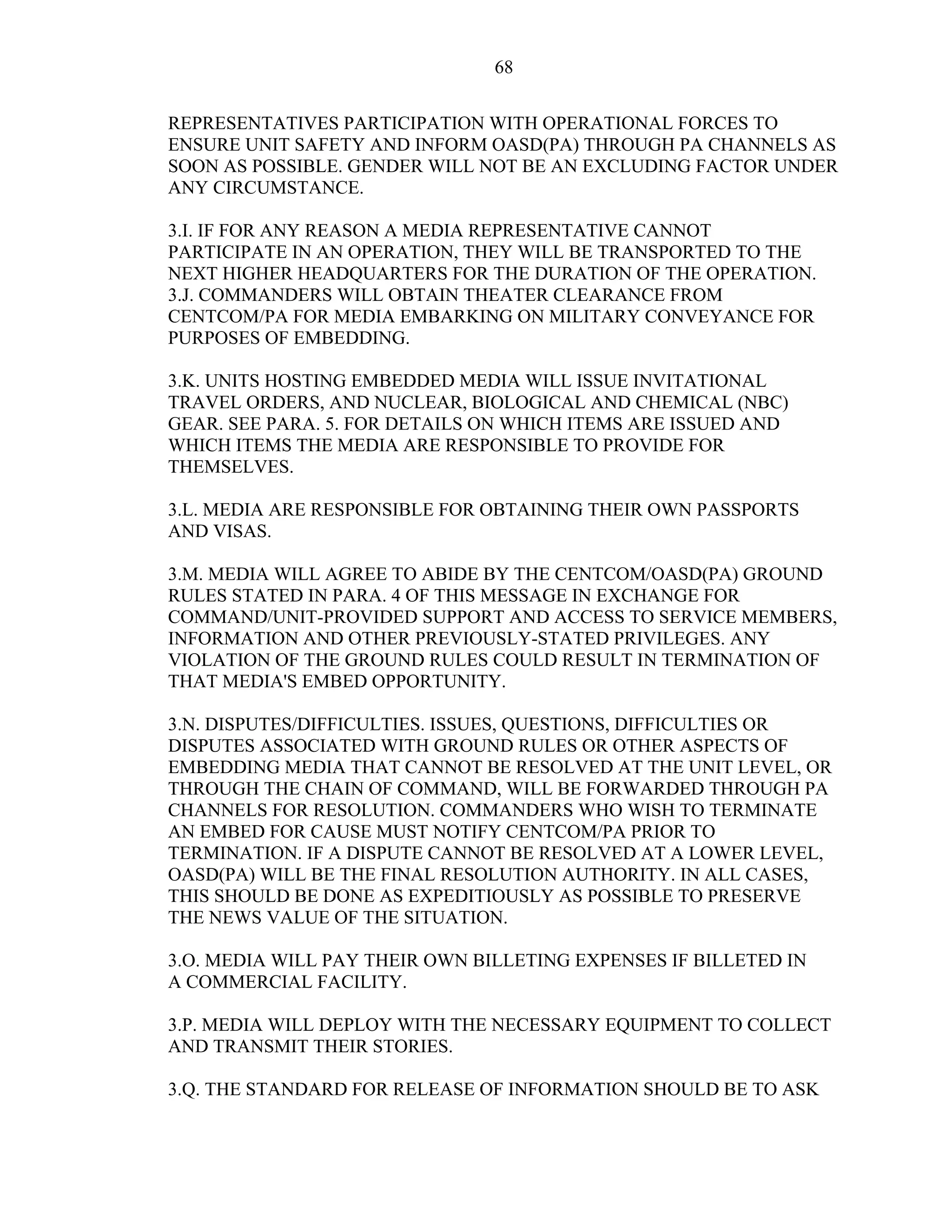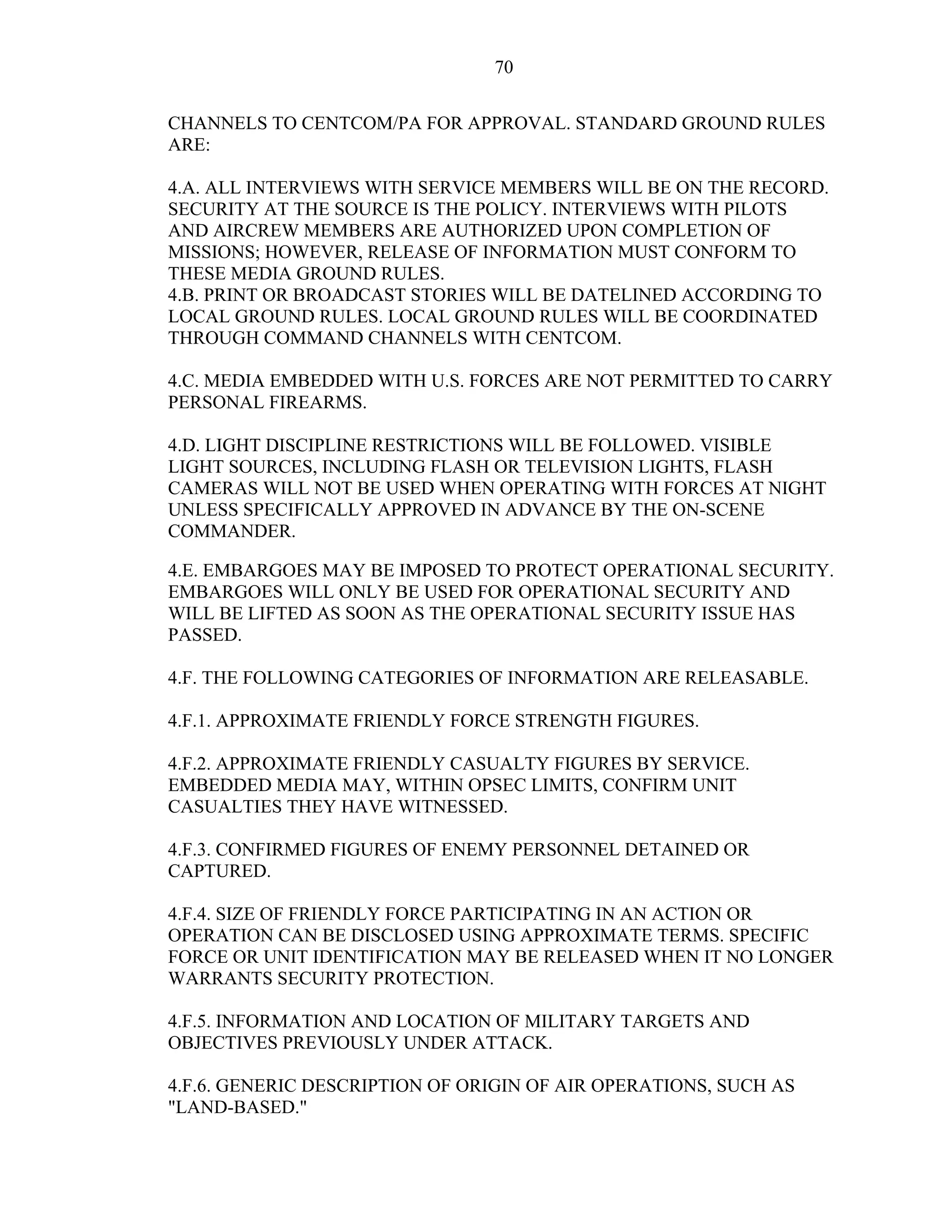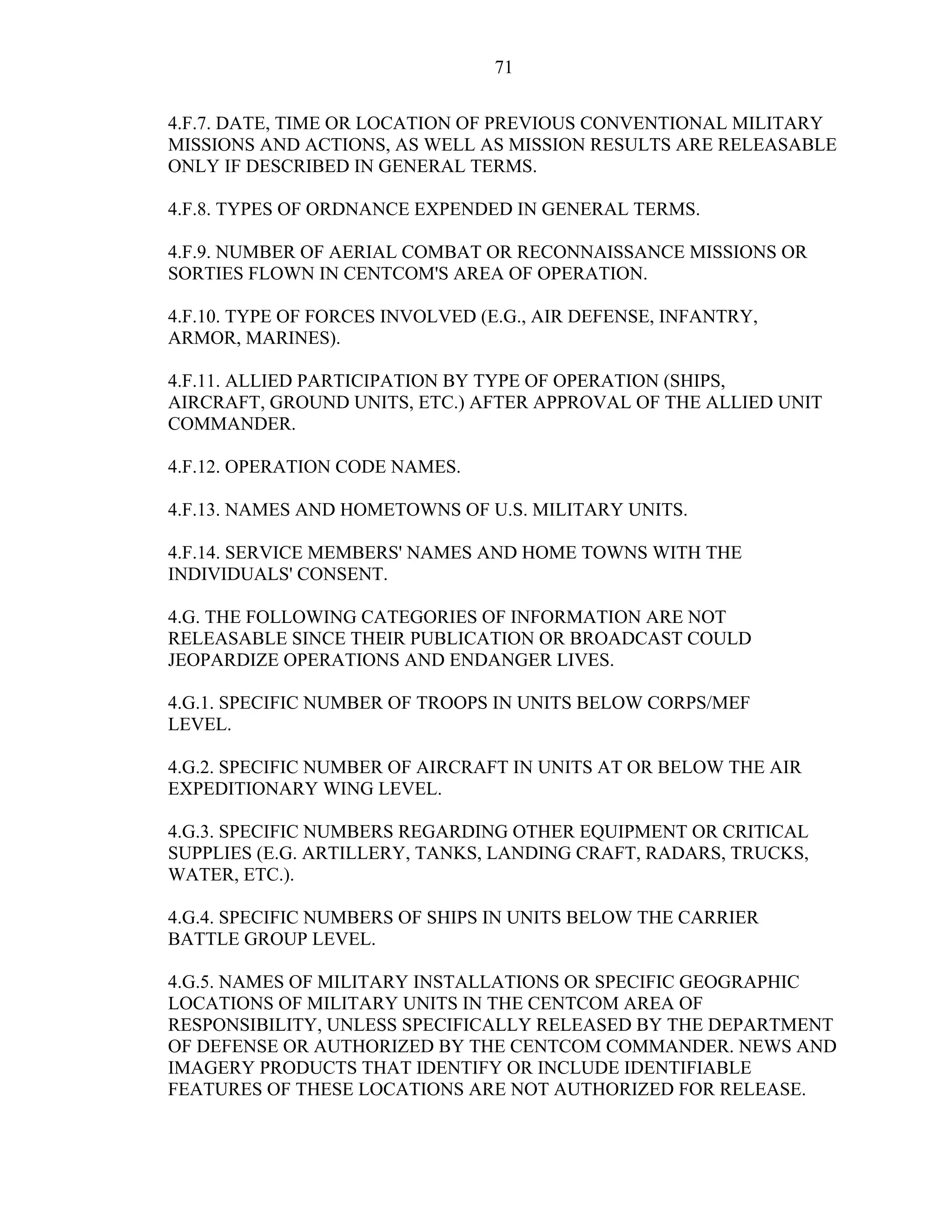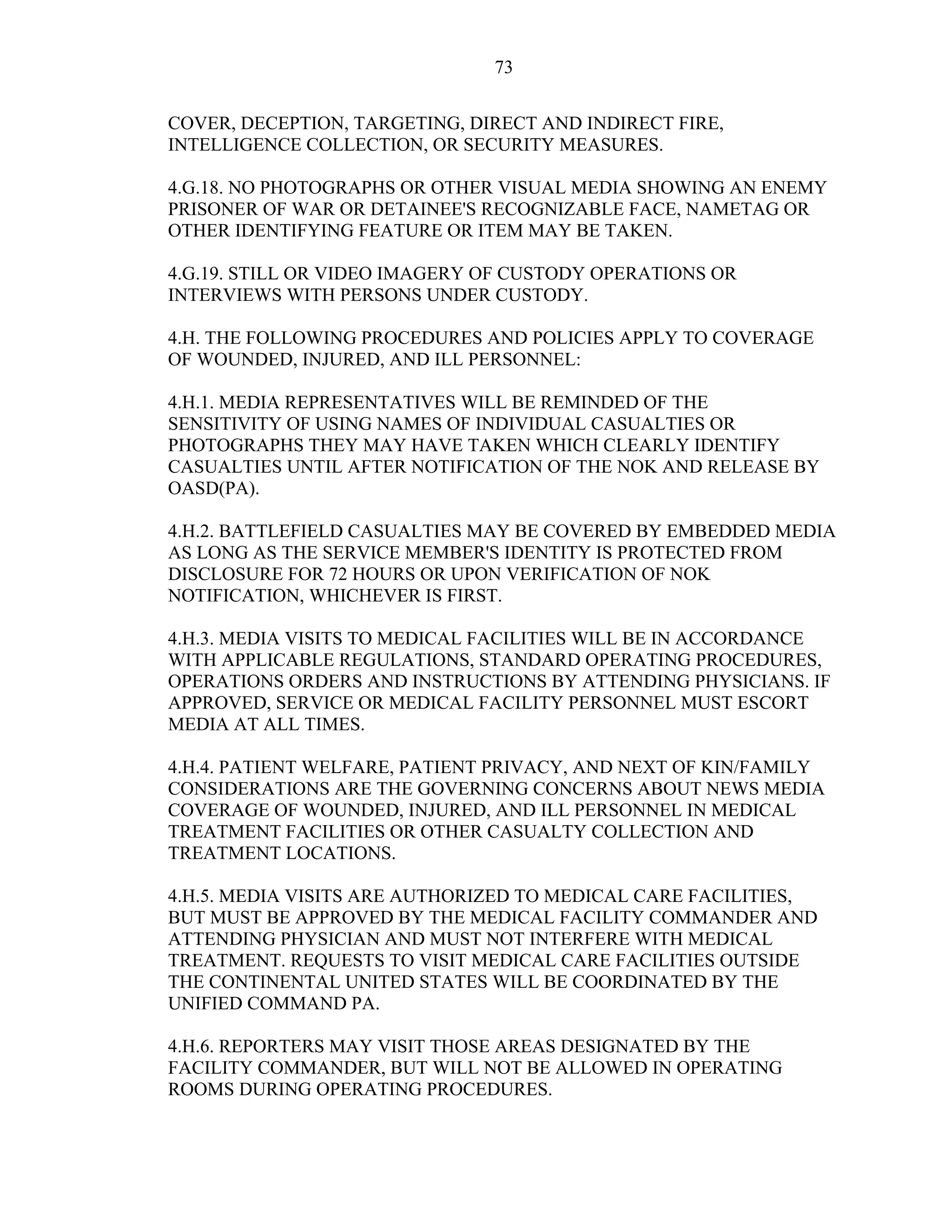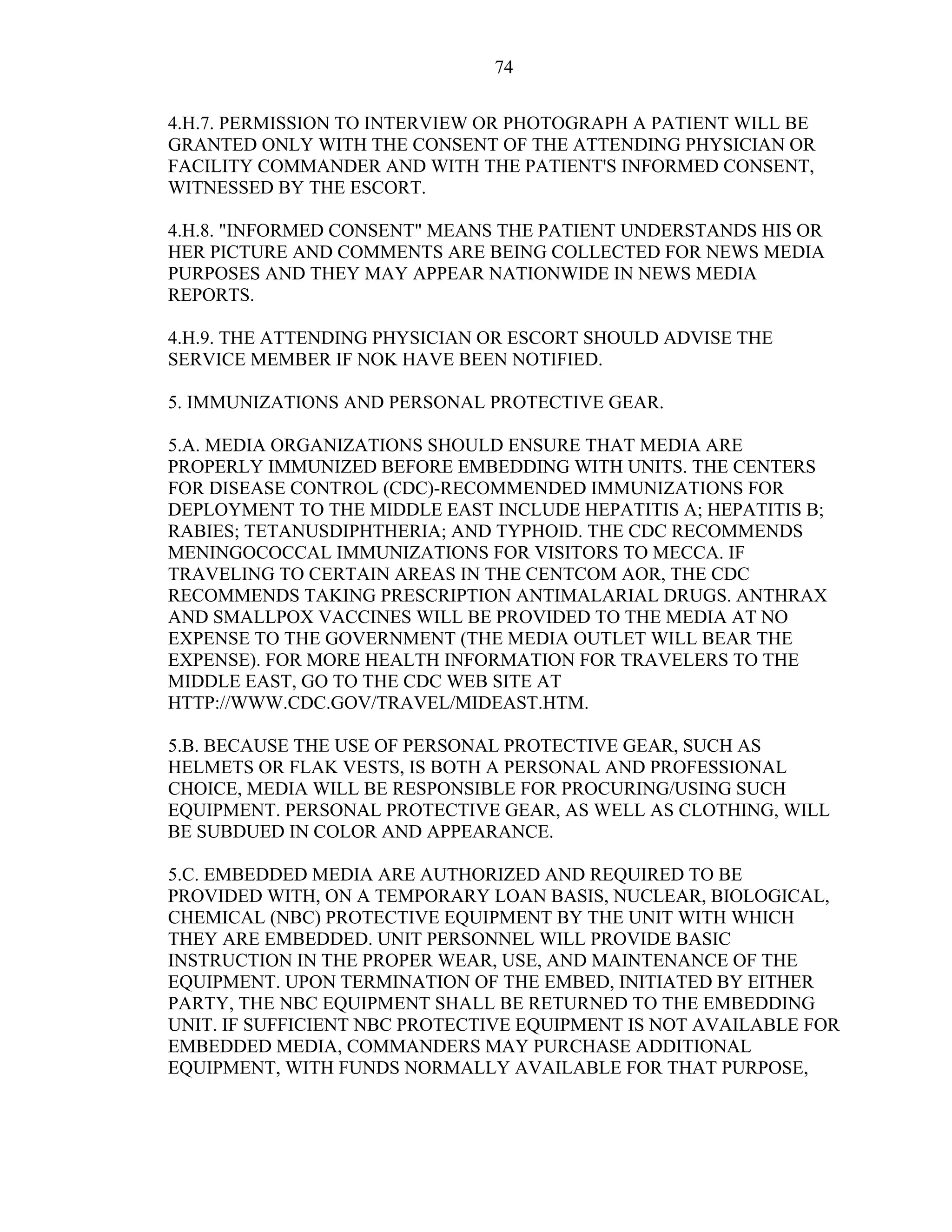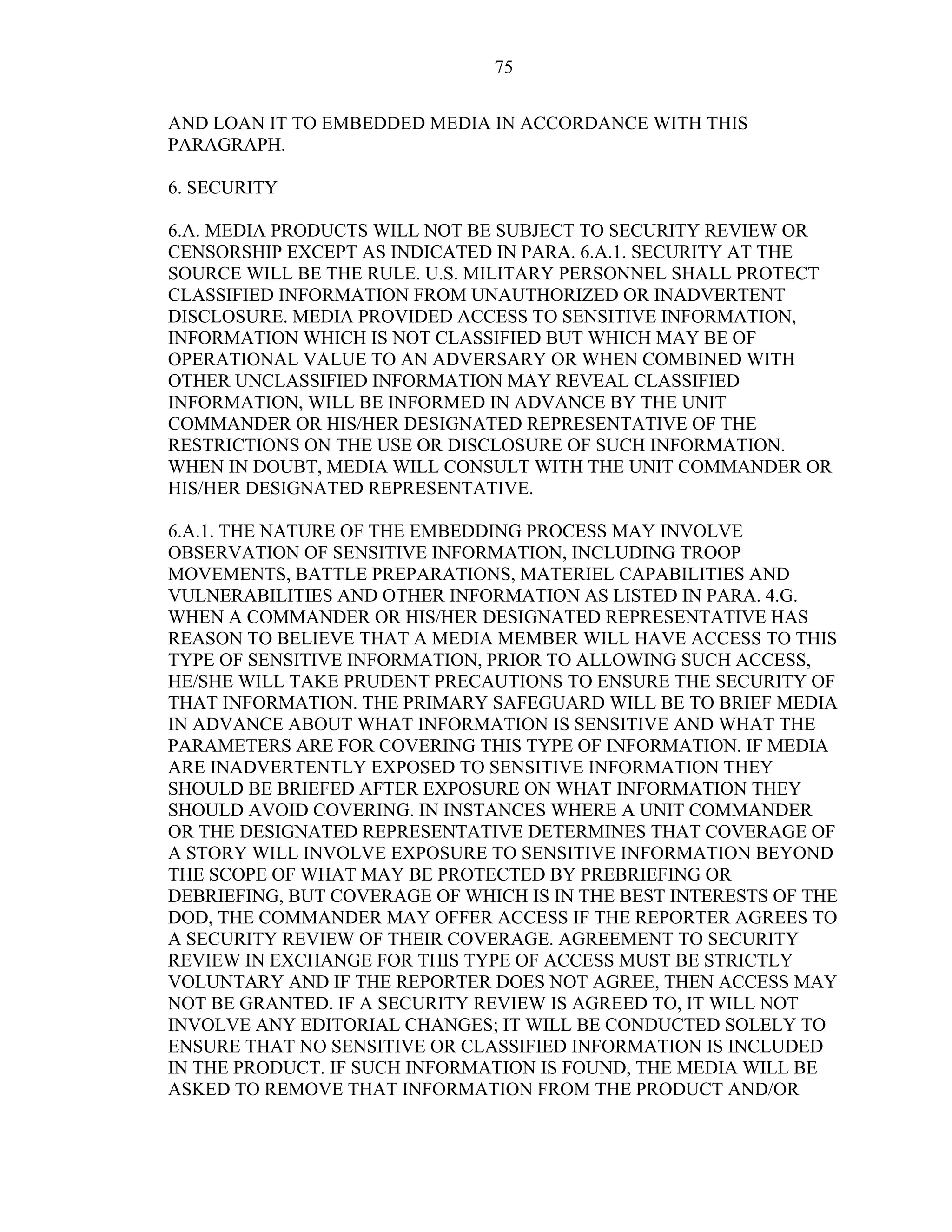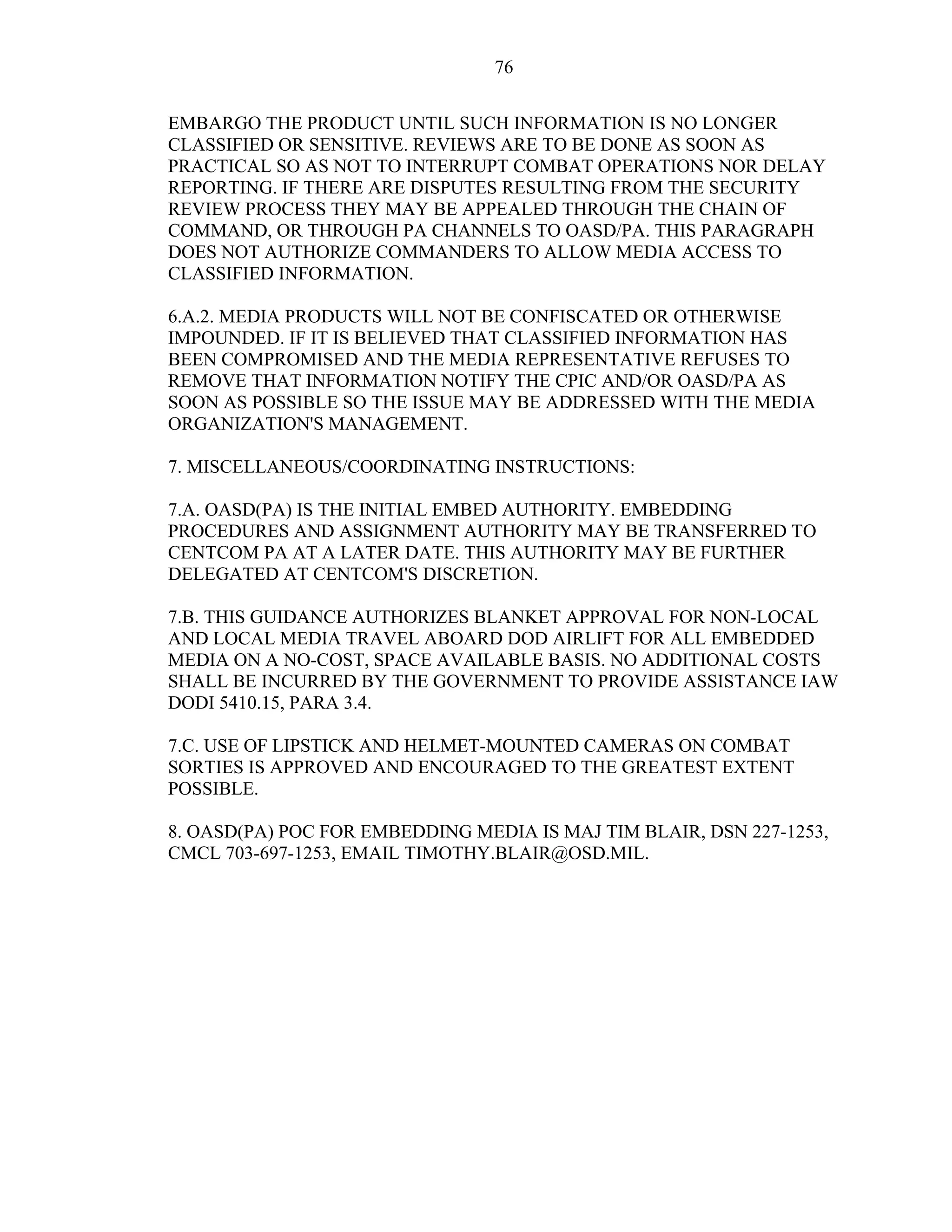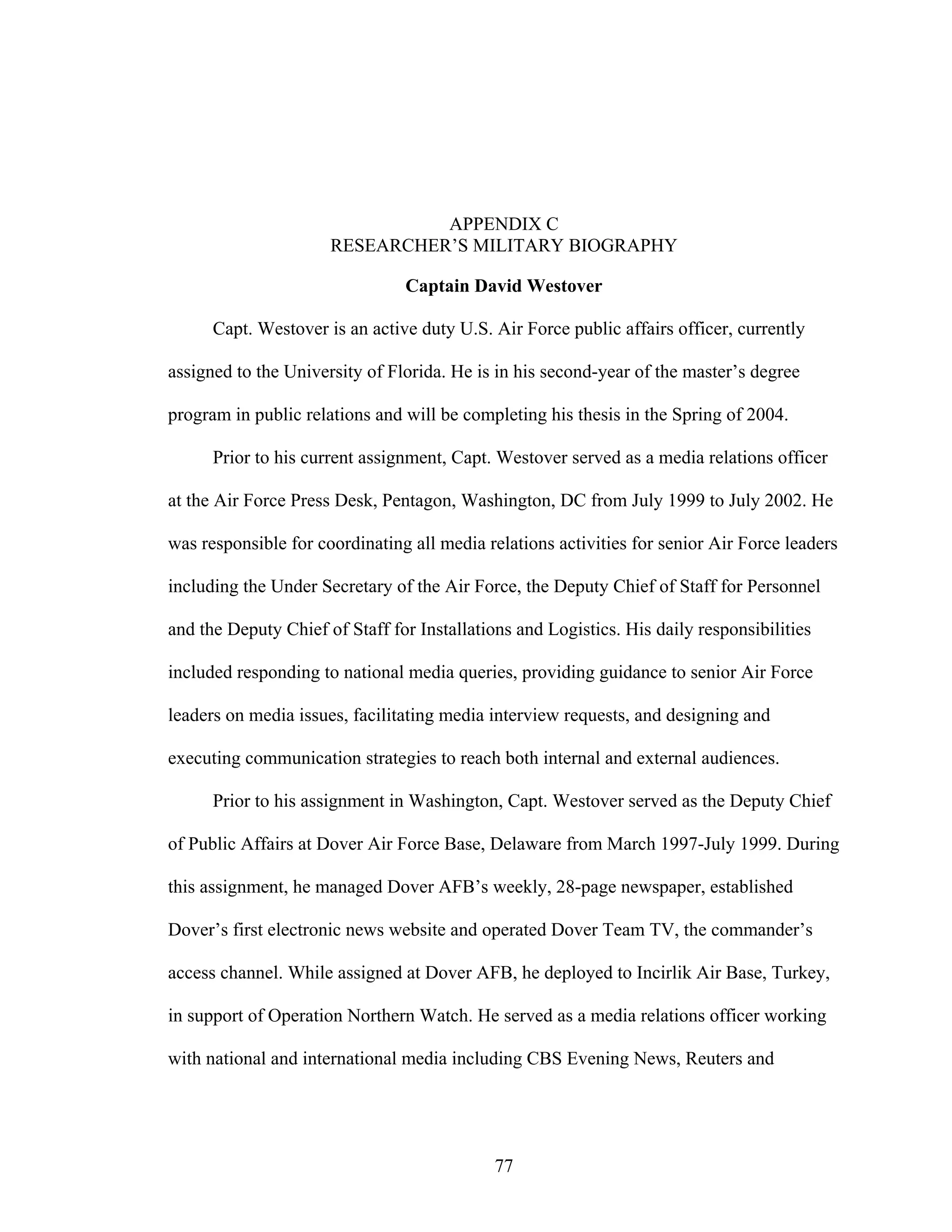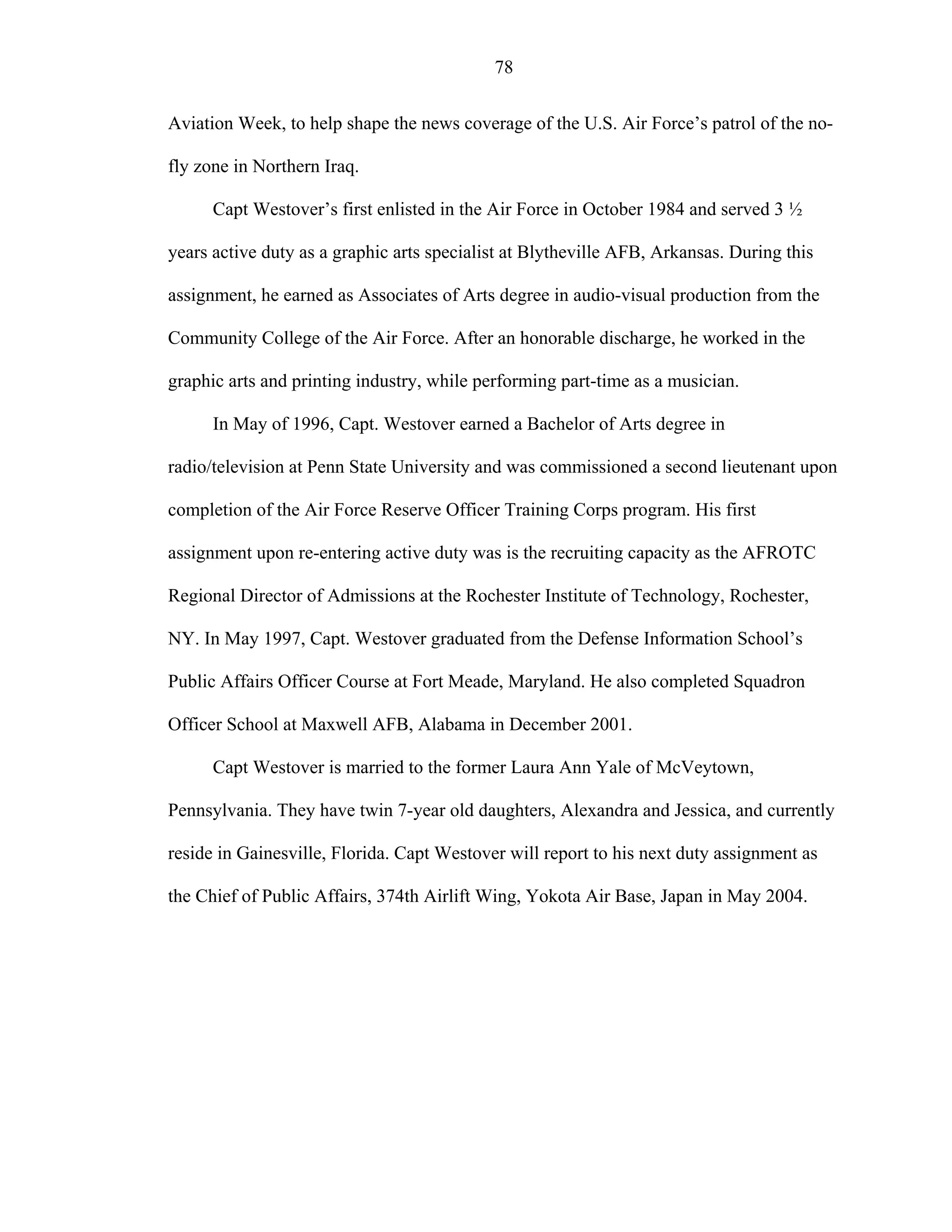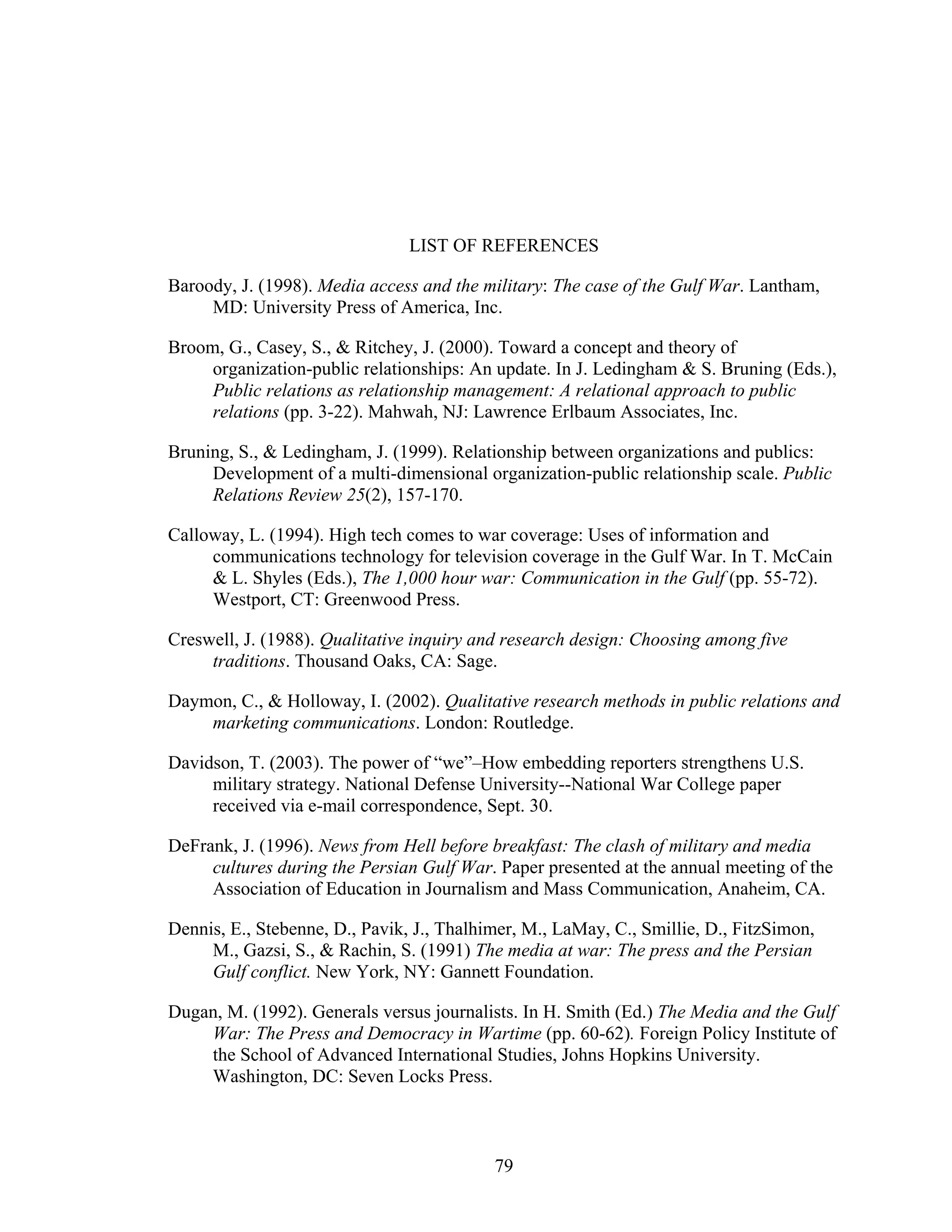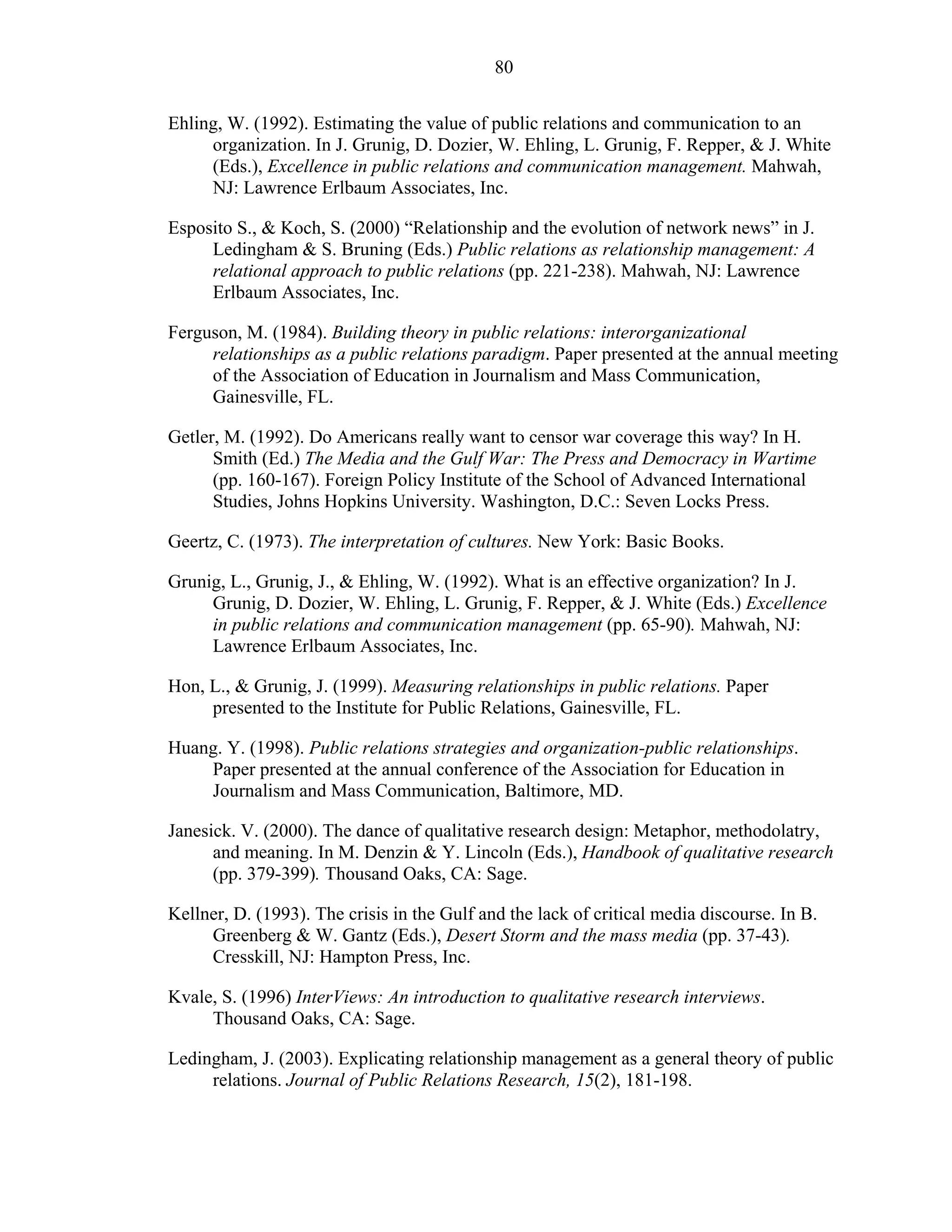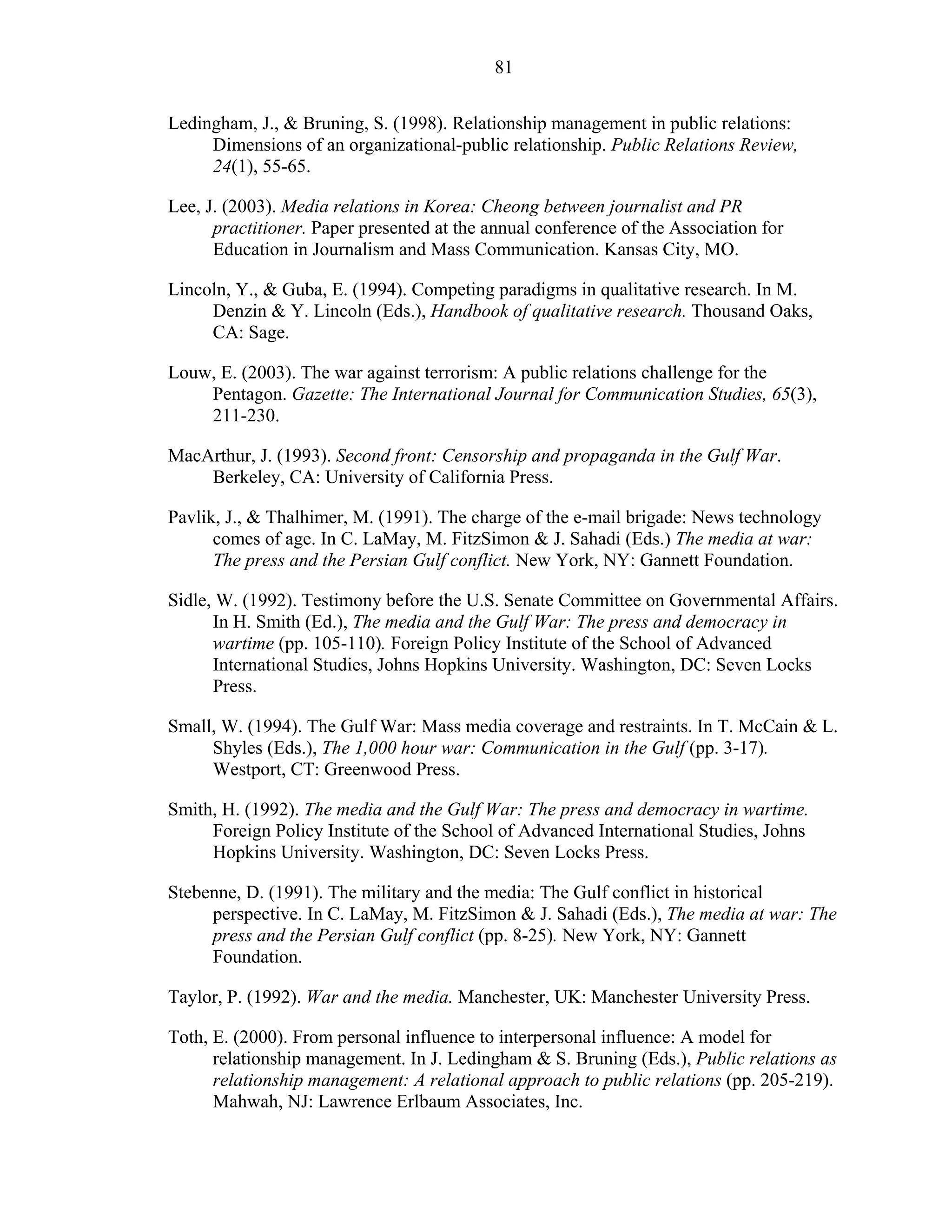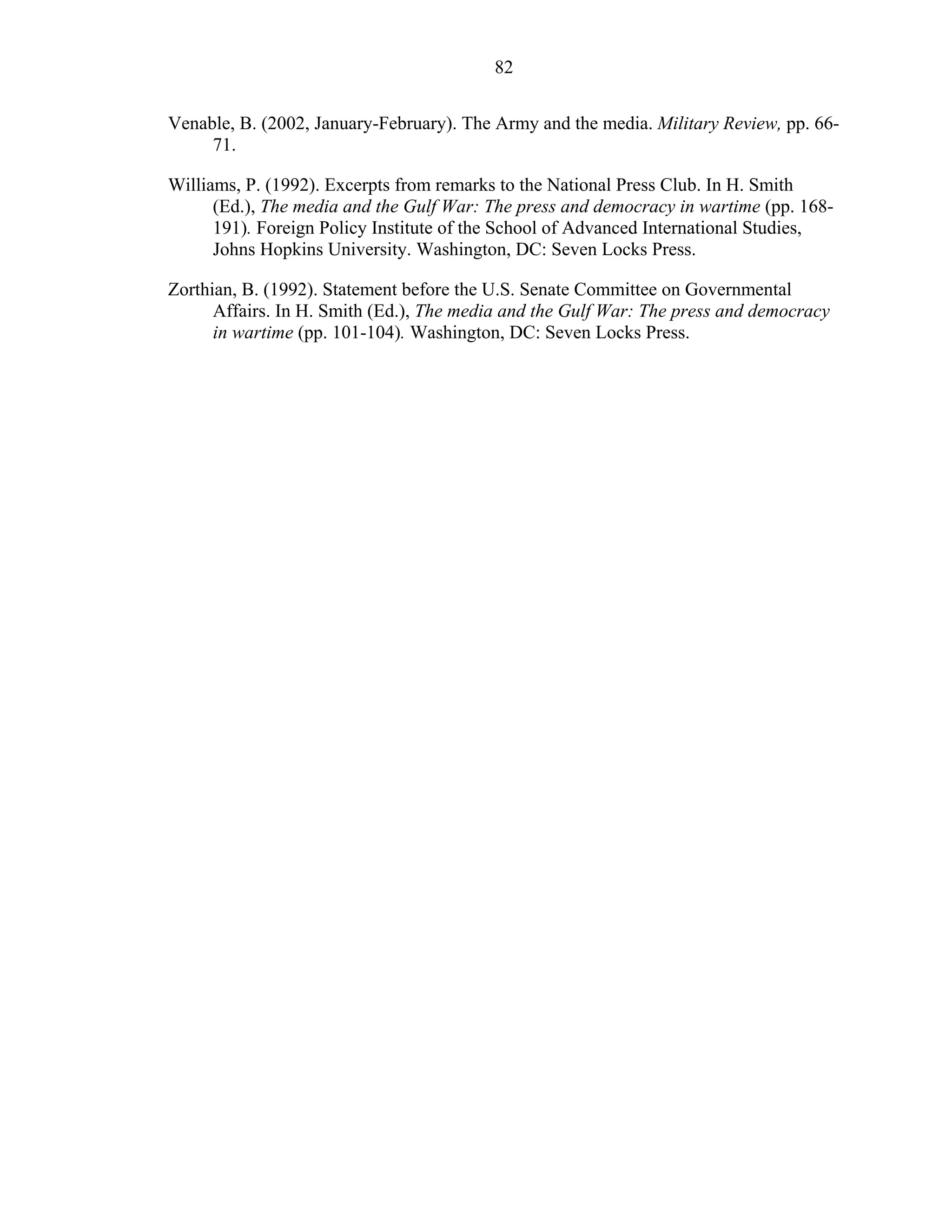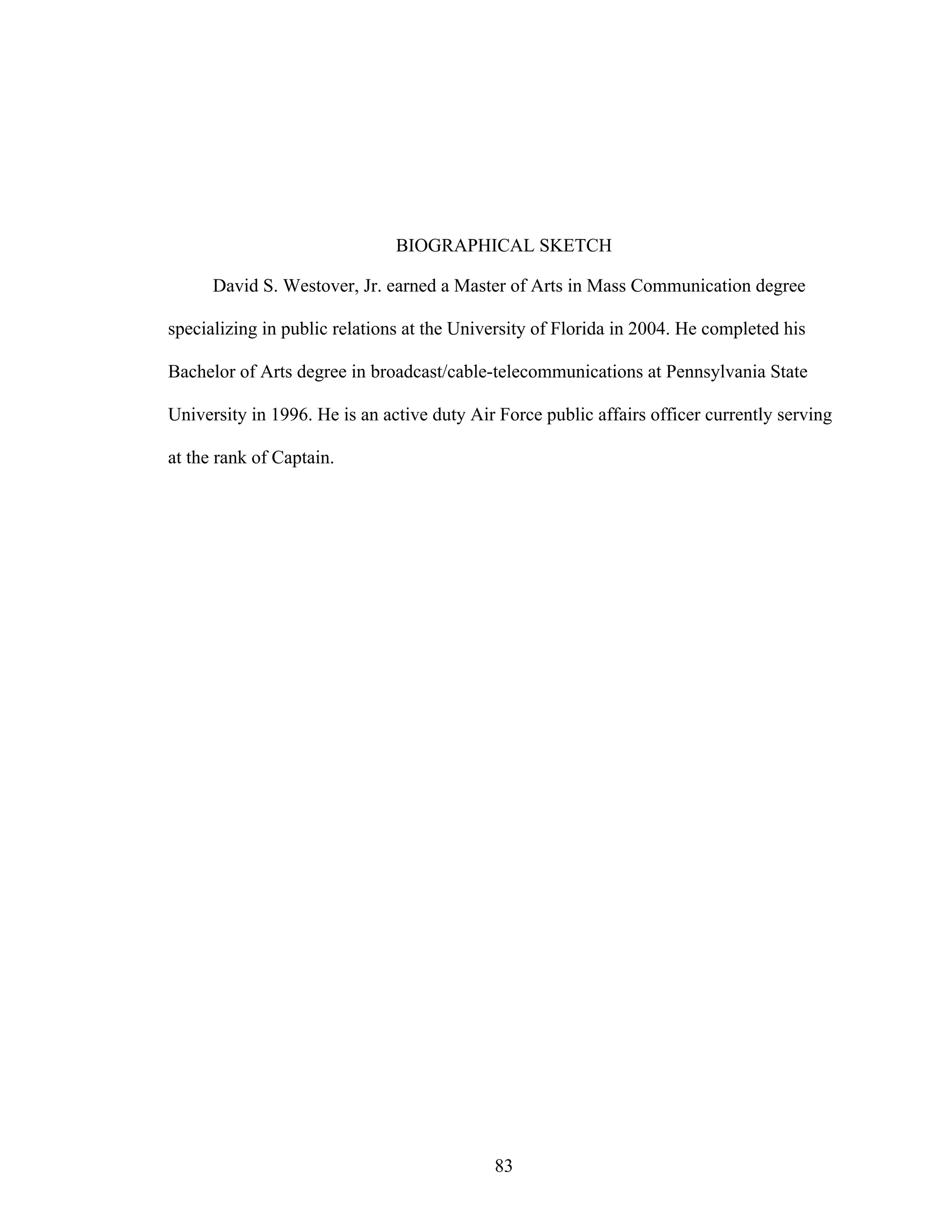This document provides an overview of military-media relations leading up to the 2003 Iraq War, focusing on the period after the 1991 Gulf War. It discusses how the negative experiences of the Vietnam War continued to impact relations between the military and media. The 1984 Sidle Commission made recommendations to improve access and pooling of journalists during conflicts. However, tensions remained during the Gulf War due to differing priorities around information control between the institutions. The embedded media policy for the Iraq War represented an unprecedented change in approach that this thesis aims to examine through interviews with embedded journalists and military public affairs officers.
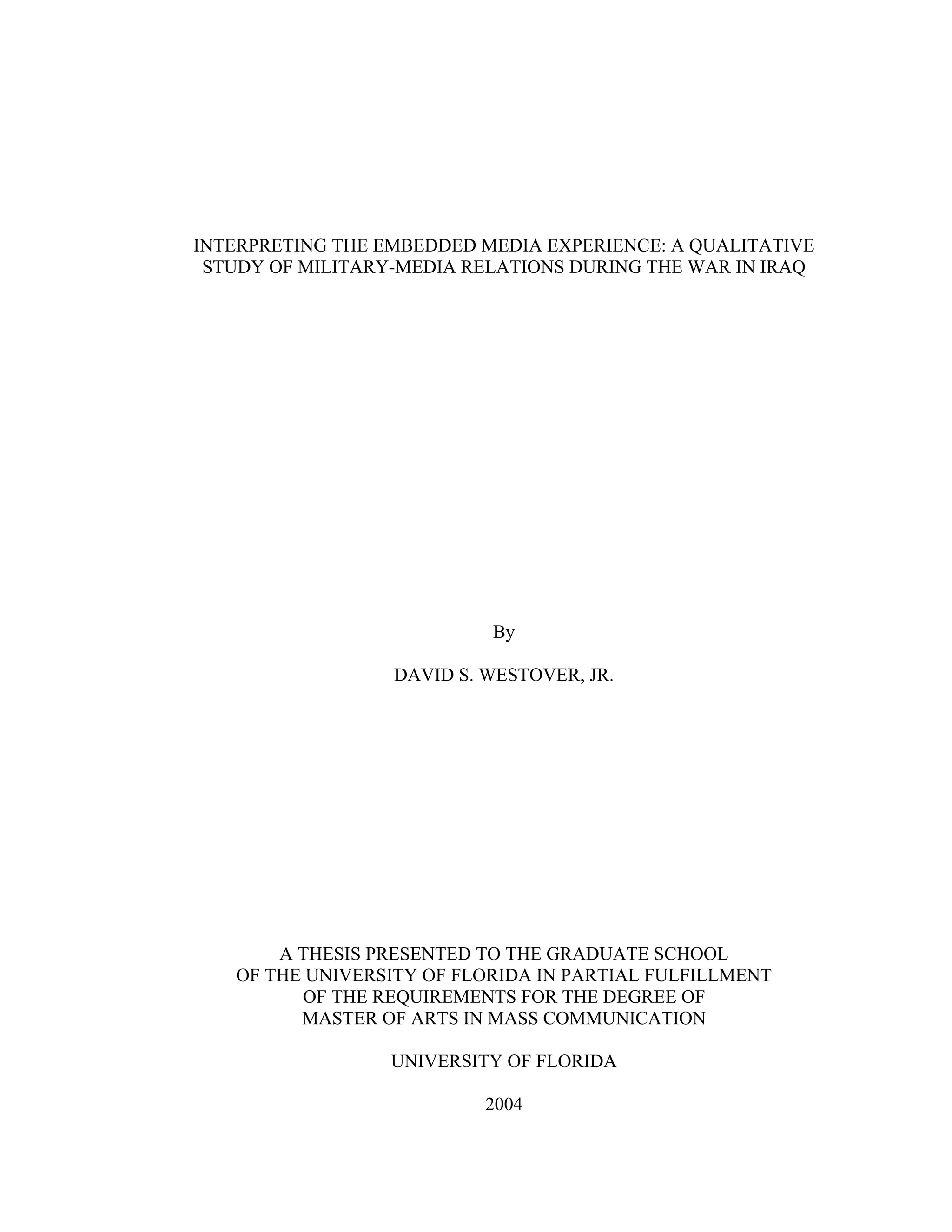
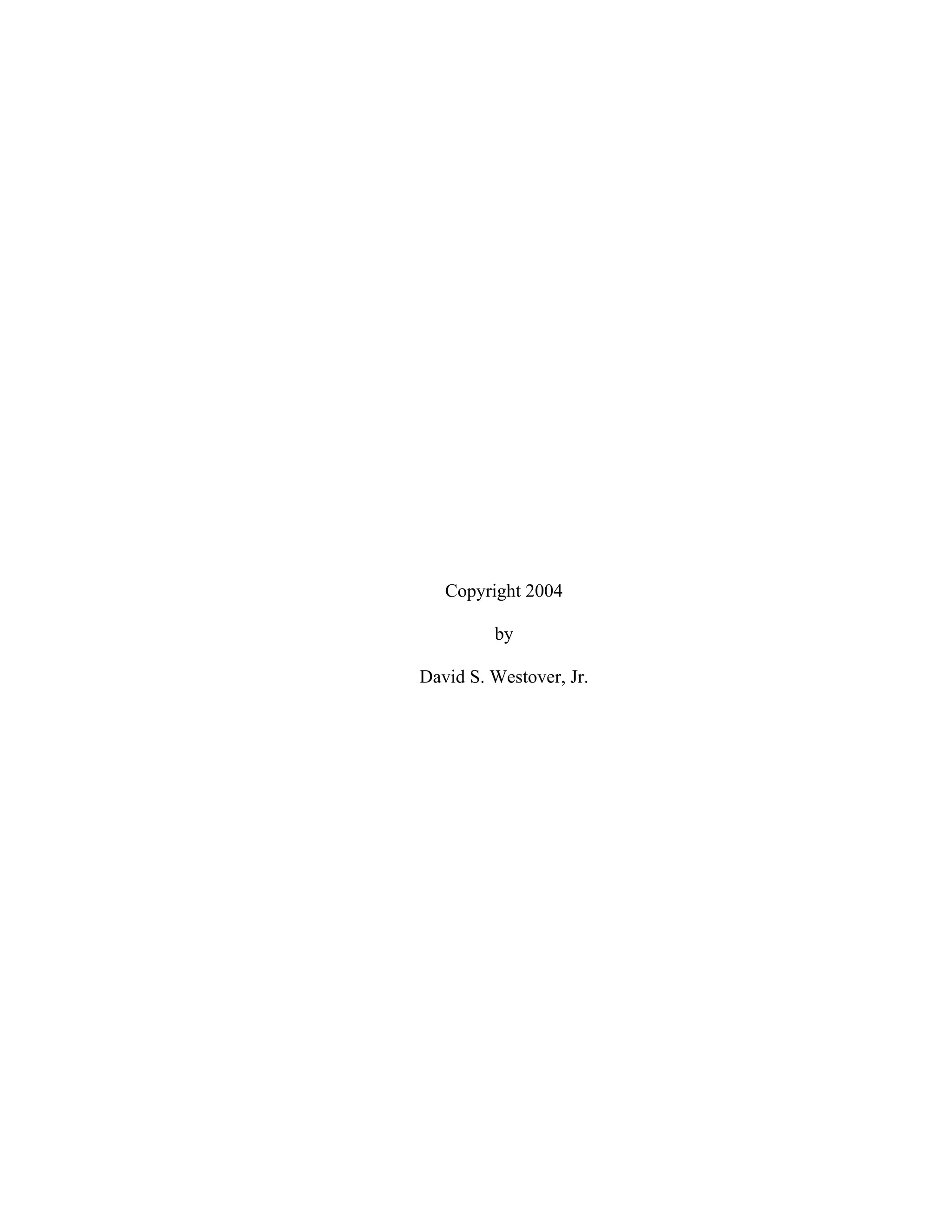
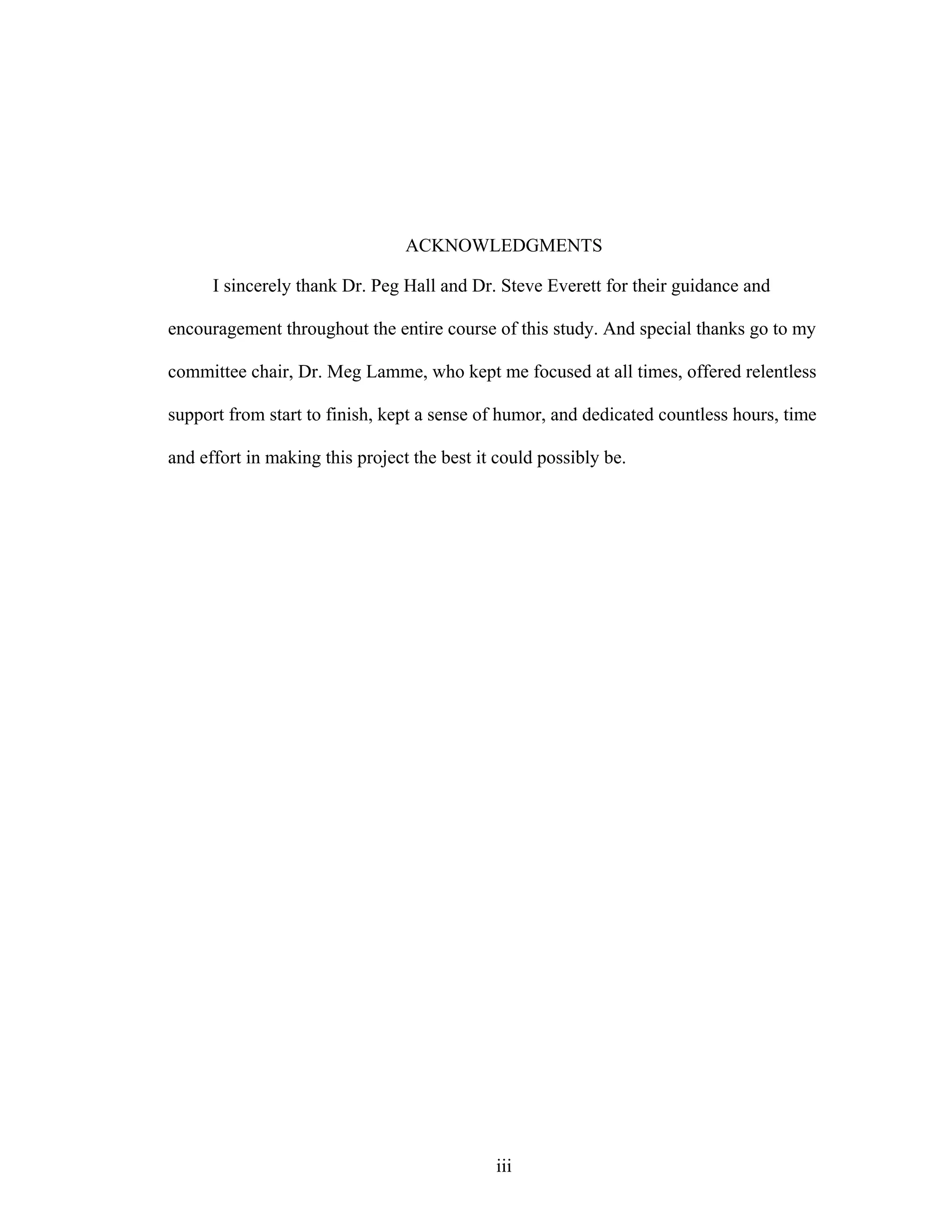
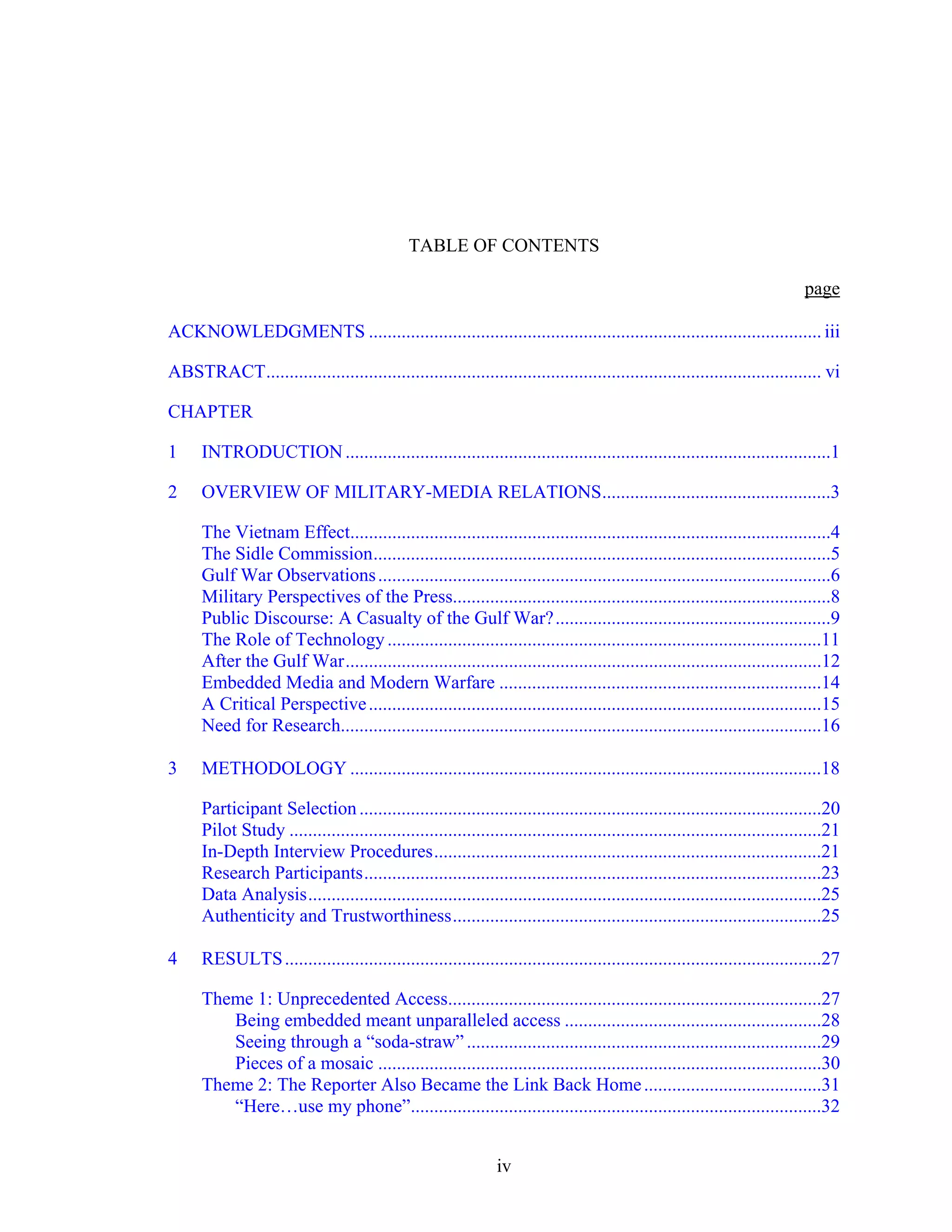
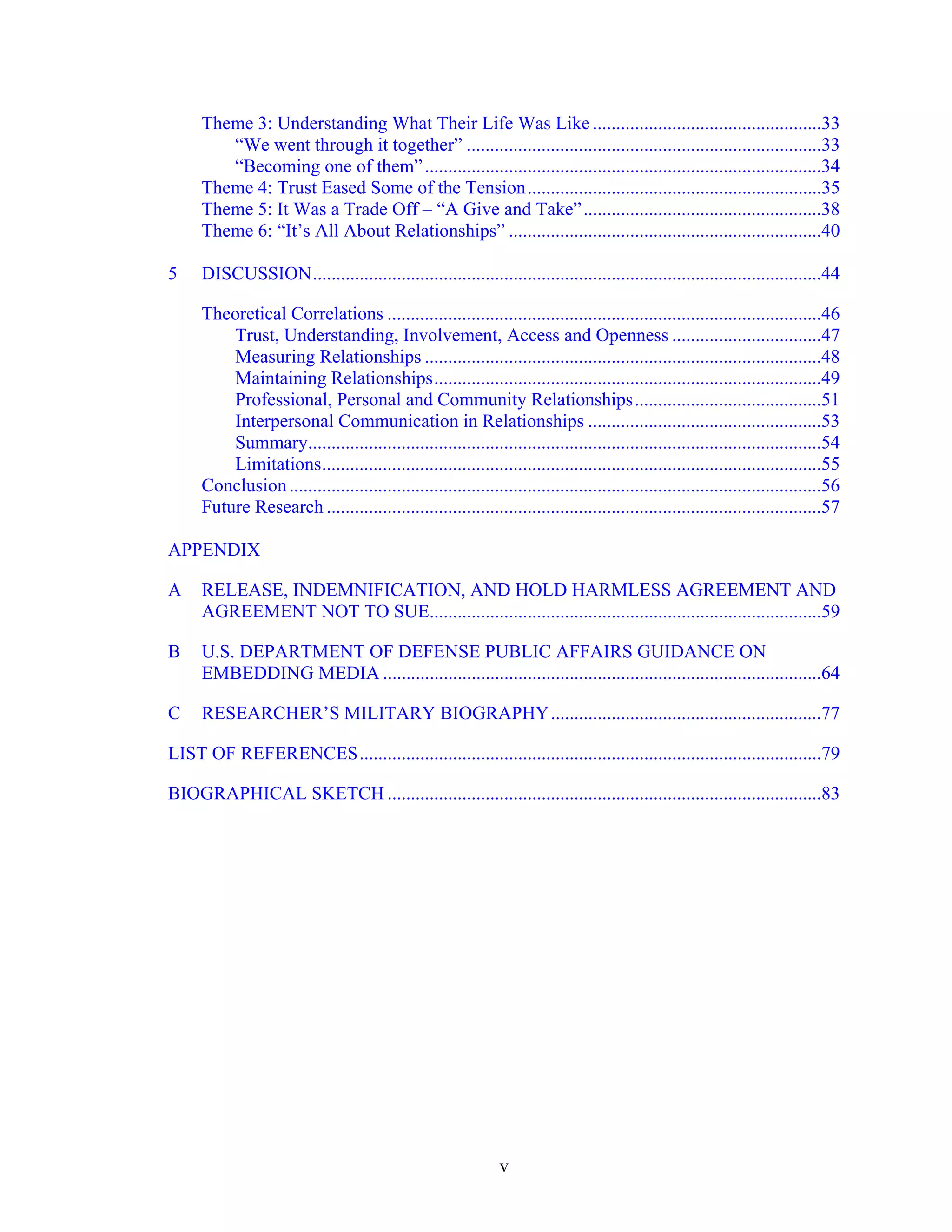
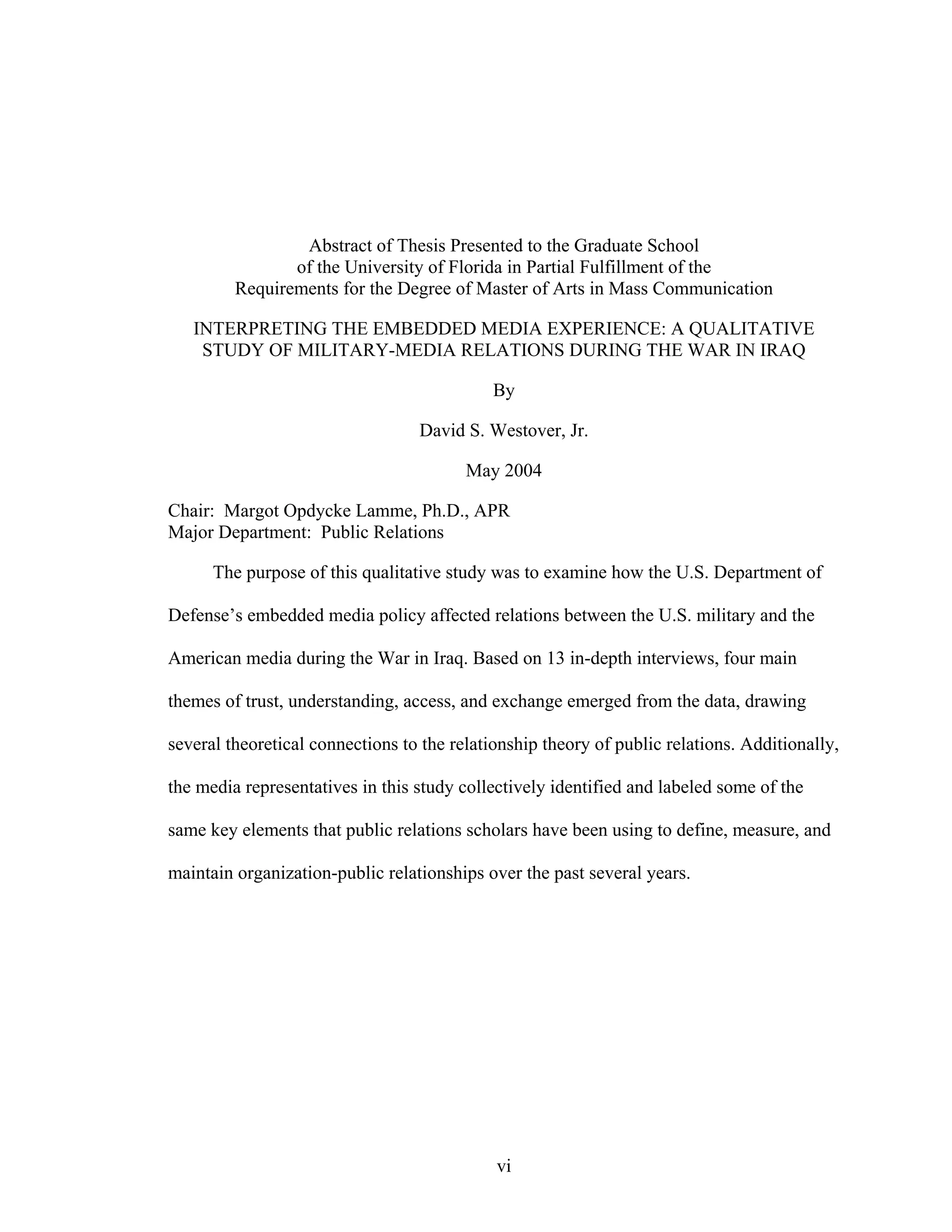
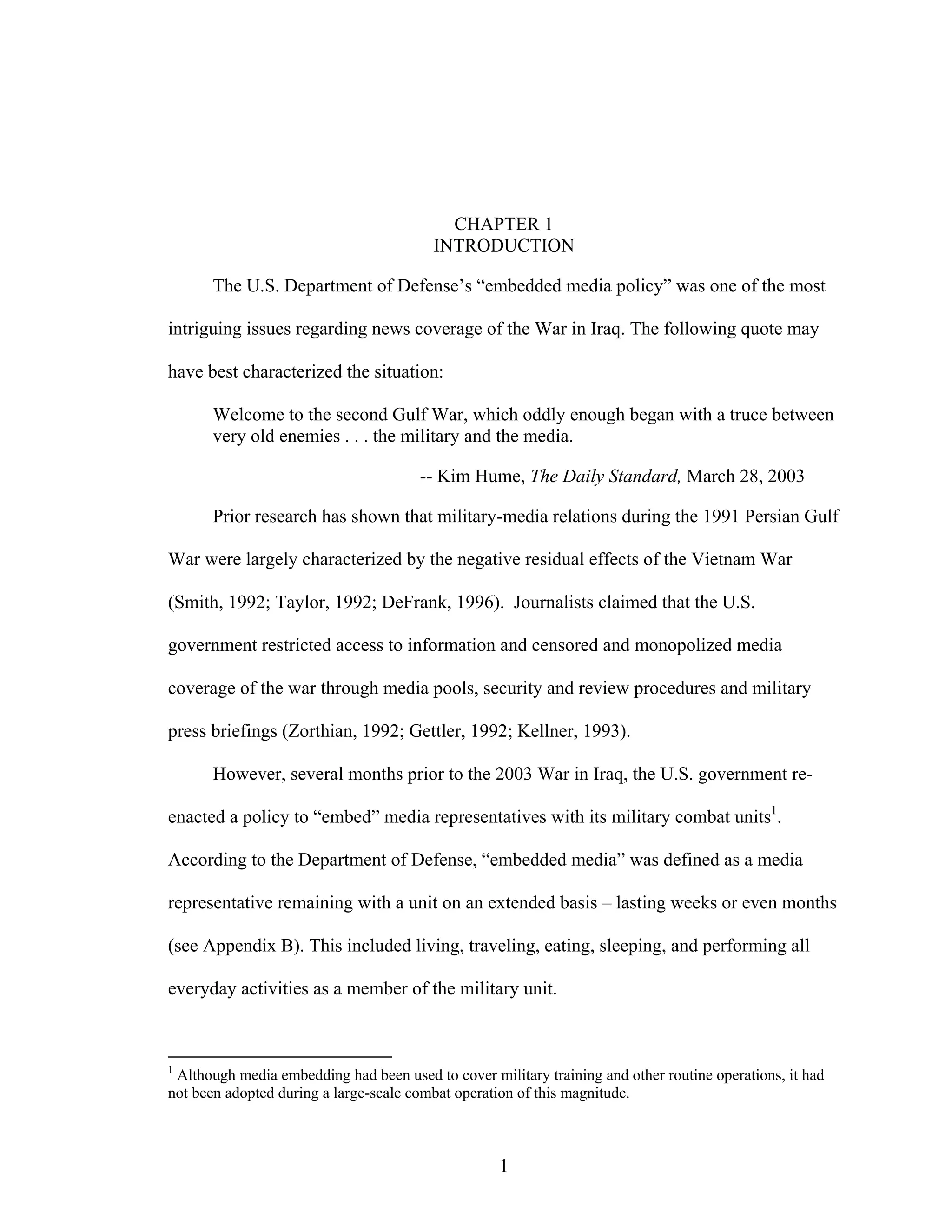
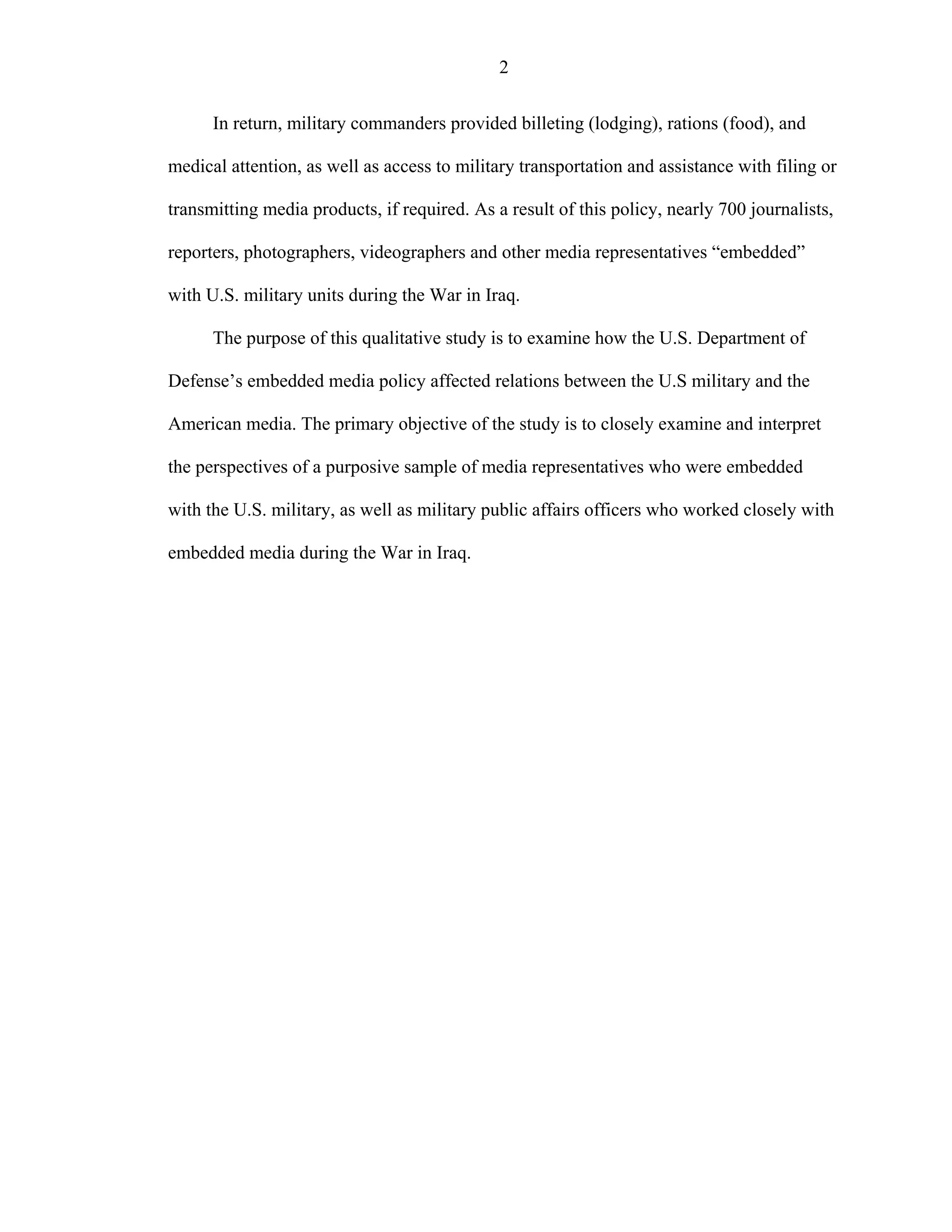

![4
DeFrank (1996) characterized the interplay between the military and the media,
especially in times of conflict:
‘War is an aberration’ (Taylor, 1992, p.8) in the normal state of
civilized affairs that by its nature is both violent and horrific. This
means that there is a fundamental need for the populace of a
democracy, those who institutionally are the ultimate decision
makers, to be kept informed on a sufficient level to make rational
decisions. Providing the information necessary to do this is a
function that is performed by an independent and often adversarial
media. Herein is the heart of an institutional conundrum, for that
very process of keeping the citizenry informed unquestionably has
the potential to increase the costs in lives if it compromises
military operations. Yet the very cloak of secrecy so crucial to
military operations also had the potential to lend itself to poor
decision making, and worse, abuse of official power and other
institutional misconduct. (p.2)
At the core of the contention between these two institutions is information, an
“organic factor,” fundamental to the nature of both the military and the media (Dugan,
1992). On one hand, the American media rely upon the First Amendment to keep the
people informed of what their government is doing. On the other hand, the military
dogmatically claims “in the interest of national security” and the protection of its men,
women, resources and strategic advantage, that sensitive and classified information
should be carefully guarded.
The Vietnam Effect
In the aftermath of the Gulf War, Zorthian alluded to Vietnam when he observed
in 1992 that “the military has established the current restrictions on the movement and
coverage by [media] correspondents to prevent the undisciplined media excesses of the
past and wants to project instead a picture of the war which will be controlled and based
largely on official sources” (p. 103).](https://image.slidesharecdn.com/f1b809f5-114d-4260-9982-5cc91e095028-170129060938/75/Interpreting_the_embedded_media_experience-1-10-2048.jpg)
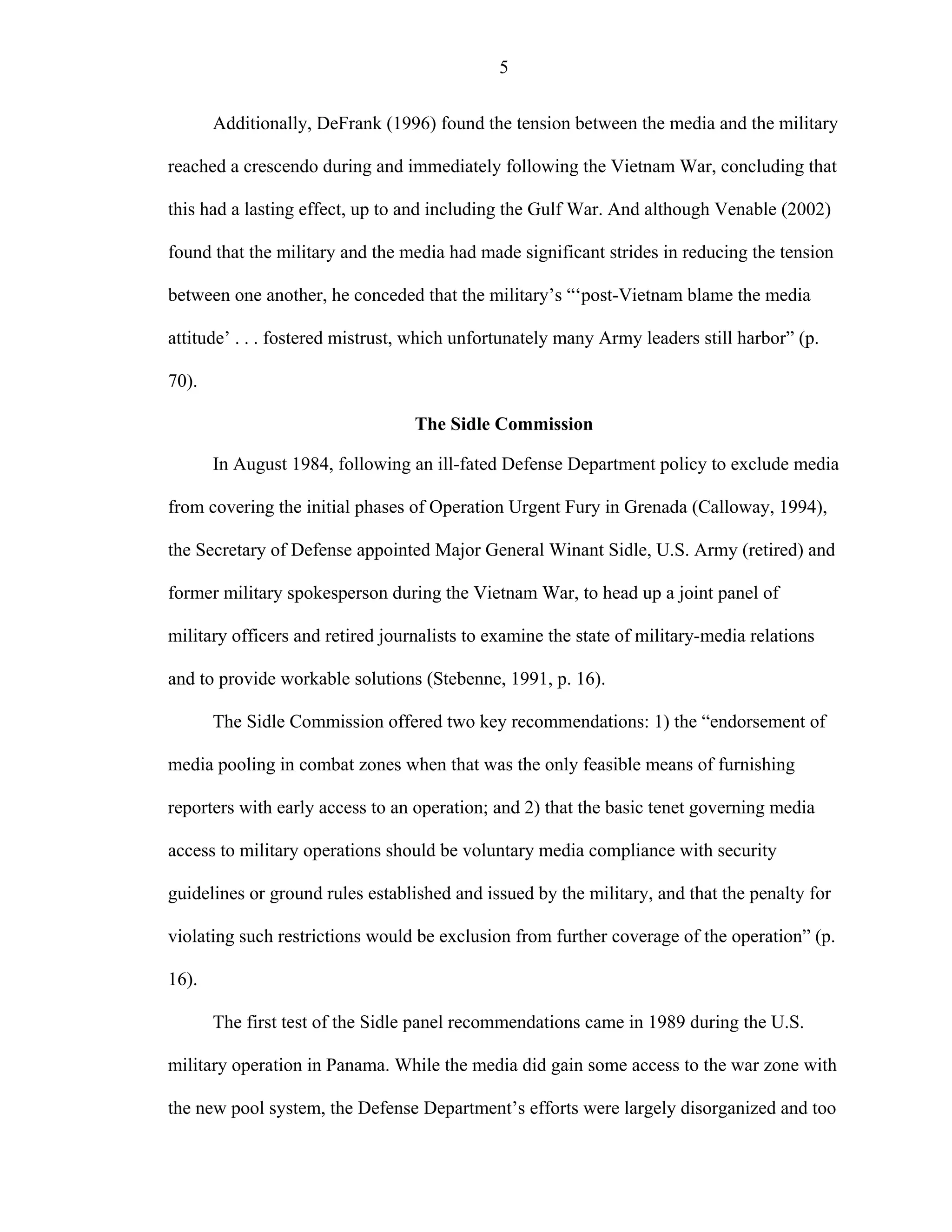
![6
slow (Stebenne, 1991). Additionally, because the conflict was very brief, it did not
provide a real test of the panel recommendations, although the Department of Defense
(DOD) “promised to handle any future military operations properly” (p. 16).
As the Gulf War neared, Sidle testified before the U.S. Senate Committee on
Governmental Affairs, explaining that the military and the media don’t realize the extent
of their mutually beneficial relationship. “The military is funded by taxpayer dollars,
[who] have a right to know what the military is doing . . . [and] the only way for the
military to both inform the taxpayers and to get credit for doing a good job is through the
news media” (Sidle, 1992, p. 106). Additionally, Sidle concluded that this even applies to
the handling of sensitive information. While the media must be prudent, the military
should provide them “all possible information that will not be of real value to the enemy
and/or endanger troop safety” (p. 106).
Gulf War Observations
Still, as DeFrank observed in 1996, Vietnam was a “formative period for a crop of
senior officers who conducted the Gulf War . . . their influence and attitudes to a large
extent colored the opinions toward the media of their subordinates” (p.11). Thus it is not
surprising that in personal accounts of journalists and public affairs officers (PAOs)
during the Gulf War, the relationship between the media and the military reflected the
clash between the fundamental ideals of each institution (Smith, 1992; Taylor, 1992;
Dugan, 1992). In fact, Zorthian (1992) found that a struggle between the military and the
media emerged over three principal points of contention: an escort requirement for all
journalists, the media pool system, and the pre-transmission review of copy.
Getler (1992), on the other hand, finding during the Gulf War that “the Pentagon
and the U.S. Army Central Command conducted what is probably the most thorough and](https://image.slidesharecdn.com/f1b809f5-114d-4260-9982-5cc91e095028-170129060938/75/Interpreting_the_embedded_media_experience-1-12-2048.jpg)
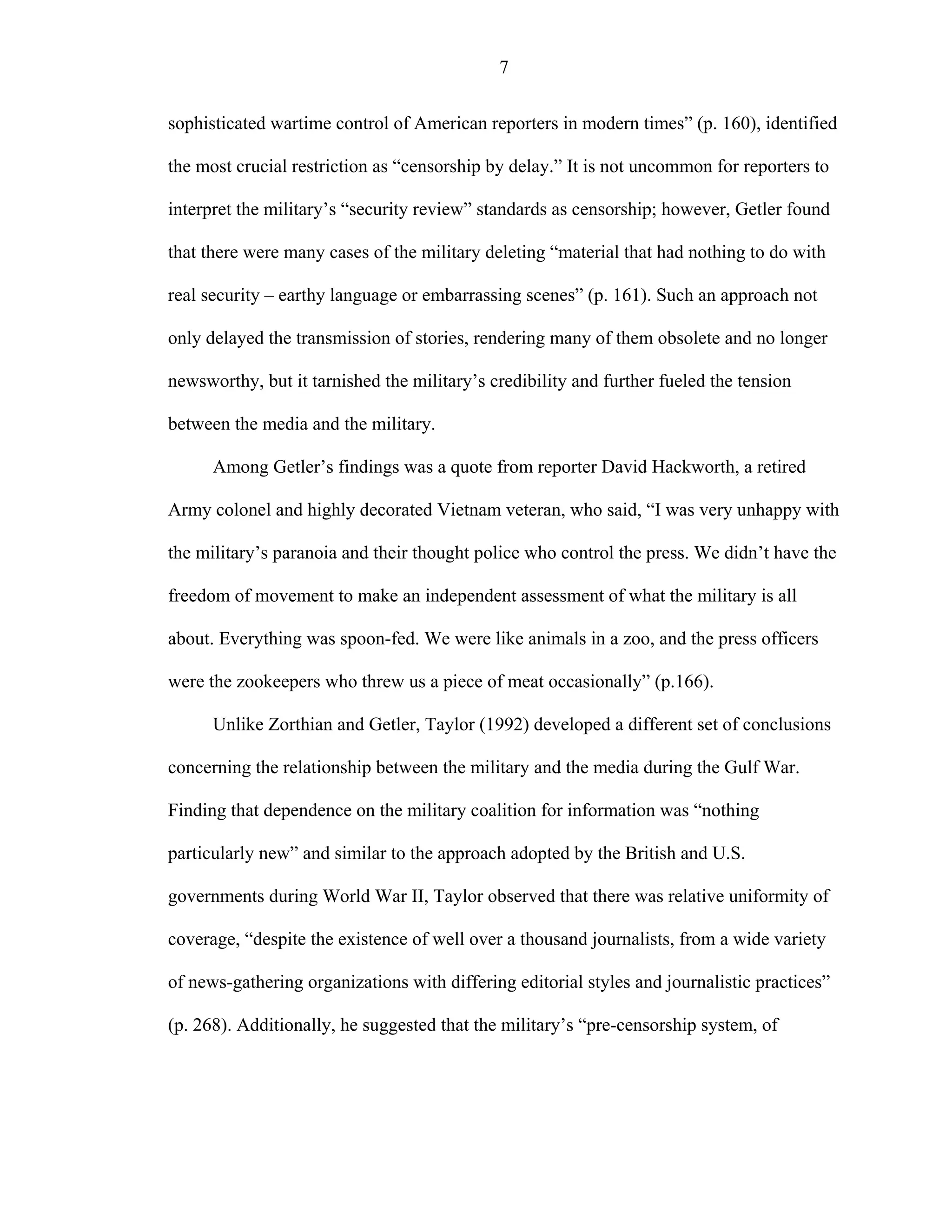
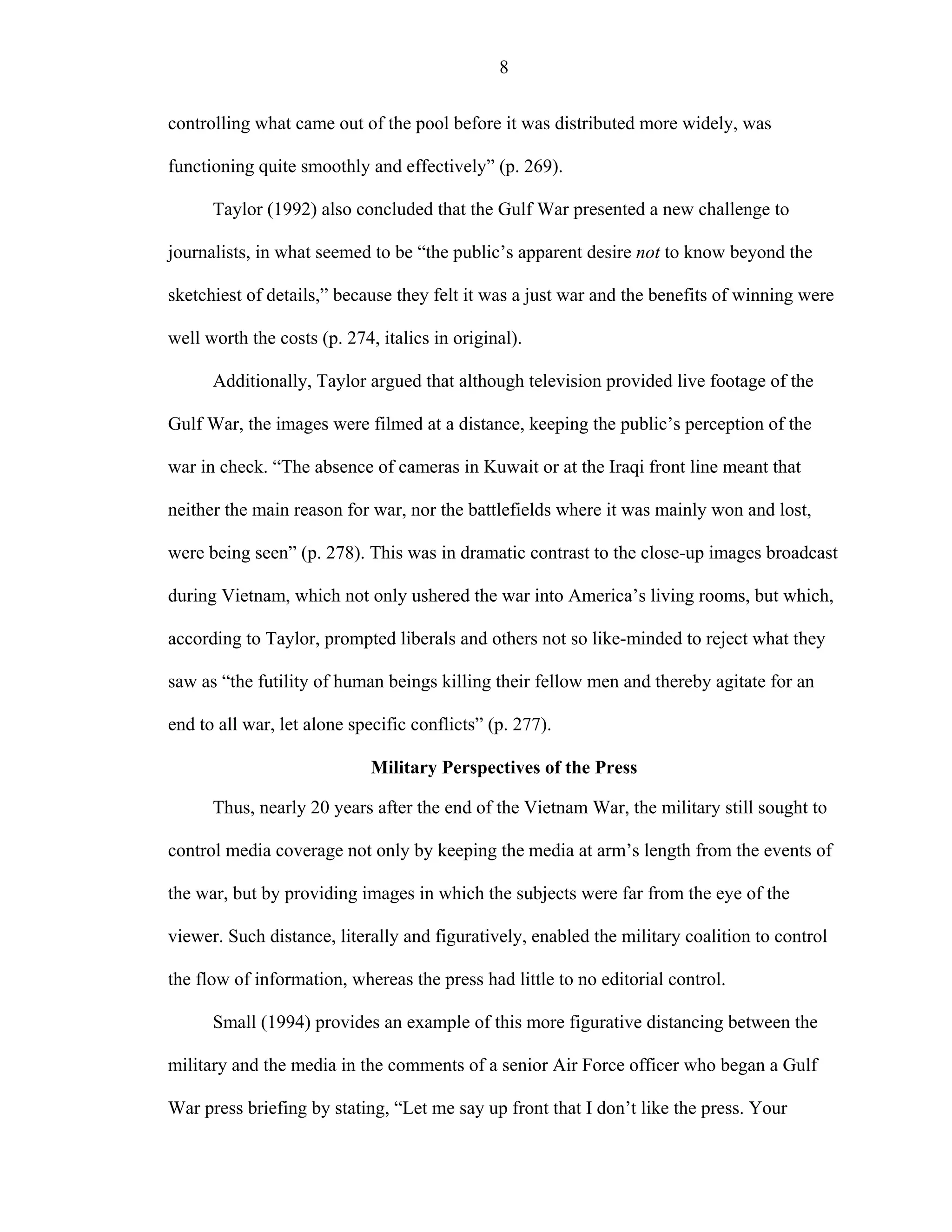
![9
presence here can’t possibly do me any good, and it can hurt me and my people . . . that’s
just so you’ll know where we stand with each other” (p.5).
Another example is provided by Pete Williams, the Assistant Secretary of Defense
for Public Affairs during the Gulf War, who, in his remarks to the National Press Club
defended the DOD media policies during the conflict. “While the Saudi government
studied whether to grant visas to journalists, they agreed to accept a pool of U.S. reporters
if the U.S. military would get them in. And we did that: we activated the DOD national
media pool because at the time there was no other way to get Western reporters into
Saudi Arabia” (Williams, 1992, p. 171). The irony is that while the press bristled at the
idea of pooling and perceived it as a tool for controlling them and keeping them from the
story, the military in fact was only implementing a key recommendation of the 1984
Sidle Commission in an attempt to provide some mutual benefit between the military and
the media.
Alluding to the fact that the very geography of the war required a new kind of
media relations strategy, Williams (1992) also observed that “this was not an operation in
which reporters could ride around in jeeps [sic] going from one part of the front to
another or like Vietnam, where reporters could hop a helicopter to specific points of
action” (p.174). Once again, then, the traditional tension between the military and the
media arose in the form of access versus security and safety.
Public Discourse: A Casualty of the Gulf War?
In evaluating the implications of these policies after the Gulf War, Small (1994)
concluded that while “the big loser was Saddam Hussein . . . the other loser was
traditional American journalism, which . . . while not surrendering its First Amendment
function, independent reporting, found that function seriously compromised” (p. 3).](https://image.slidesharecdn.com/f1b809f5-114d-4260-9982-5cc91e095028-170129060938/75/Interpreting_the_embedded_media_experience-1-15-2048.jpg)
![10
Small (1994) argued that informed public opinion was a casualty of these policies
as well, when he cited a Princeton Survey Research Associates poll for the Times-Mirror
Company that reported that “more than three-fourths (76%) of Americans knew that Gulf
[War] news was being censored by the American military and a larger number (79%)
thought that was a good idea.” Similar to Taylor’s observation of the public’s desire to
not know, Small concluded that Americans “seemed perfectly happy with the news it
[sic] got, even if it felt that the media was being spoon-fed by the military” (p. 4).
Kellner (1993) also found the demise of journalism to be a casualty of these
policies. Even prior to the war, “mainstream media served as a mouthpiece and
amplifier” for the U.S. government, and then during the war, the military punished
critical reporters, refusing them “access to top military brass . . . while compliant
reporters were rewarded with pool assignments and interviews” (p. 37, 43).
On the other hand, Mortimer Zuckerman, the owner of U.S. News and World
Report, was one of the few in the media who were satisfied with the military press
relations during the Gulf War. According to Small (1994), Zuckerman told advertising
firm Ogilvy & Mather that he was “astonished by the availability and the access that we
have had both to the Pentagon and to the information we feel we needed to cover and
report the war. The press, in my judgment, seems petulant, self-concerned, self-centered
and really downright silly, particularly when you compare the rather mature intelligence
of some of the military briefers compared to the stupidity of some of the questioners.” He
concluded that, “we’re not just journalists; we’re also Americans” (p.7).
Like Zuckerman, Time Magazine’s Jay Peterzell said (in MacArthur, 1993) that
while “the pool concept has received a lot of criticism, and [while] much of it is justified,](https://image.slidesharecdn.com/f1b809f5-114d-4260-9982-5cc91e095028-170129060938/75/Interpreting_the_embedded_media_experience-1-16-2048.jpg)
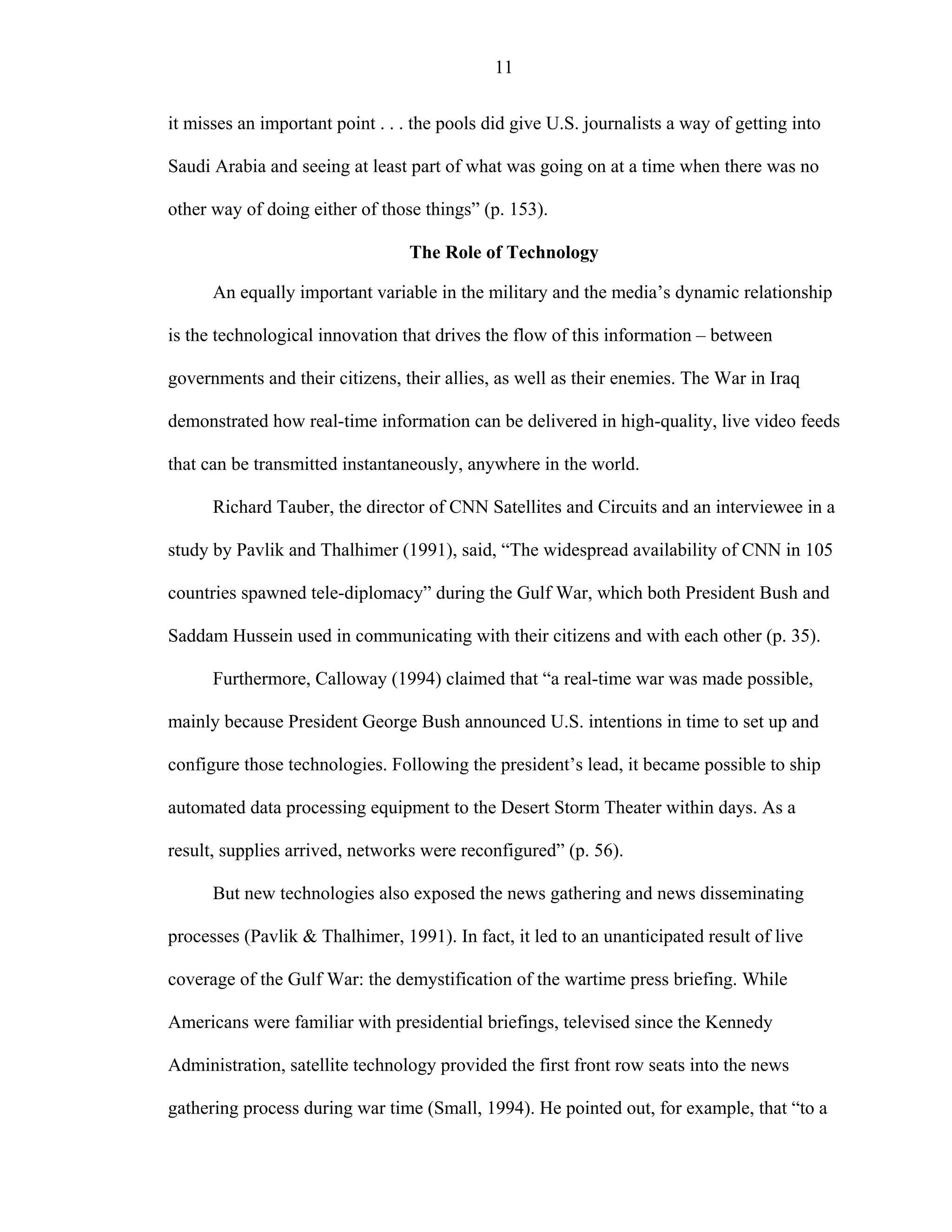
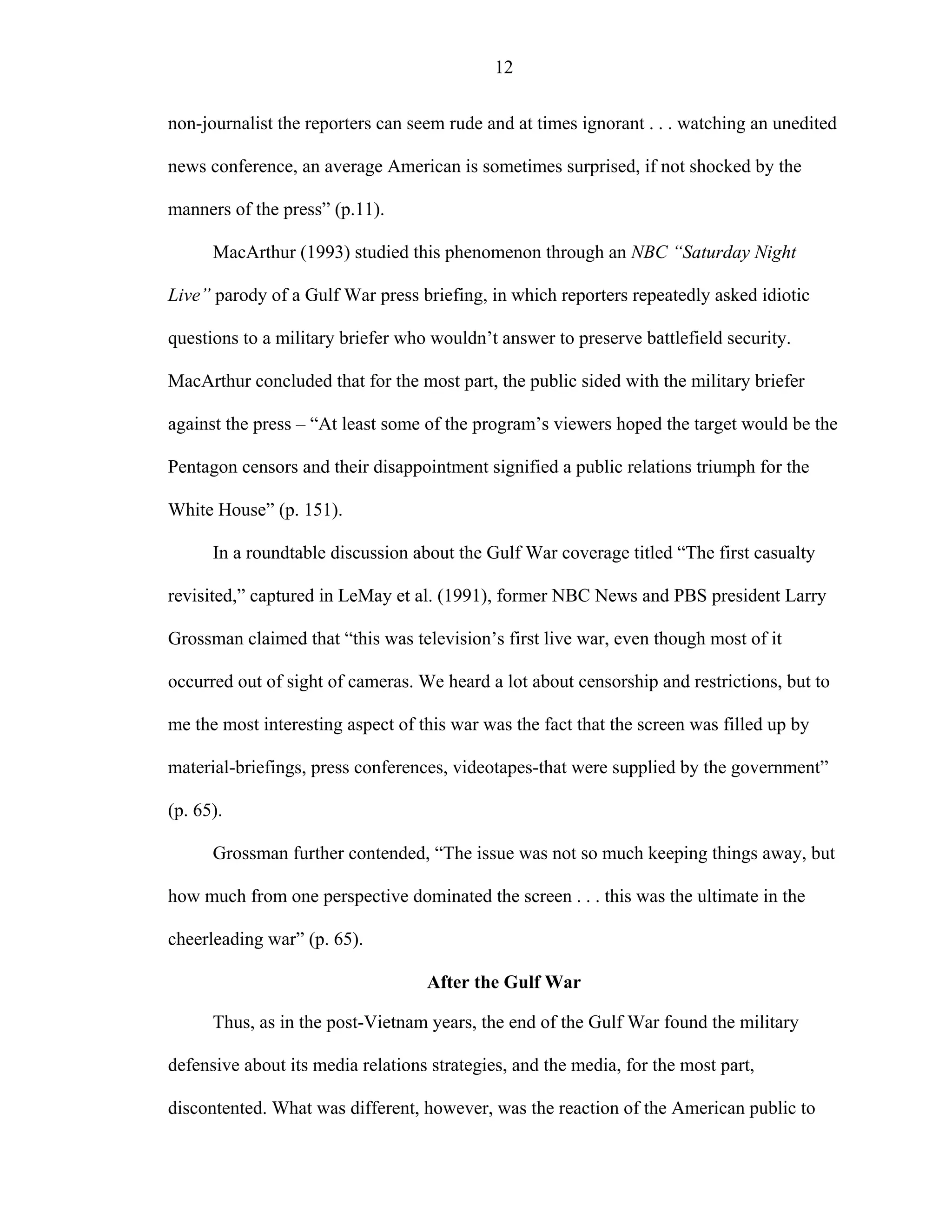
![13
the coverage. Whereas public opinion became inflamed against Vietnam, it ranged from
complacent to pro-war during the Gulf War. In fact, Small (1994) concluded that “the
success of the Pentagon, and the fact that the public at large has lost interest, mitigate
against any change in policy. Indeed, an administration, having learned how it could
contain the press, is not likely to overlook that lesson either in future international
conflicts or domestic political ones. The battle for a free press never ends. The
battleground, thanks to the events of early 1991, make [sic] it more difficult than ever for
the press to prevail” (p. 17).
Thus, it appears that the U.S. military was successful, not only in containing
Saddam Hussein, but also in employing a media relations policy that fulfilled its own
objectives, while exhibiting little regard for the needs and desires of the press.
As a result of strong criticisms from news organization leaders about how the
military handled the media during the Gulf War, the Department of Defense again made
an effort to improve the current situation, as it had done with the Sidle Commission in
1984. The Pentagon convened with news organizations to produce the DOD Principles
for News Media Coverage of DOD Operations (Venable, 2002). “While this document
highlighted concepts and procedures that had been in other DOD documents for years, it
emphasized to military commanders the importance of their personal involvement in
planning for news coverage of combat operations” (p. 69).
The DOD Principles established or reinforced three basic concepts: 1) open and
independent reporting was the standard for combat coverage for the future; 2) media
pools were to be an exception rather than the rule; and 3) voluntary compliance with
security guidelines was a condition of access to U.S. military forces.](https://image.slidesharecdn.com/f1b809f5-114d-4260-9982-5cc91e095028-170129060938/75/Interpreting_the_embedded_media_experience-1-19-2048.jpg)
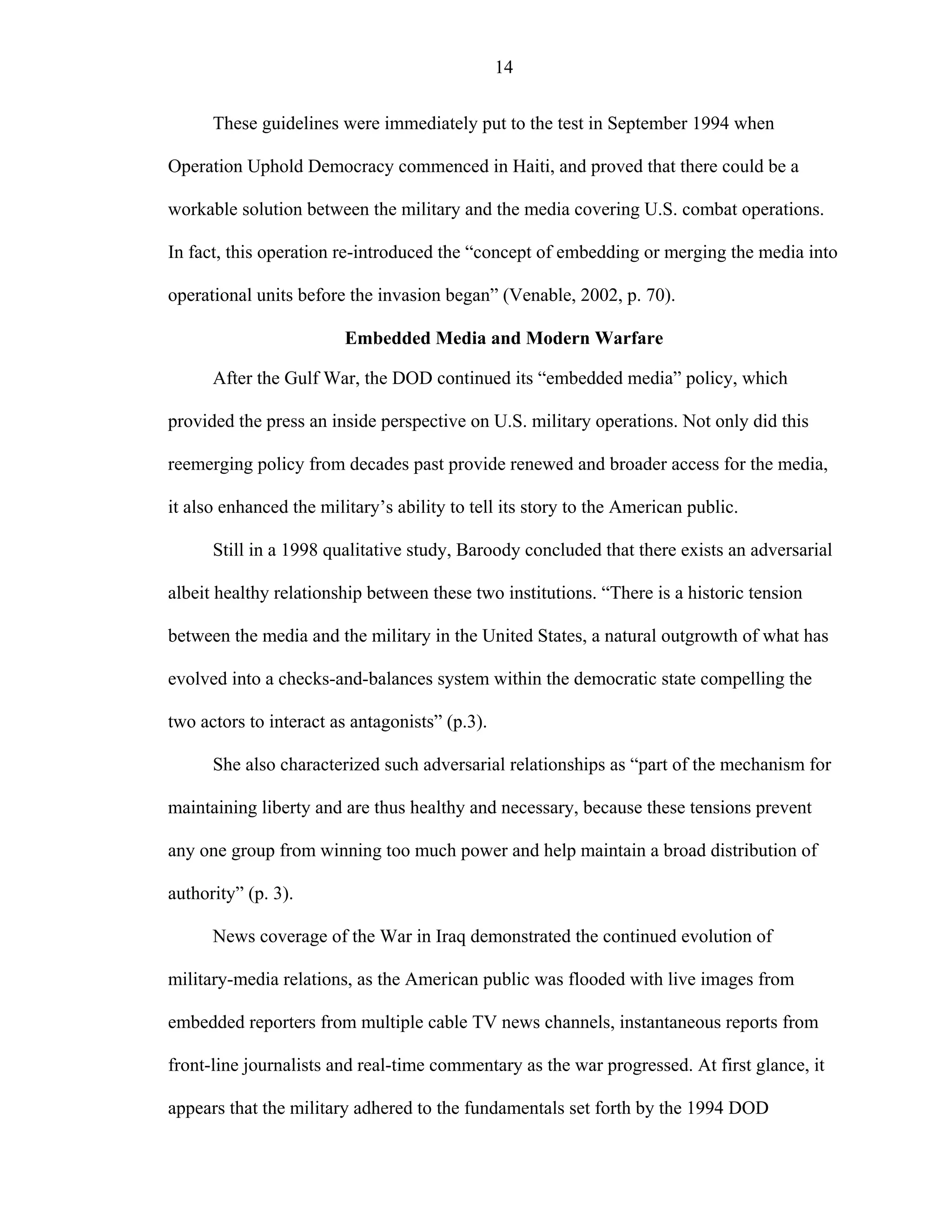
![15
principles for media coverage of military operations, which resulted from the harsh
criticisms following the Gulf War. And although the basic principle of embedding media
was first employed during Operation Uphold Democracy nearly a decade before, it was
truly put to the test by the sheer magnitude of Operation Iraqi Freedom.
Coupled with the vast and perpetual innovations of information technology that have
become second nature to the citizens of most of the world’s advanced nations, media
coverage of the War in Iraq provided unprecedented high-resolution, real-time video
images transmitted via satellite from the battlefields of Iraq to the living rooms in
America and around the world. This phenomenon ushered in a new era of war coverage
and further perpetuated the ever-evolving relationship between the military and the
media.
A Critical Perspective
In a 2003 study, Louw claims that the Pentagon had been successful at crafting a
new “genre of media-ized and PR-ized warfare.” He criticizes the U.S. government by
stating that “each war since Vietnam has seen the [U.S.] military become increasingly
sophisticated as agents of hegemonic coercion; agents skilled not only at killing people,
but as using the media (especially television) as a powerful tool of warfare” (p. 216).
More specifically, Louw argues that “if military PR personnel can supply
appropriate images and information, they will tend to be used, particularly if alternative
sources are denied to them [the media] . . . this has become the basis for the PR-ization of
war – the managing of information flows has become central to the conduct of U.S.-led
wars” (p. 221). In the aftermath of the terrorist attacks of September 11, 2001, Louw
asserts that “the Pentagon must have been well pleased that conducting warfare in 2001](https://image.slidesharecdn.com/f1b809f5-114d-4260-9982-5cc91e095028-170129060938/75/Interpreting_the_embedded_media_experience-1-21-2048.jpg)
![16
was once again deemed a respectable activity by the U.S. public, with the anti-war
sentiments of the Vietnam-era an unpleasant, distant memory” (p. 226).
Need for Research
Although there has been little scholarly research published on military-media
relations during the War in Iraq, an Associated Press story published just a few weeks
into the war pointed to the Defense Department’s embedded media strategy as a public
relations success. It included these quotes from the media and from the Pentagon:2
The Pentagon’s scheme of embedding journalists with military units
brought the media closer to warfare and to U.S. soldiers than any other
since World War II, when reporters were given the honorary rank of
captain . . . the access was a big step forward--Andrew Gray, Reuters.
It has been an extraordinary experience for all of us. This really has
been, not just a quantitative change, but a qualitative change in war
journalism--Andrew Heyward, President of CBS News.
The side benefit is there’s now a new generation of journalists who
have had a chance to see first-hand [sic] what kind of people volunteer
to put their lives at risk . . . and that’s a good thing--Donald Rumsfeld,
Defense Secretary.
We had total freedom to cover virtually everything we wanted to
cover--Chip Reid, NBC News embedded journalist.
It meant one thing for the Pentagon to deny an Iraqi spokesman’s
claim that coalition forces weren’t in Baghdad; [and] quite another
when Fox News Channel aired that spokesperson on a split screen with
reporter Greg Kelly riding a tank on a city street--Bryan Whitman,
Pentagon Media Operations
It was like expecting to be taken to McDonald’s and going to the
greatest smorgasbord in the world. You could have anything you could
ask for--Walter Rodgers, CNN.
2
All of these quotes appeared in D. Bauder (2003, April 20). With embeds returning home, the Pentagon’s
experiment drawing mostly favorable reviews. The Associated Press [Lexis-Nexis]](https://image.slidesharecdn.com/f1b809f5-114d-4260-9982-5cc91e095028-170129060938/75/Interpreting_the_embedded_media_experience-1-22-2048.jpg)


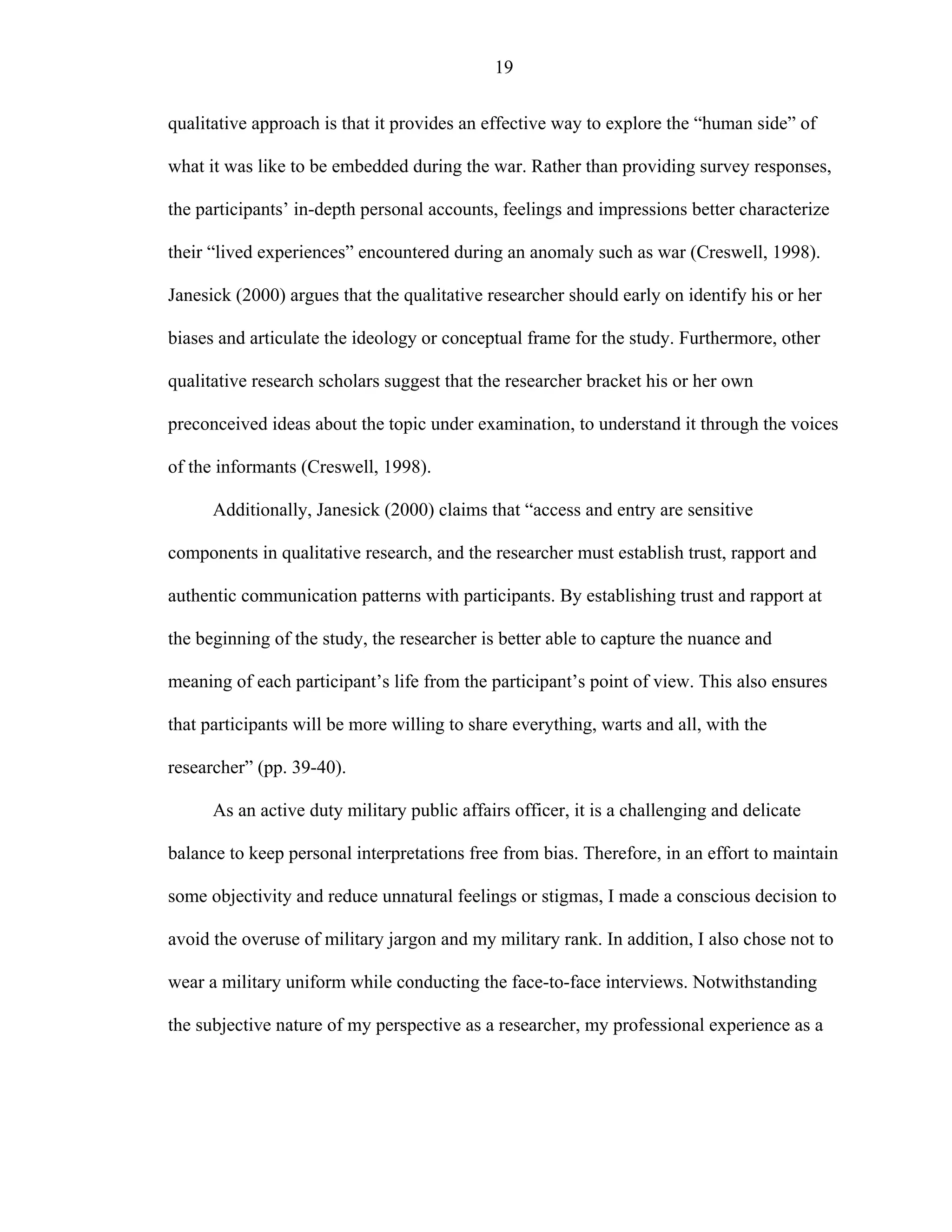
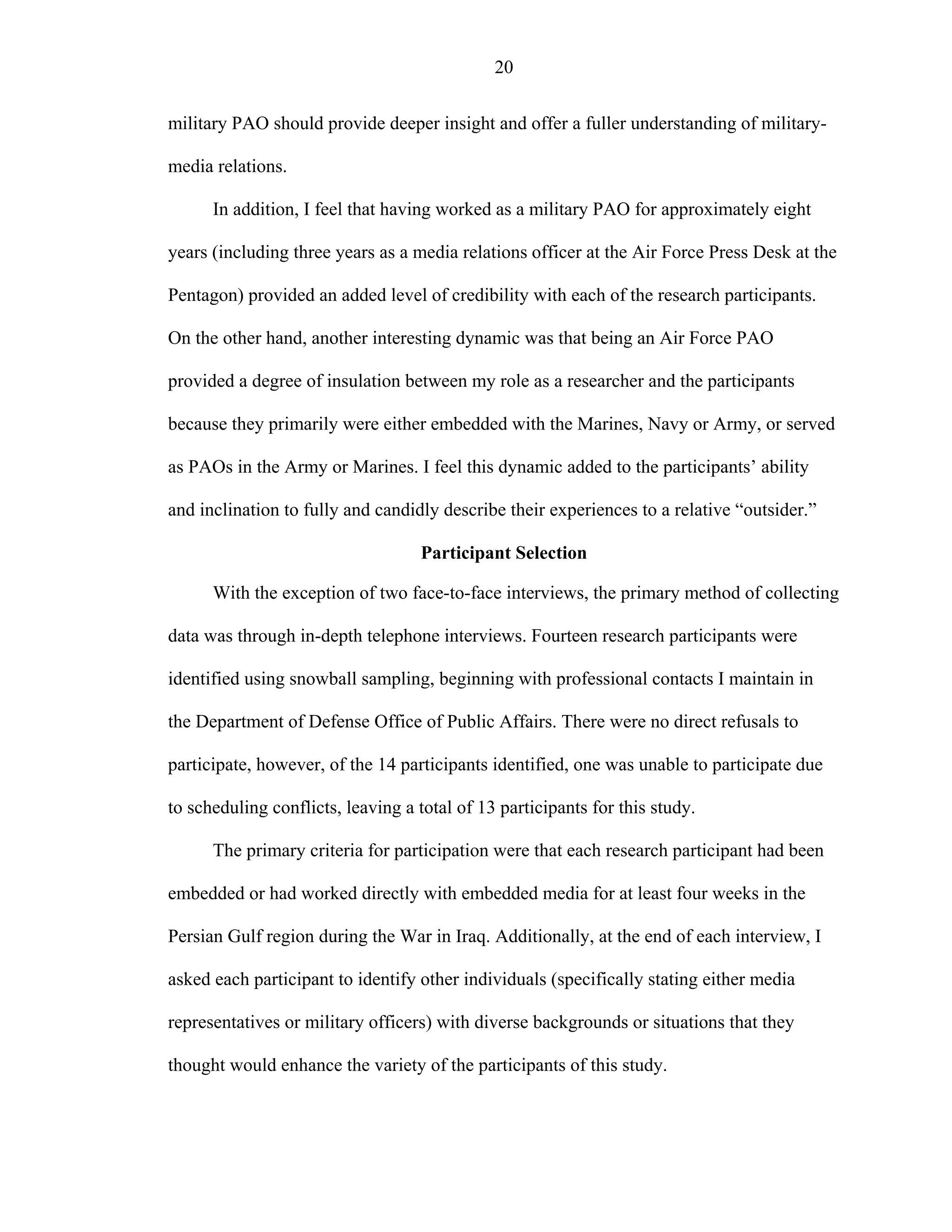
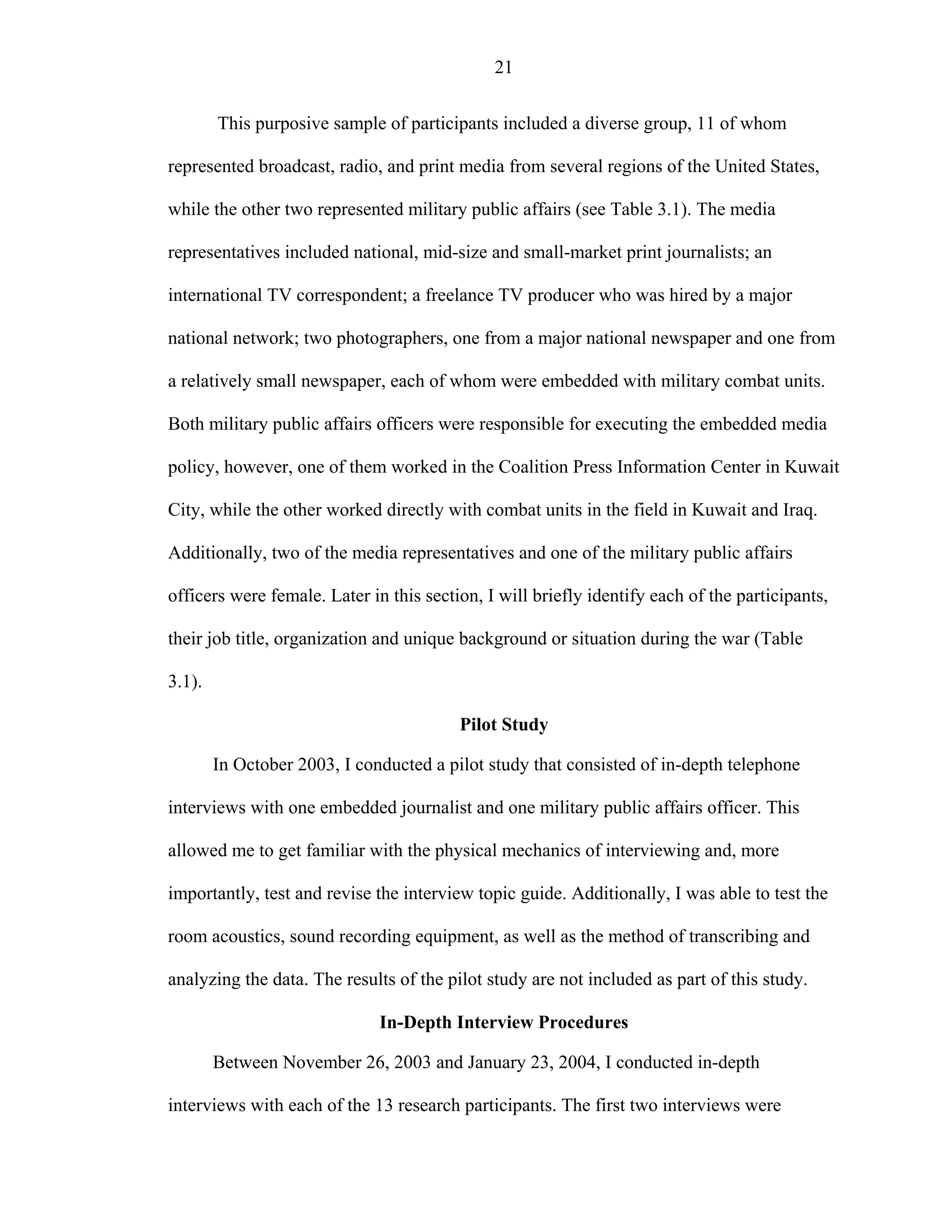
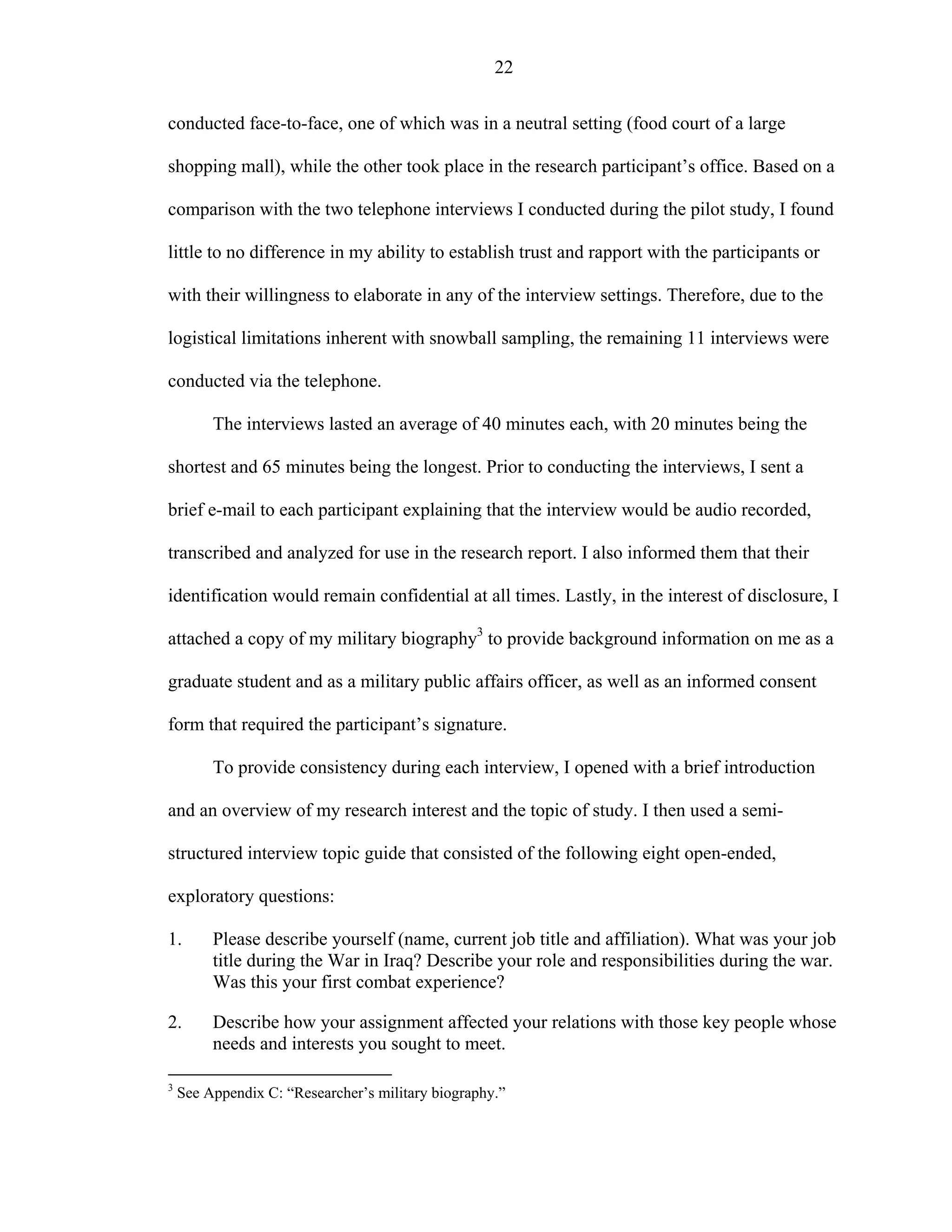
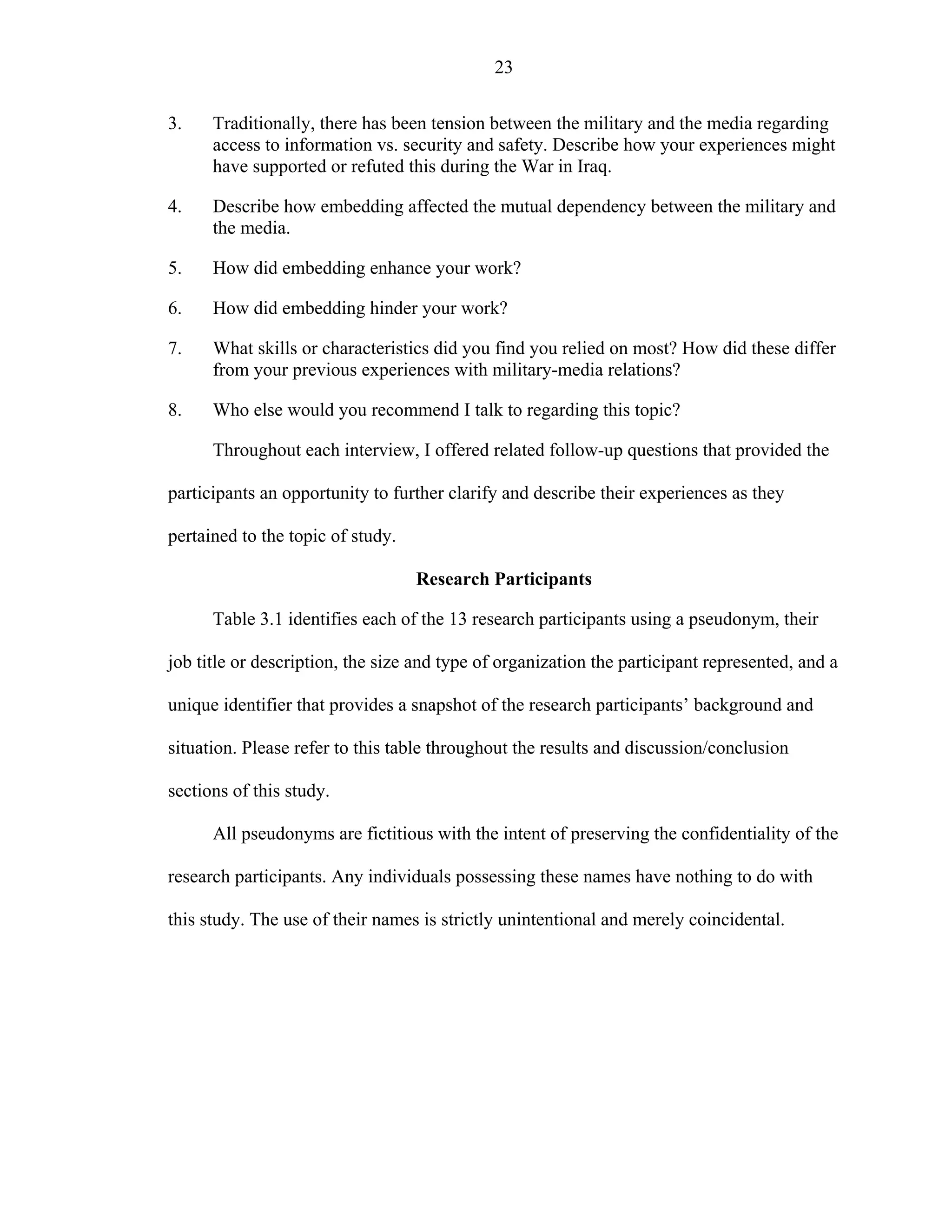
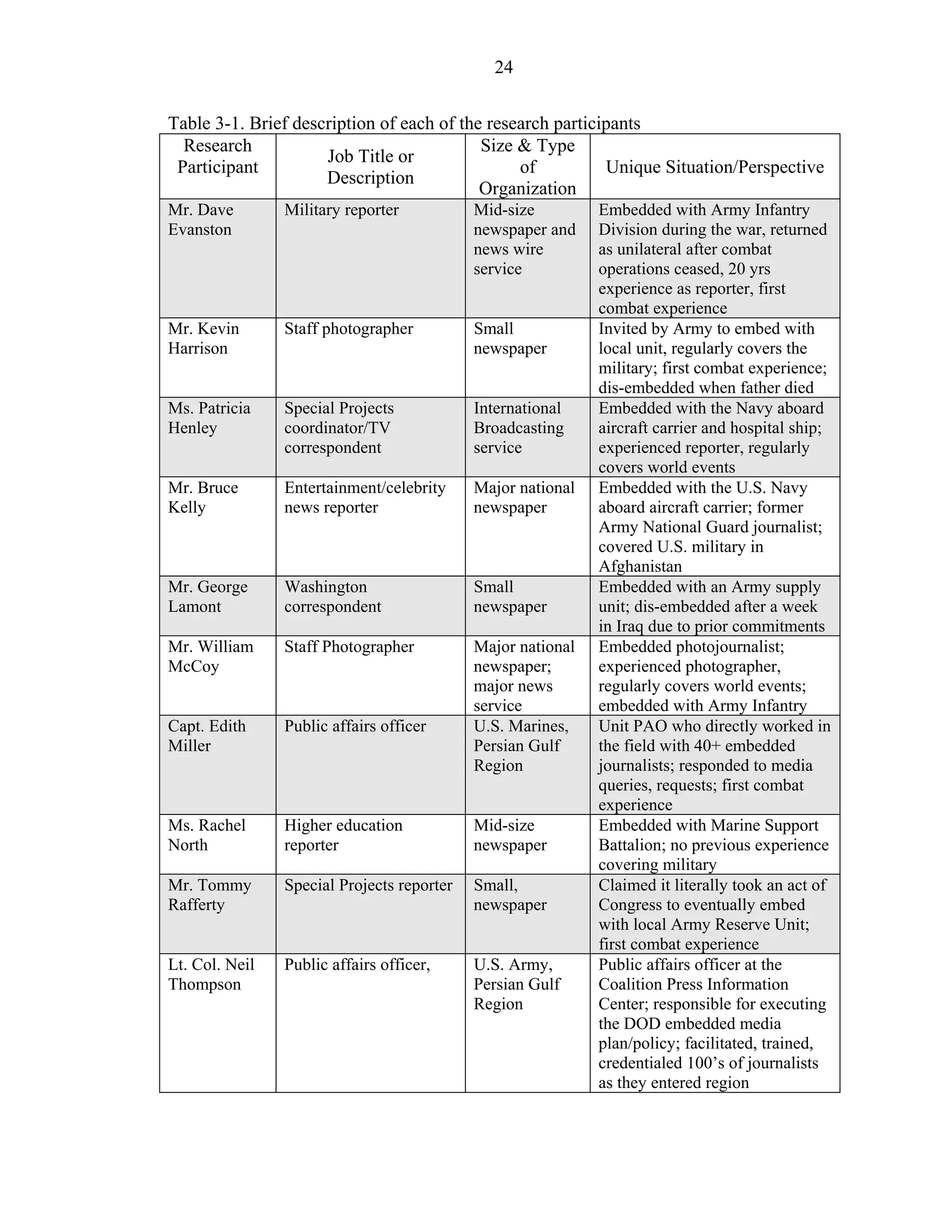
![25
Table 3-1. Continued
Research
Participant
Job Title or
Description
Size & Type
of
Organization
Unique Situation/Perspective
Mr. Jeff
Wilson
TV Correspondent Major network
TV affiliate
Worked as freelance TV
producer/correspondent for major
network; former Marine officer
during Vietnam War; covered the
Gulf War
Mr. Chuck
Winslow
Columnist Mid-size
newspaper
Embedded with a Marine Infantry
unit; Vietnam veteran, first
combat experience
Mr. Rich
Worthington
Washington
correspondent
Small
newspaper
Embedded with various Marine
Reserve units for 4-5 weeks; was
eventually kicked out of Iraq for
allegedly reporting military
capabilities and positions
Data Analysis
Each of the interviews was transcribed verbatim. Rather than hiring out for this
tedious process, I consciously chose this option to fully immerse myself in the data.
Using an inductive approach, the transcripts were first analyzed using open coding
to examine, compare and categorize the data. I then identified recurring themes and
constructed categories that included supporting evidence for each of these main themes.
Direct quotations from the research participants were sorted under each category to later
provide supporting examples of each of these main themes.
Authenticity and Trustworthiness
Daymon and Holloway (2002) argue there are two perspectives related to
assessing the quality of qualitative research. “Reliability and validity are the concern of
the conventional [quantitative] position” . . . however, the “second and perhaps more
fashionable position” (p. 92) relies on an “interpretive paradigm,” a concept they attribute
to Lincoln & Guba (1985), and Guba & Lincoln (1989, 1998). With this perspective the
“goodness of research is characterized by trustworthiness and authenticity” and is “shown](https://image.slidesharecdn.com/f1b809f5-114d-4260-9982-5cc91e095028-170129060938/75/Interpreting_the_embedded_media_experience-1-31-2048.jpg)
![26
by [the] researchers’ careful documentation of the process of research and the decisions
made along the way” (p. 93).
Daymon and Holloway (2002) argue that “a study is authentic when the strategies
used are appropriate for the ‘true’ reporting of participants’ ideas” (p. 93). Moreover,
they identify credibility, transferability, dependability and confirmability as key criteria
for evaluating the trustworthiness of qualitative research, claiming that, “If the findings of
your study are to be dependable, they must be consistent and accurate ... this means that
readers will be able to evaluate the adequacy of your analysis through following your
decision-making process” (p. 94).
In keeping with some of these strategies Daymon and Holloway (2002) offer for
ensuring the quality of qualitative research, I have provided a detailed description of each
of the steps of the research process, including an audit trail of the decisions made before
and during the collection of the data. Furthermore, I attempt to provide a thick description
of the context and the people in the study because Daymon and Holloway (2002) suggest
that “the reader of your study should be able to feel, hear and see exactly what it is like to
be in the setting your are describing” (p. 100).
Lastly, the pilot study adds credibility and dependability to the study as it served
as an effective means of honing my interview skills, familiarizing myself with the
recording and transcribing equipment, and analyzing the data, which closely mirrored the
findings from the present study.](https://image.slidesharecdn.com/f1b809f5-114d-4260-9982-5cc91e095028-170129060938/75/Interpreting_the_embedded_media_experience-1-32-2048.jpg)
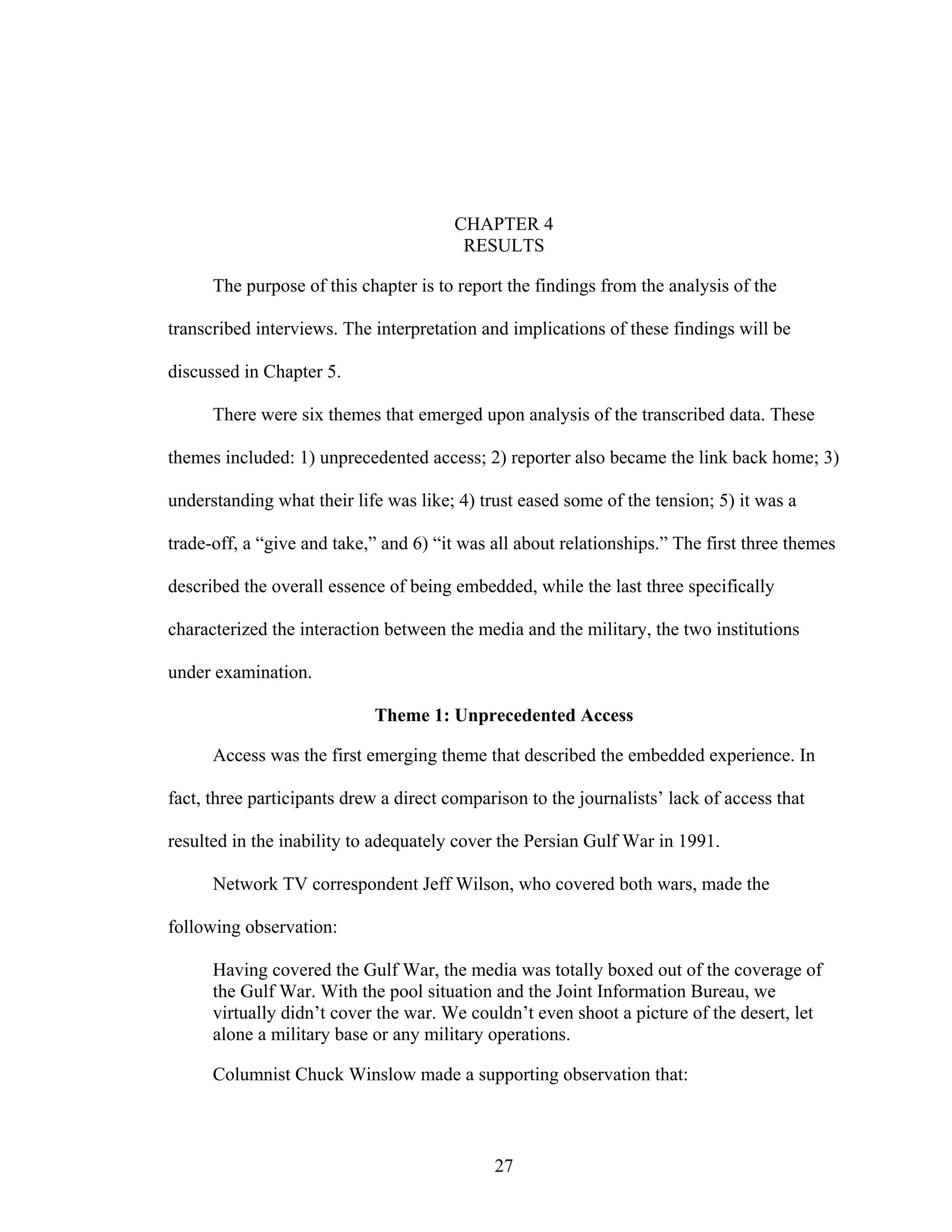
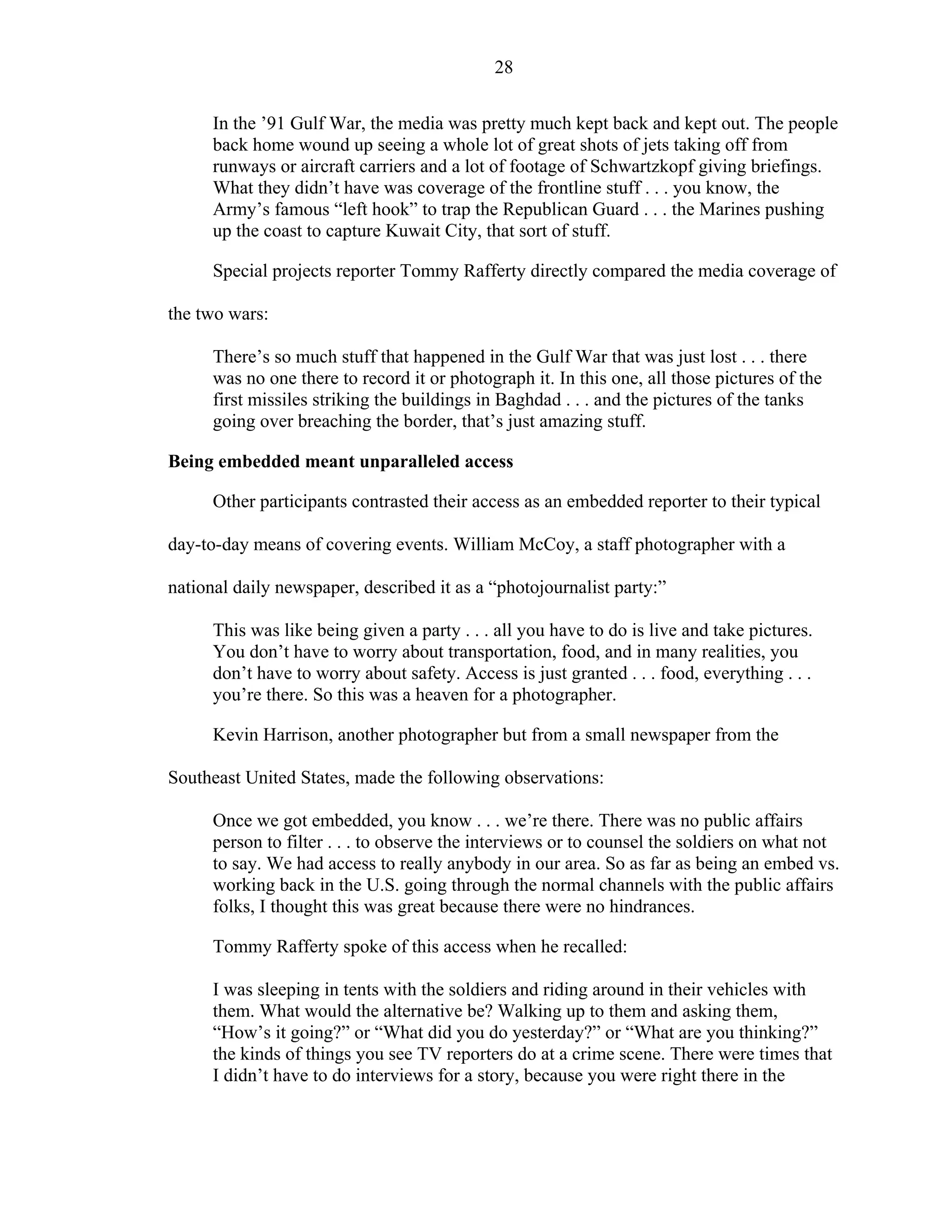
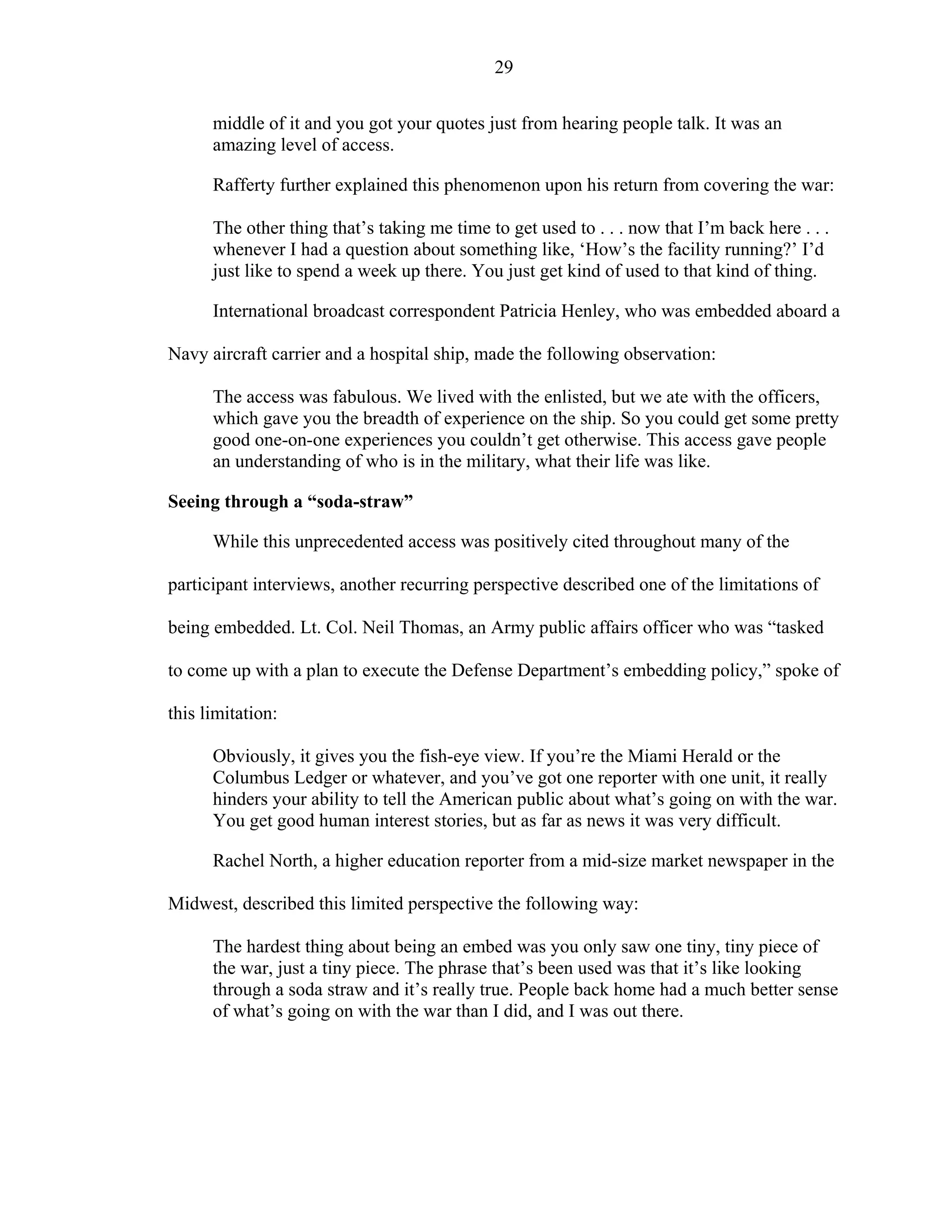
![30
George Lamont, a Washington correspondent for a small newspaper in the
Northeast U.S., recounts the following event that exemplified this ‘soda-straw’
perspective:
One of the most telling moments came when I went into the general’s briefing in
the morning and heard all about where the water, the ammo and the fuel was . . .
and then I go back to my tent and sign on the Internet and see that the biggest battle
of the war had just taken place about 10 miles away that night. Not a word of it was
mentioned in the briefing.
Tommy Rafferty also described this perspective:
What’s the opposite of a bird’s eye view? Your view was from the trenches. All
you could really see, was what you could really see . . . what you could hear, smell
and touch.
Pieces of a mosaic
Then again, some of the participants attested that larger news organizations had the
assets and thus the ability to see the big picture and tell the entire story. Patricia Henley
described it the following way:
The editors back here [in the U.S.] had to keep putting together the mosaic of what
was actually happening out there. There were just so many reporters with such a
small picture of what’s going on.
William McCoy claimed that:
If you’re a large company like the Associated Press, with many, many assets out
there, you had the ability to tell the entire picture. Without the embedding process
that wouldn’t be possible, because you wouldn’t be able to have all these little
pieces in the puzzle.
Also recognizing this perspective, Army PAO Lt. Col. Thomas spoke highly of the
cable news channels:
The best story was the major news organizations like CNN and FOX that had
numerous reporters on different levels of the battlefield, and somebody
coordinating it back in Kuwait. They could see the big picture taken from a bunch
of different snapshots to try to synthesize it.](https://image.slidesharecdn.com/f1b809f5-114d-4260-9982-5cc91e095028-170129060938/75/Interpreting_the_embedded_media_experience-1-36-2048.jpg)
![31
Theme 2: The Reporter Also Became the Link Back Home
The next common theme to emerge was that media representatives found
themselves not only informing their readers or viewers, but they also became the
connection or link between the military members in Iraq and the military families and
friends back home. Rich Worthington, a Washington correspondent for a small
newspaper in the Northeast U.S., described this unexpected role he adopted:
Never did we expect this kind of reaction. I heard from people, families and
everything [saying], I knew my husband, my boyfriend, nephew or whatever, was
safe for another day . . . because you would have written about it if something bad
had happened. There was a sense of relief. There was a sense of connection. I’d feel
guilty if I didn’t file [everyday], not for the paper’s perspective, just for the people
back home.
Rachel North also commented on this phenomenon:
It was a very interesting experience as a journalist because a lot of people actually
started looking for my byline. Because they found out that I was there with their
spouse, their husband, or whatever, their unit. So people were tuning into our
website from all over the country because I was the person with that particular unit.
I got so many e-mails when I got back.
Capt. Edith Miller, a Marine Corps public affairs officer who worked in Kuwait
and Iraq with more than 40 embedded journalists at the beginning of the war, made the
following observation:
We definitely had quite of bit of what I call American regional newspapers – not
the highest-circulated like the New York or L.A. Times, but [those] that had a big
impact in their regional communities. We made a pretty big impression . . . to be
able to send news home about the units and to send it back specifically to their
family and friends . . . for the local support in their area.
Jeff Wilson also spoke of this role as a conduit of information:
My family was responsible for keeping an open line of communication between the
[Marines’] families and myself, as kind of the only information they were getting
during the war. It was through my reports and some e-mails that my family relayed
to them.
Chuck Winslow spoke of a similar experience:](https://image.slidesharecdn.com/f1b809f5-114d-4260-9982-5cc91e095028-170129060938/75/Interpreting_the_embedded_media_experience-1-37-2048.jpg)
![32
The Marines let it be known that I was with the Xth Battalion, Xst Marines, about a
thousand guys. So there were a thousand family and countless friends all across the
country who knew that. They would log on to the Internet to see our stories. They
were just so appreciative of that. I got countless e-mails when I got back who said,
‘oh, it was so great’ even though I didn’t mention their kid’s name. If I talked about
his unit, they kind of knew where he was and what he was going through. That was
really the most gratifying thing.r
Kevin Harrison also recalled:
The response we got back home was immense, especially like military wives and
the general public. They didn’t care what we sent back, they read it. They loved it!
It was great!
Tommy Rafferty also shared this sense of connection:
When I got back here and checked my e-mail for the first time, I had just a flood of
things from people around town and from people all over the country who knew
someone in that unit. The response was overwhelmingly positive. It’s almost
embarrassing . . . they think I’m so great. One person actually gave me $50. I tried
to give it back and the paper wouldn’t let me keep it, so I donated it to charity.
“Here…use my phone”
Some of the participants even talked about how they literally provided that
connection with the use of telephones and lap-top computers. Dave Evanston, a military
reporter for a mid-size newspaper from the Southwest U.S., who also filed stories for a
national news service, shared the following anecdote:
There were soldiers who knew the war was coming in a few hours and they saw me
on the satellite phone talking to my boss. They came over with those dog-faces and
they all had a sob story, and it was one bad story after another. They didn’t even
have to use those sad stories on me. If they needed it, I’d say, ‘get on the phone for
5 minutes, but don’t stay on any longer.’ I’d let them use my laptop at will ...
probably let them use it too much.
Rich Worthington recalled a similar experience:
I’d let them use my sat [satellite] phone from time to time. I’d relay dozens of
messages and I would e-mail messages for different Marines and bring information
back, things like that. People would ask me sports scores or what’s going on in the
world.](https://image.slidesharecdn.com/f1b809f5-114d-4260-9982-5cc91e095028-170129060938/75/Interpreting_the_embedded_media_experience-1-38-2048.jpg)
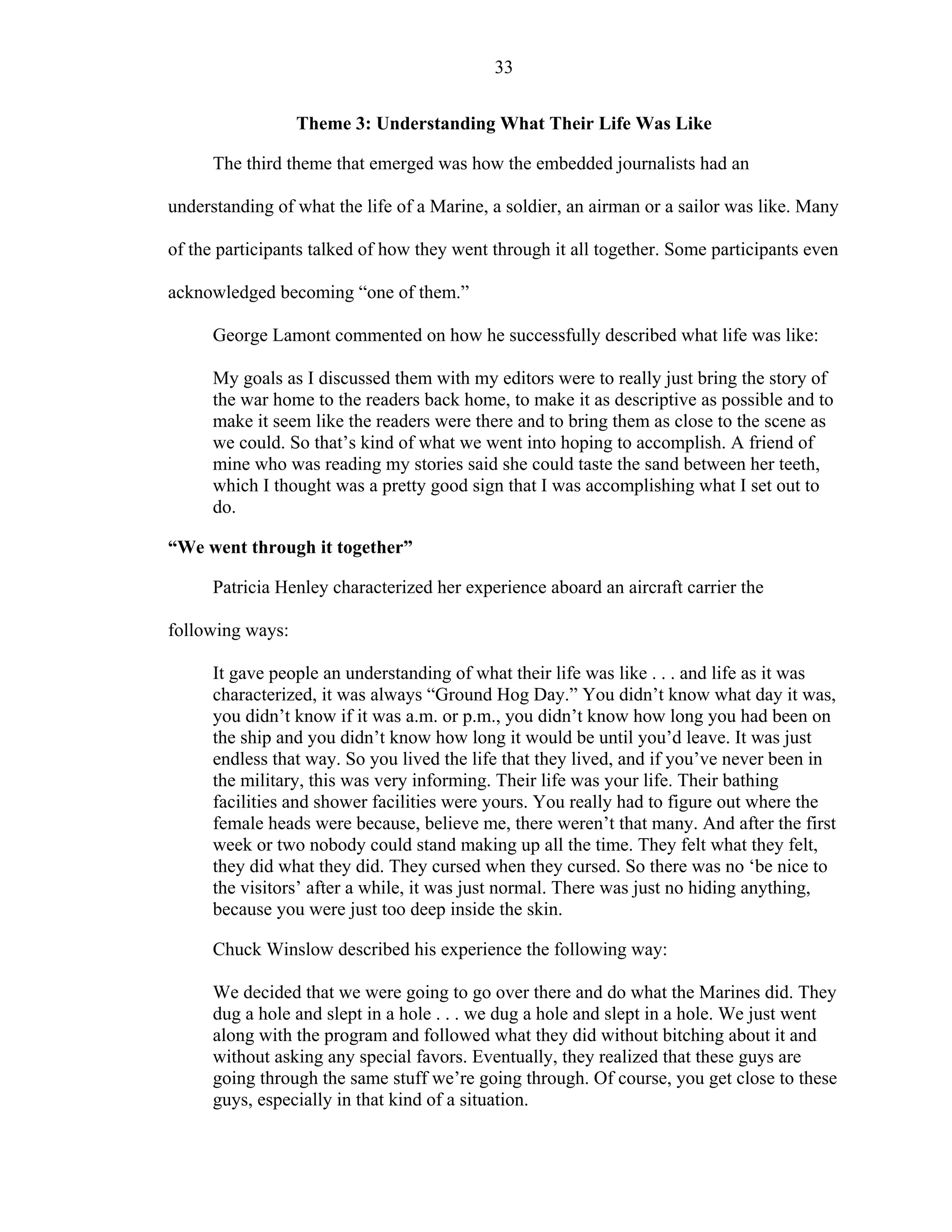
![34
“Becoming one of them”
Some of the research participants even went so far as to claim that they became part
of the military unit, using “we” and possessive pronouns such as “my,” “our” and “us.”
Dave Evanston described this phenomenon:
When my bosses were concerned about me getting too close, they would remind
me that, ‘it’s not we’ when I’d say we took a bridge today. And I know what they
were saying, but when you’re with a group of people like that you become . . . if
you’re any kind of human being, you become closer to the people. I came over
there to do my job, but in the process, I found a whole new “band of brothers” for
the rest of my life. Those people are my friends and I don’t mind saying that and I
don’t care what other reporters think about it. What matters is that we went through
something as scary as hell and we survived it.
Jeff Wilson, a former Marine officer in Vietnam, characterized similar feelings
about his experience the following way:
It’s really refreshing being back in the military, having the camaraderie and
selflessness that really don’t exist in the media business, which is very competitive
and individualistic. It was really kind of refreshing to get back into that team spirit,
that kind of caring for each other, and the selflessness that was required living out
in the field under such miserable conditions as long as we did and not really
complaining about it . . . so it was really infectious.
Tommy Rafferty described his perspective as an embedded reporter:
I was just there to cover it through their eyes and ears. I was more interested in
being in the tent where the soldiers were and seeing what their emotions were, what
they were feeling and what they were going through as the war developed. There
were people who ended up not liking me and others who I ended up getting really
close to. It almost became like I was one of the soldiers. So living and being in that
same situation of fear, and having to eat MRE’s [meals ready to eat] and having to
sleep outdoors with all the people; there’s just no substitute for that.
Army public affairs officer Lt. Col. Neil Thomas recalled the following instance of
journalists identifying with their units:
The embedded people were very jealous of their status with their units. Their
organizations had done a lot to get them there . . . they paid a lot of money and that
was their story. They realized that it was a small universe, but that was their turf.
So if you’d have a unilateral roll in [an independent reporter who was not
embedded who would try to cover the unit], it wasn’t necessarily the military](https://image.slidesharecdn.com/f1b809f5-114d-4260-9982-5cc91e095028-170129060938/75/Interpreting_the_embedded_media_experience-1-40-2048.jpg)
![35
kicking them out, the embedded guys were kicking them out. They basically had
kind of the Stockholm Syndrome, where the reporters felt like their unit was the
best unit in the military.
William McCoy described how he was included from the start, when he recalled
one of the commander’s initial briefings:
The top commanders said, “Let the reporters and photographers in on your top-
secret meetings, in your briefings, anything. They have free will here. They can go
anywhere they want, but they’re under the premise that they’re not going to release
any vital information. And until they break those rules, they’re part of this team.”
Bruce Kelly, an entertainment writer for a large national newspaper who embedded
with the Navy, made the following observations:
Basically, you’re living with these people, you’re sleeping with them, and you’re
eating with them. You sort of had to strike a balance of not ticking people off, who
were obviously your keepers and basically in charge of protecting you and making
sure they’d save your life if they had to. And at the same time, you had to still get
the news and remember, this is a job and you weren’t in the military.
On the other hand, Rachel North made it clear that she personally abstained from
“becoming one of them.”
There may have been some [reporters] in terms of becoming too dependent on the
military or too cozy. You know if you’re a reporter and you suddenly start thinking
you are a Marine, I hope there wasn’t any instances of that.
Theme 4: Trust Eased Some of the Tension
The theme of trust further described the interaction between the media and the
military. Some of the research participants spoke of their pre-conceptions regarding the
tension between the two institutions. Rachel North claimed that, “I didn’t have a
relationship with the military beforehand, but there was pretty much the belief that the
military and the media just don’t get along.”
Chuck Winslow offered the following anecdote that described how trust was
crucial to ease this tension:](https://image.slidesharecdn.com/f1b809f5-114d-4260-9982-5cc91e095028-170129060938/75/Interpreting_the_embedded_media_experience-1-41-2048.jpg)
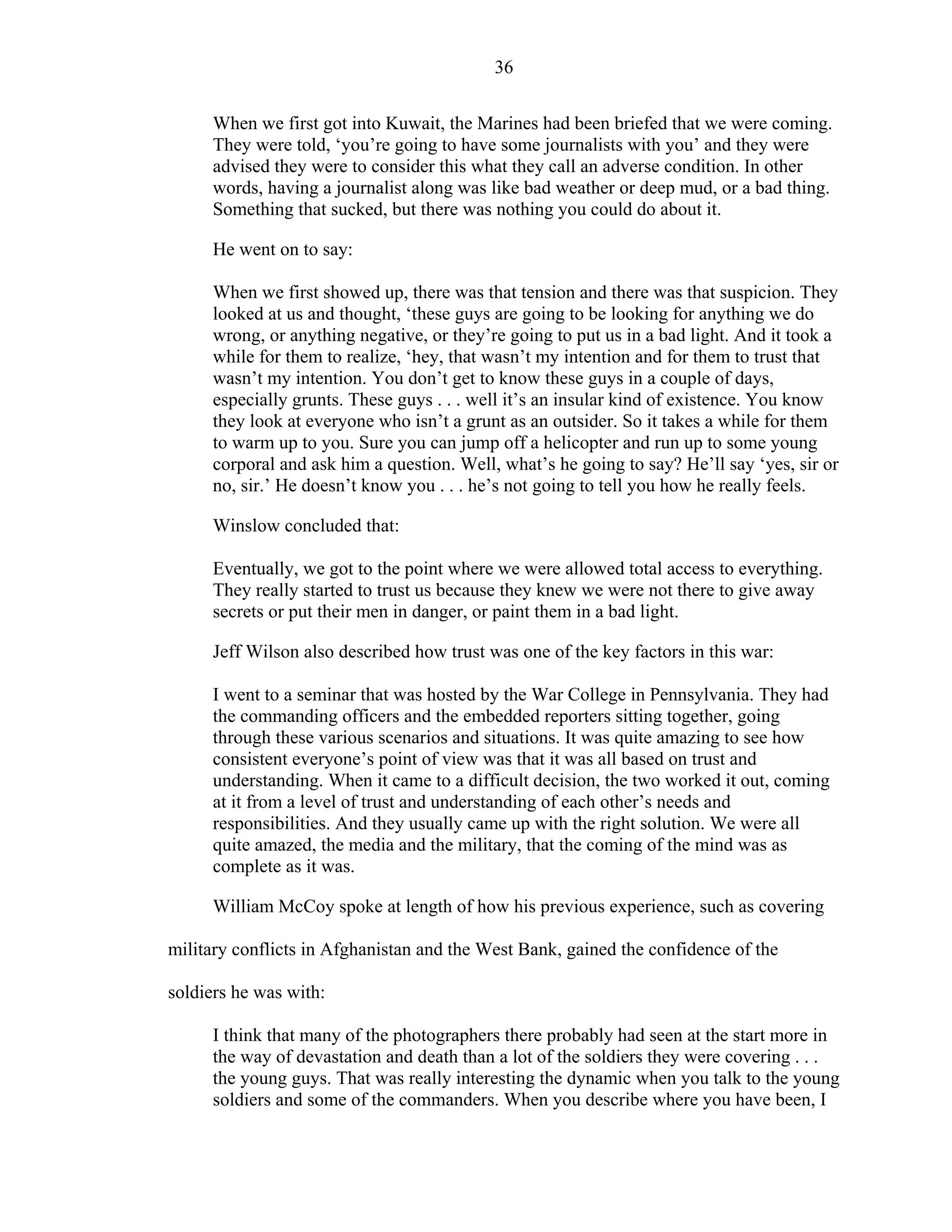
![37
think that opened up a lot of doors. They understood why you were there and what
you were doing, once those barriers were down. In many respects, it just took time.
People just watched how you worked and realized what you were doing, as with
every assignment, to gain people’s ‘at ease-ness’ to allow you to do your job.
Dave Evanston described the initial pre-conceptions of one of the soldiers he was
embedded with:
Before the war, one guy said on the radio to me, “Why should we allow you to be
in with the soldiers, you’re just going to screw things up, you’re just going to give
away secrets.” At first when we came there he thought that we were just going to
write all the bad crud and he didn’t want us around. By the end of the war, I think
all of us were glad to have known each other . . . it’s a learning process for
everyone.
Evanston concluded with the following observation regarding trust between the
media and the military:
The tensions aren’t over, I wish they were, but I don’t think they’re going to be
over as long as you’ve got a camera in your hand and you’re unknown to a soldier.
The soldier is going to treat you more like an enemy combatant than a potential
friendly. They almost have to do that . . . they’re trying to stay alive and they’re all
nervous.
On the other hand, Rich Worthington saw both perspectives and made the
following observations:
Most of the officers were good. I had some problems. I don’t know if you knew
about the problems [but] I got kicked out.
He went on to elaborate:
My problems for the most part, came down from the battalion commander. All
across the battalion staff, they were excellent to me. It was just the battalion
commander who didn’t want press there to begin with. The 3 or 4 weeks before we
went, we were fighting to go, because he didn’t want us. But there was a lot of
pressure put on him from the Marine headquarters. The sense I got from him was
“no coverage is good coverage.”
Although Worthington was eventually kicked out after 4 or 5 weeks for allegedly
disclosing military capabilities and positions, he concluded that, “The Marines I was](https://image.slidesharecdn.com/f1b809f5-114d-4260-9982-5cc91e095028-170129060938/75/Interpreting_the_embedded_media_experience-1-43-2048.jpg)
![38
with, by and large, were very cooperative and helpful. It surprised me to some degree
because the military and the media haven’t always had that good of a relationship.”
Theme 5: It Was a Trade Off – “A Give and Take”
Another common theme that emerged was how being embedded was a trade-off or
“a give and take.” Tommy Rafferty described this phenomenon when he said, “If you
were an embedded reporter you signed ground rules agreements. That was an exchange,
it was a deal. You agree to those things in exchange for 100% access to the troops.”
Jeff Wilson also spoke of this trade-off:
As a result of the Gulf War, the media had a very bad feeling from that war. And I
think had they not come up with a solution this time the media was not willing to
play by the military’s rules this time. By the same token, I could see where the
military realized they had to do a better job than they did in 1991. So out of those
two interests, they came up with the embed plan, which was kind of “keep your
enemies close to you.”
Wilson continued:
I think that by keeping the media close, giving them this ultimate access by keeping
them close, they’d probably have more control. Not editorial control, but logistical
control over their activities, which is what they really wanted. I think that they were
willing to experiment with the benefit of the doubt, that if the media really got to
know the military, they’d have a much better context for what was happening. And
I think that had proven to be the case.
Chuck Winslow also made a similar observation addressing the Gulf War and
spoke of the give and take between the two institutions:
I got the impression [after the Gulf War] a lot of ground commanders felt like,
“Damn it, my men did a lot of really good stuff and there was nobody out there to
report it. So nobody knows about it.” I think that the military at that point, really
kind of realized, or at least they started to, that they needed the news media. Yes, it
can be dangerous to have them around, but they need the media to get that message
back as to what these boys and girls are doing. So I think that was the motivating
thing for the embedding program in this war.
Kevin Harrison further described this give and take situation:](https://image.slidesharecdn.com/f1b809f5-114d-4260-9982-5cc91e095028-170129060938/75/Interpreting_the_embedded_media_experience-1-44-2048.jpg)
![39
It took a lot of faith to embed all these folks . . . a lot of faith because there are
journalists who would, in an effort to one-up the other guy, try to reveal more than
they should. I guess that was the risk that the U.S. [military] took. But in the same
right, they also had these guys who were kind of part of the unit. So they’re kind of
trapped . . . not really trapped, but they’re kind of a captive audience. It was kind of
a risk for the military to embed all these folks. They had to have an element of
trust, but in the same right, they got more accurate and realistic reporting, I think.
Dave Evanston talked about other trade-offs between him and the soldiers he was
embedded with:
They needed us to keep in touch with the folks back home. I needed them to make
sure that my blood pressure wasn’t going down so low that my heart was going to
stop because my blood pressure plummeted once I got out to the desert. Also, while
they got us into battle, they could’ve gotten us killed, [but then] they also protected
us. So there is a mutual dependency without question and that’s part of what helped
everybody get to know each other. That was one of the key things that helped bring
down the walls.
George Lamont observed the following trade-offs during his embedded experience:
I think it did very good things for both the military and the media. I know myself, I
learned an incredible amount and got a new kind of respect for people in the
military and what they do. I really think that you have to see it . . . you have to
know these people to understand what a fine machine this is – the U.S. military. I
also get the sense that it helped the morale of the troops when they could actually
see that they had been written about.
Lt. Col. Neil Thomas talked of the very specific trade-offs that had grave
consequences:
I told the media flat out, “Our intent is to show you the good, the bad and the ugly
of war. We’re not going to have a public affairs officer standing over your
shoulder. We’re not going to be censoring you. We trust that you are going to be
ethical. And frankly, you have a vested interest in making sure that you do not give
away operational security ... because if you do and the artillery starts falling, it may
be falling on your head.”
Bruce Kelly described this give and take the following way:
I think the military wanted reporters to live just like the soldiers did and give them
a firsthand taste of what it was like so they have a better understanding. Especially
nowadays there are so few reporters out here that have military backgrounds. On
the flipside, reporters got to experience it and provide much better, much clearer
stories. So each needed the other, obviously the Pentagon wanted reporters not to](https://image.slidesharecdn.com/f1b809f5-114d-4260-9982-5cc91e095028-170129060938/75/Interpreting_the_embedded_media_experience-1-45-2048.jpg)
![40
just cover the glory and the battles, so to speak, but also as witnesses making sure
that if Saddam or his cronies had come out and said, “U.S. soldiers are slaughtering
women and children in the village,” the military had witnesses right there. They
had reporters who could independently verify that, “no that’s not the case.”
Theme 6: “It’s All About Relationships”
Several of the participants spoke specifically about the importance of relationships,
either in their ability to successfully do their job, or in terms of building relationships
with people with whom they withstood certain situations. Many of the participants even
described how they became personally involved in the lives of the military members they
were embedded with. Jeff Wilson spoke at length about all of these aspects of
relationships:
I was asked to do an embed project based on some previous work I’d done in
Afghanistan. They [the TV news network] knew I had good military contacts and
they wanted me to try to use those contacts to get even closer than the normal
embed would get, and because of my military experience as well. With that, I was
able to approach General X [omitting name for confidentiality] of the Xst Marine
Division, who I was with in Afghanistan, about doing an embed even though the
slots had not been officially given out. He told me that he was very interested in
having someone document them all the way from start to finish, through the
training and the deployment. We had developed a good level of trust during the
Afghanistan conflict, so he knew that I knew how to get around the battlefield,
knew the terminology and the protocol and that I could take care of myself while I
was out there. So I was embedded into his unit. That was my relationship with them
and it went very, very well. It’s a relationship that continues today. We just finished
exchanging Christmas gifts and cards. We feel pretty much part of the Xst Marine
Division family. And not only was I personally involved with them, but my family
also got very involved with their families in my absence during the war.
William McCoy also described how relationships were a key factor that allowed
him to accomplish his daily duties as an embedded photographer:
You can tell there’s always a fence [between] the media and the military. You
develop relationships with people in the public affairs departments and they
understand what you’re trying to do. They respect you, because they know you. But
if you’re just walking in there off of the street, there’s going to be an arm’s length
discretion. And it’s all in basically developing sources and developing reputations
and . . . I don’t want to say friendships, but it’s business relationships.](https://image.slidesharecdn.com/f1b809f5-114d-4260-9982-5cc91e095028-170129060938/75/Interpreting_the_embedded_media_experience-1-46-2048.jpg)
![41
Mc Coy went on to describe his specific situation during this war:
After a week or two, after people realized who you were as a person or a journalist,
the respect factor went up tremendously. And once the war started and people saw
how you worked and how you were there to cover their story, and you weren’t
there for personal or political reasons, the respect value and the respect factor went
up tremendously. And to this day, because of so many of those instances, there’s a
working relationship that has been developed that’s more valuable that what was
there during the war. It’s no different than covering any other assignments, where
you have one-on-one contacts with people. It’s the friendships, it’s the professional
relationships you build.
Chuck Winslow made the following observation:
Of course you get close to these guys. I mean I’m still friends with a lot of the
Marines I was over there with. I see them every now and then . . . we have beers
and that sort of stuff. So yeah, I got close to them, especially in that kind of
situation.
Dave Evanston also discussed the value of relationships:
The thing I can say about Lt. Col. X [the unit commander; omitting name for
confidentiality] is that I thought we worked pretty well [together]. He never really
interfered with what I was doing. The working relationships that we established . . .
it was more collegial than it was adversarial. I think to some degree, the reason for
that is because of the closeness of the quarters for all of us and the danger that we
all faced.
Evanston also described how he has become personally involved with a few of the
soldiers:
It’s hard to explain to people who haven’t been there, but that’s what happens . . .
those people who at first were merely soldiers and airmen that I was supposed to
report on, some of those folks became my friends. And a few of them are like
brothers. In fact, Craig Stevenson’s grandfather died a couple of days ago and I’m
going to meet him tomorrow at the funeral. When he gets married, I’ll go to his
wedding next summer.
Rich Worthington discussed the importance of relationships as an embedded
reporter:
It was a completely different perspective. It’s hard on any assignment to sort of
parachute in some place and cover it with people you don’t know. If you’ve got a
relationship with someone, it’s much easier to find out what’s going on and get the
accurate information. And for a story like this, where from my perspective it was](https://image.slidesharecdn.com/f1b809f5-114d-4260-9982-5cc91e095028-170129060938/75/Interpreting_the_embedded_media_experience-1-47-2048.jpg)
![42
human interest type stories, to see what these guys are going through. You can’t
build that relationship just parachuting in for a day. One of the platoons sent a
postcard to my bosses saying I should get a raise, and stuff like that. And that was
built over time you know . . . you scrub their back, they scrub your back.
Bruce Kelly talked of about relationships aboard a Navy aircraft carrier:
Obviously, it needs some fine tuning here and there, but I hope that the military
keeps this [embedding] as it is. We had a very good rapport with our officers who
were on the ship. We were almost like family when we left. In fact, I recently
attended a reunion with the reporters and all the top commanders on the ship.
However, that was not the case on other ships. I heard about how restrictive they
were . . . some even had to be escorted to the latrines.
Tommy Rafferty described what may have been more of a give and take
relationship:
I think what they [the military] were trying to do this time was to have a better
relationship, kind of get back to the way it was in World War II. Of course in WW
II, you had guys who were team players, plus they were censored. This time around
they had the ground rules agreement4
and I didn’t see any censorship going on,
except at the back end. If you violated the ground rules agreement in a report, you
were put under field arrest and driven down to Kuwait and dropped off. I think that
was what they were trying to do, and I think it worked very well.
Evanston concluded with the following anecdote that described the importance of
the relationships he formed while embedded:
There was a day during the war, after the intense battle at a bridge near Karbala.
We were on a road which was about 3 miles long and it ended in a T. There were
bunkers across from us about 200 yards that had been held by the Iraqis. That night,
the Iraqis came down to counterattack and it was an extraordinary battle. I kept
feeding reports back on it to my editors, right as it was going on. I just picked up
the phone and called and dictated. [At one point] I looked over at the guys and said,
“If we make it home, I’m putting a flag pole up in the front yard.” And I’m not a
big flag-waving guy, but that’s what I did . . . When I look at that flag pole, it
reminds me of that morning. It reminds me of all the shit that we all went through,
and we all went through it together. I mean I was still doing my job and they were
doing their job, but there’s another dimension to that relationship and that
dimension became important. Some people in the journalism community might say
that I had crossed the line, in terms of my emotions, but I don’t give a rat’s ass of
4
See Appendix A: Release, Indemnification and Hold Harmless Agreement and Agreement Not to Sue,
and Appendix B: Public Affairs Guidance (PAG) on Embedded Media](https://image.slidesharecdn.com/f1b809f5-114d-4260-9982-5cc91e095028-170129060938/75/Interpreting_the_embedded_media_experience-1-48-2048.jpg)
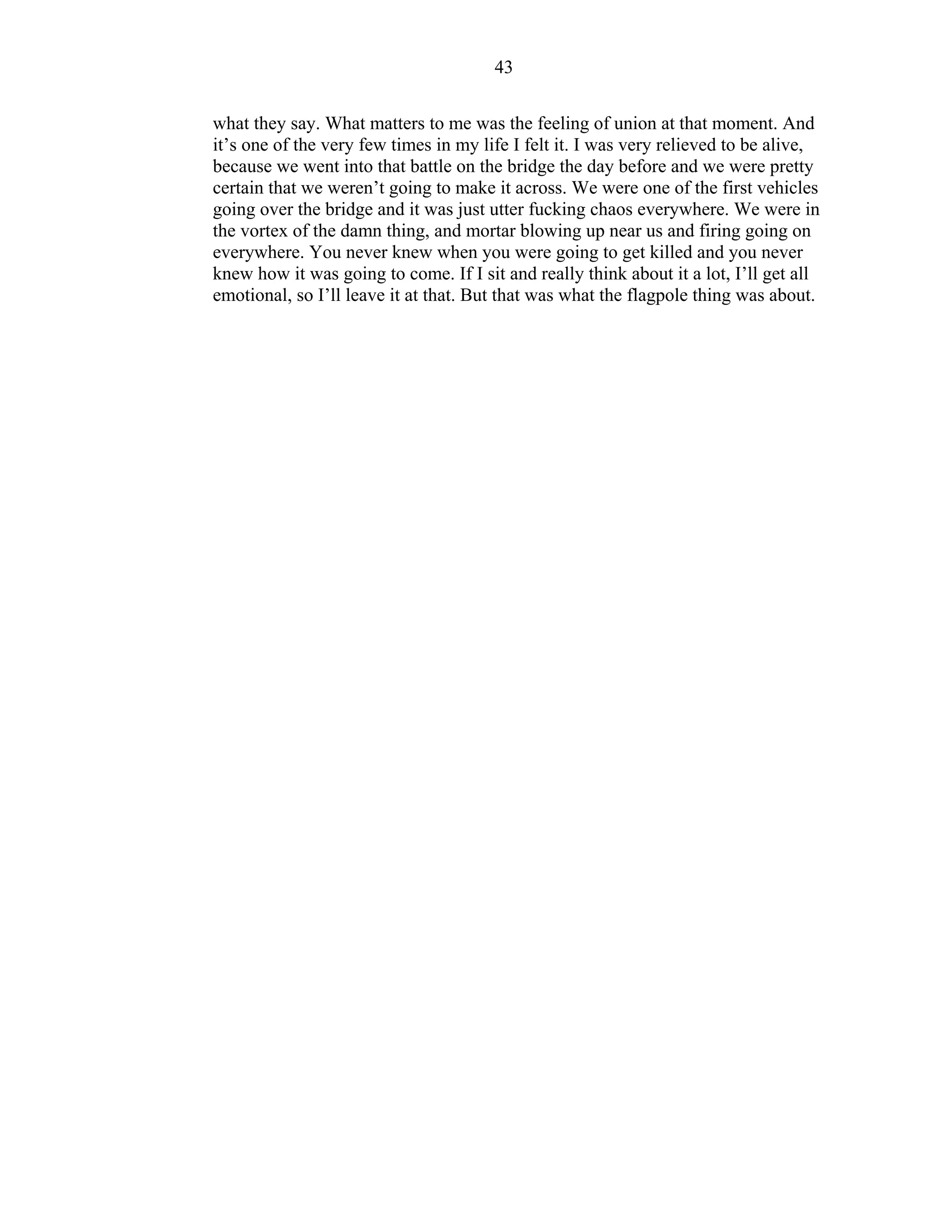
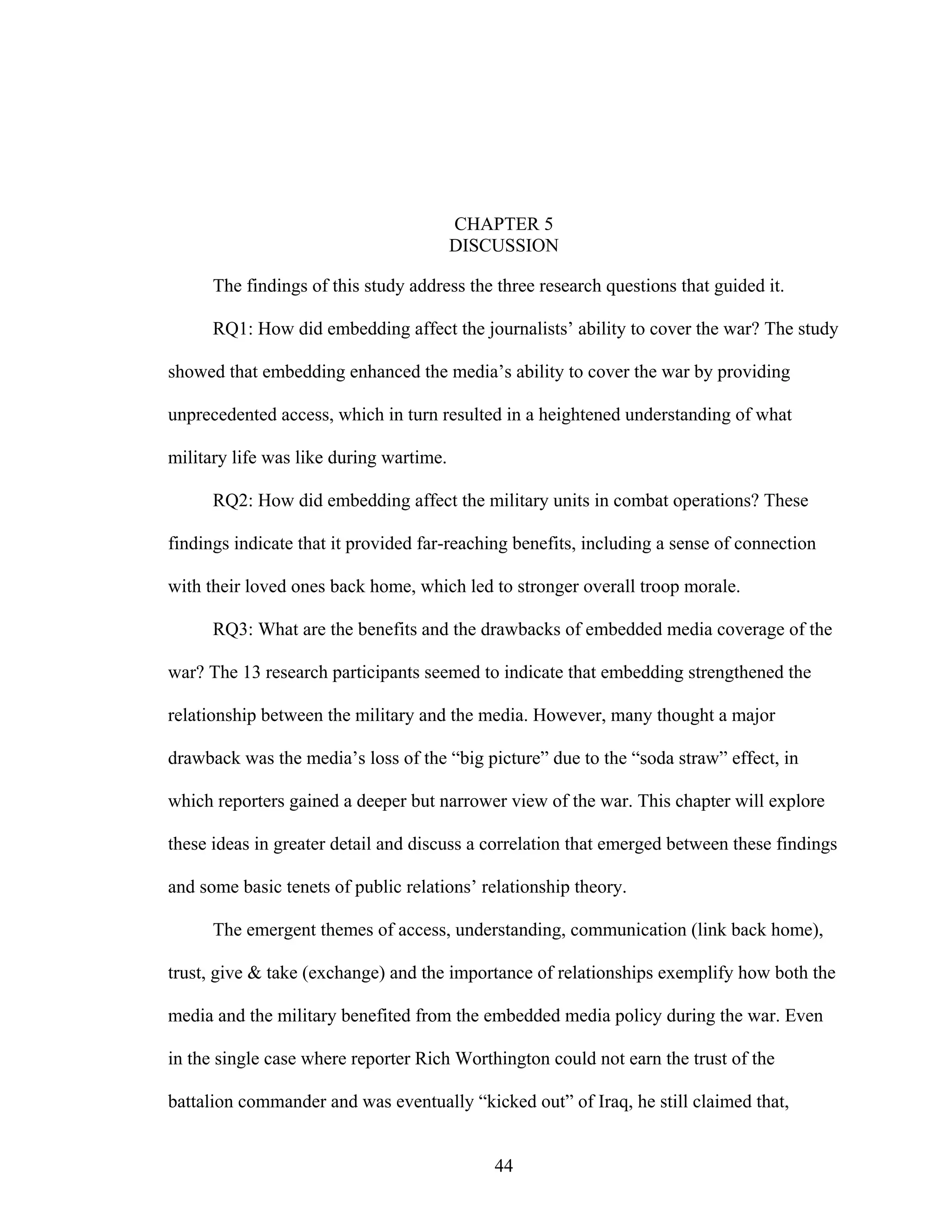
![45
“overall I had a good experience with these guys and I’m still in touch with a lot of
them.”
In comparison to the strained military-media relations during and after the Gulf
War in 1991, the research participants emphasized the unprecedented access and how it
provided an up-close, first hand view of the events as they happened, as well as how this
dynamic provided a means for the media to live with, understand, offer assistance to and
eventually become personally involved with their military counterparts; all of which led
to the building and strengthening of relationships, a striking change from military-media
relations during the Gulf War as identified in the literature review.
Additionally, a majority of the research participants also identified how the key
variables of trust and a “give & take” [exchange] seemed to, as Reporter Dave Evanston
said, “bring down the walls” between the media and the military. Reporter Bruce Kelly
summed up the importance of these two key variables:
I think it was a very successful system. Everyone pretty much got what they wanted
under the embedding process. And I think we [the reporters] proved that some of
the past campaigns, [and specifically the Department of Defense’s media relations
policies during] Desert Storm, Grenada, Panama, were just silly because obviously
reporters can be trusted to withhold information until the time comes when it can
be released.
As pointed out in the findings section, an unexpected phenomenon that resulted
from the media embedding was identified as “the reporter became the link back home.”
Here again the elements of a “give & take” exchange and trust provided a mutual benefit
to both parties. The trade-off was while military members could communicate with their
loved ones back home, the media continued to earn the trust of the military units, which
eventually led to more access and built stronger relationships. To illustrate this point,
reporter Chuck Winslow recalled,](https://image.slidesharecdn.com/f1b809f5-114d-4260-9982-5cc91e095028-170129060938/75/Interpreting_the_embedded_media_experience-1-51-2048.jpg)
![46
You got to know these kids in a way that you couldn’t have before. Eventually, we
got to the point where we were allowed total access to everything. We stood there
while platoon commanders gathered, when they were planning an operation, and
[they] would draw lines on the map and that sort of stuff.
Theoretical Correlations
The findings of this study add credence to the scholarly interest in relationship
management theory as a separate public relations paradigm (Ferguson, 1984; Ledingham,
2003; Ledingham & Bruning, 1998; Bruning & Ledingham, 1999; Ehling, 1992; Hon &
Grunig, 1999; L. Grunig et al., 1992; Huang, 1998). This substantial body of public
relations scholarship is rooted in Ferguson’s (1984) call for placing the research focus on
the relationship itself, rather than on the organization or the public. She concluded that “a
relationship-centric model has the assumption that the relationship is the prime issue of
concern, not the parties” (p. 20).
Apart from this study’s overarching theme of “it’s all about relationships,” the
fundamental themes of access, understanding, communication, trust and exchange that
emerged in this study draw several direct correlations to the body of knowledge in
relationship theory.
Ehling (1992) posited that the relationship management perspective shifts the
practice of public relations away from the manipulation of public opinion and towards a
focus on building, nurturing, and maintaining organization-public relationships. When
comparing the two wars, the participants in the present study observed that the military
shifted its media relations’ strategy of tightly-controlled press briefings, media pools and
manipulative “security reviews” during the Gulf War, to media embedding which, they
seem to have concluded, clearly resulted in a mutually beneficial relationship built on
trust, exchange and understanding during the War in Iraq.](https://image.slidesharecdn.com/f1b809f5-114d-4260-9982-5cc91e095028-170129060938/75/Interpreting_the_embedded_media_experience-1-52-2048.jpg)
![47
Army PAO Lt. Col. Neil Thomas described it as “a sea-change from the Vietnam,
Gulf War days of ‘we don’t want to tell the media anything, because we’re afraid they’ll
give away operational security.’”
Trust, Understanding, Involvement, Access and Openness
L. Grunig, J. Grunig and Ehling (1992) suggested that the most important measures
in determining the quality of organization-public relationships are “reciprocity, trust,
credibility, mutual legitimacy, openness, mutual satisfaction and mutual understanding”
(p. 83). Again, the findings of this study show this relationship-based theory in action as
the research participants repeatedly highlighted the parallel elements of exchange
(reciprocity), trust, access (openness) and understanding when describing their individual
successes with media embedding.
The findings of this study also support the research of Ledingham and Bruning
(1998b) who examined the link between the five operational dimensions of openness,
trust, involvement, commitment and investment and the attitudes of consumers toward an
organization. While their quantitative study focused more on the relationship between
organizations and its consumers, they defined openness as “sharing the organization’s
plans for the future with public members,” trust as “doing what it says it will do” and
involvement as “the organization being involved in the welfare of the community” (p.
62).
TV correspondent Jeff Wilson recounts that element of openness at a micro-level
when he said, “The military guys were just terrific as far as helping us out, getting us in a
better position whenever they could. Or alerting us to when something was going to
happen, before it happened, so we could get it [capture footage of it] in its more natural
state.”](https://image.slidesharecdn.com/f1b809f5-114d-4260-9982-5cc91e095028-170129060938/75/Interpreting_the_embedded_media_experience-1-53-2048.jpg)
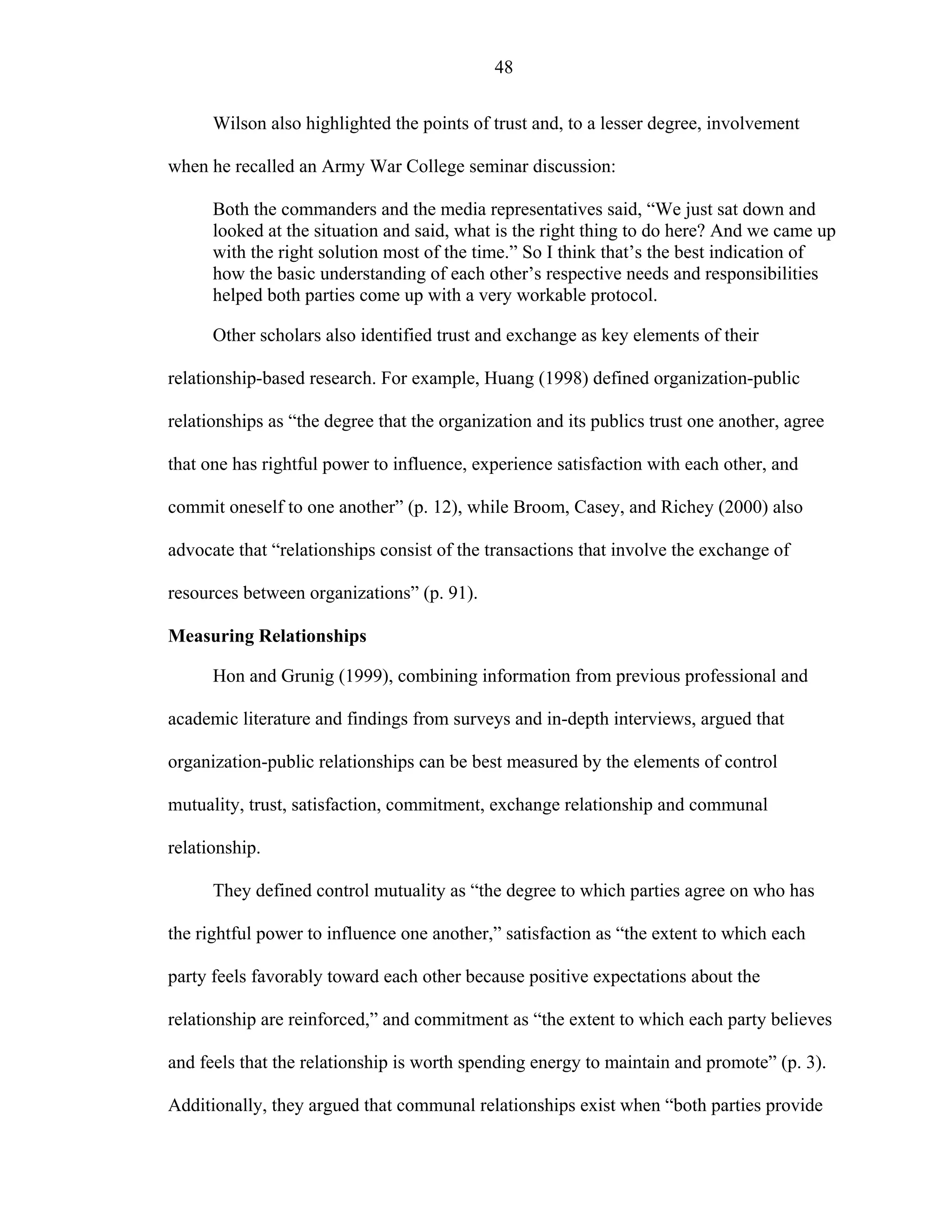
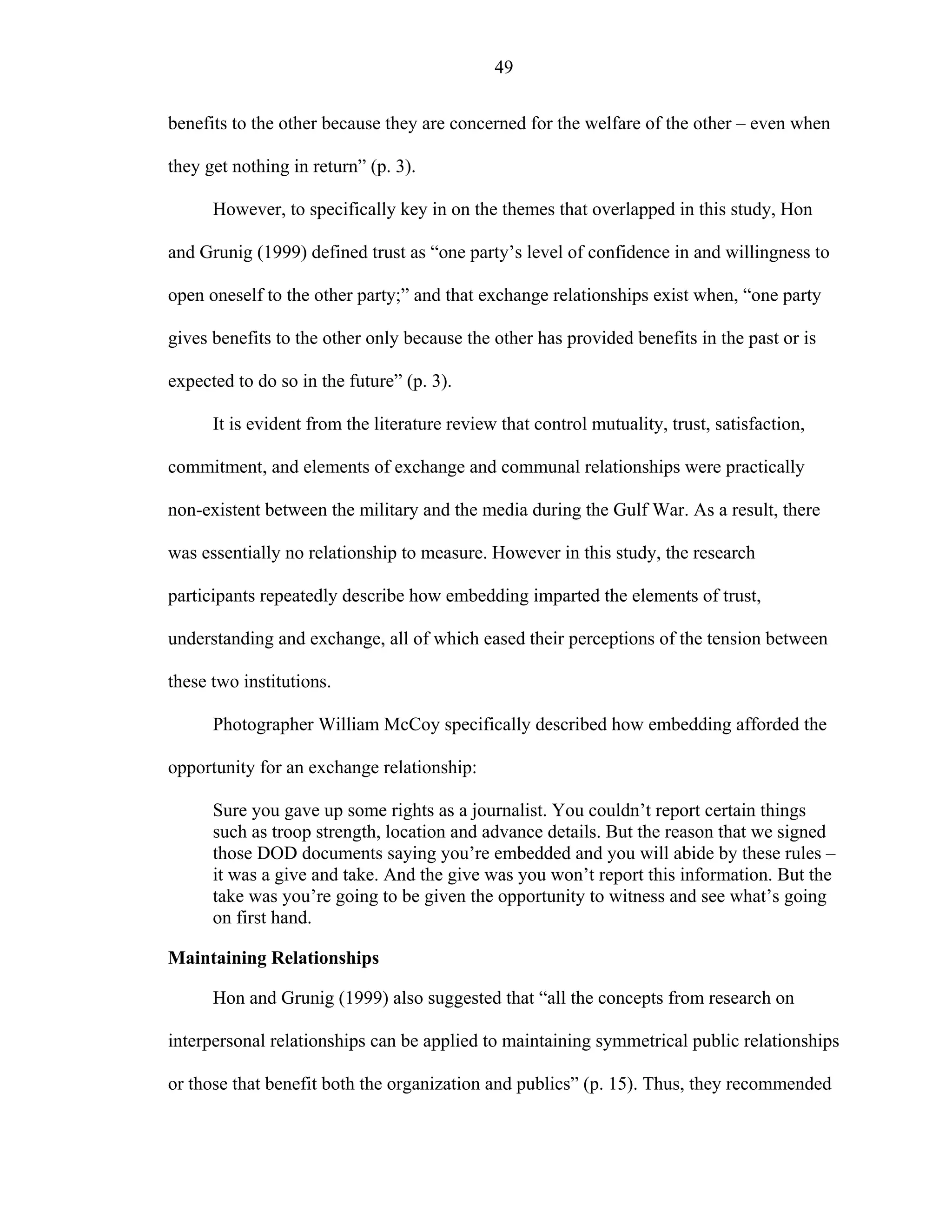
![50
the following strategies for maintaining relationships: access, positivity, openness,
assurances, networking, and sharing of tasks. Specifically, they recognized access as
when “senior managers provide representatives of publics access to organizational
decision-making processes.” They described positivity as “anything the organization or
public does to make the relationship more enjoyable for the parties involved,” openness
as “thoughts and feelings among parties involved” (p. 14) and assurances as “attempts by
parties in the relationship to assure the other parties that they and their concerns are
legitimate.” The last two strategies for maintaining relationships include networking, in
which “organizations’ building networks or coalitions with the same groups that their
publics do,” and sharing of tasks where the “organizations and the publics share in
solving joint or separate problems” (p. 15).
McCoy further described the “give and take” of being embedded when he
addressed access and openness in this context:
You’re going to live there. You’re going to be with the people [the military].
You’re going to understand what’s happening on a 24-hour basis. Instead of just
being ferried in on a helicopter for a one-hour ‘look-see’ to see people all smiley
and happy, this was an opportunity for us to be there, to witness history.
Jeff Wilson offered the following observation that hints at Hon and Gruinig’s
notion of positivity:
My cameraman, who was very much against the military, said the only thing that
kept him going was the basic principles of selflessness, camaraderie, and the good
humor that were so prevailing with the military.
However, of the five strategies suggested by Hon and Grunig (1999), this study
also illustrates how assurances are not only essential to maintaining relationships, but
also to establishing them. Again as indicated in the literature review, during the Gulf
War, the military sought to fulfill its own objectives, with little regard to accommodating](https://image.slidesharecdn.com/f1b809f5-114d-4260-9982-5cc91e095028-170129060938/75/Interpreting_the_embedded_media_experience-1-56-2048.jpg)
![51
the needs and desires of the press. As a result, a large majority of the media felt hampered
by the military’s highly-restrictive media relations’ policies.
Conversely, during the War in Iraq, several of the research participants in this study
alluded to how media embedding legitimized a primary concern of having unobscured
access to the battlefield.
Furthermore, Ledingham and Bruning (1998b) suggested that, “to be effective and
sustaining, relationships need to be seen as mutually beneficial” (p. 27). In this study,
most of the participants contend that embedding benefited both the military and the
media. For example, reporter Bruce Kelly claimed, “It was good process for the military
to give reporters a taste of what military life was like so they have a better understanding,
a better first hand knowledge and experience. On the flipside, reporters got to experience
it and [as a result] handed out much better, clearer stories.” Reporter Rachel North made
a similar observation that demonstrated the mutual benefits of the relationship:
I would say that it [embedding] worked in that it provided a decent framework for
the two sides to work together and fulfill separate objectives. I think I did a good
job of informing people . . . I don’t think I slowed my unit down in any way. They
offered a level of protection that I wouldn’t have had if I had just gone out there on
my own.
Professional, Personal and Community Relationships
In a quantitative study based on survey results from customers’ views of an
organization, Bruning and Ledingham (1999) determined that organization-public
relationships fall into three categories: professional, personal and community. They
observed that in a professional relationship, “it is important that services be delivered in a
businesslike manner, that those services meet the business needs of the customer, and that
the organization demonstrate a willingness to invest financially in the relationship” (p.](https://image.slidesharecdn.com/f1b809f5-114d-4260-9982-5cc91e095028-170129060938/75/Interpreting_the_embedded_media_experience-1-57-2048.jpg)
![52
71). Marine Corps PAO Capt. Edith Miller spoke of her experience that aligned with this
description of a professional relationship:
Because I consider both the media and my command to be my clients, my job is to
further the media’s ability to cover my command. So the more I was able to meet
and talk with them [the media] once they were assigned with me, the better I was
able to meet their specific needs.
Also as William McCoy described it earlier in the “relationships” theme, “It’s all in
basically developing sources and developing reputations and . . . I don’t want to say the
word friendships, but it’s business relationships. They know you, they respect you. It’s a
respect factor.”
Turning now to the level of personal relationships, Bruning and Ledingham (1999)
suggested the importance of taking a personal interest and engaging “in actions that build
a sense of trust” and a willingness to “demonstrate commitment” to the needs of each
other (p. 71). For example, Dave Evanston’s claim, “I found a whole new ‘band of
brothers’ for the rest of my life,” verified that he and some of the soldiers had obviously
developed personal relationships.
Bruning and Ledingham (1999) defined the third type of relationship, community,
as an organization’s “commitment to and interaction with the communities it serves,” (p.
70). Several participants in the current study described what could be categorized as this
community-level relationship, which was identified by the theme becoming the “link
back home.” It was even described by one of the participants as one of the “most
gratifying things” about being embedded.
Reporter George Lamont recalled, “Several weeks after I came back…while I was
waiting to cross the street, a car’s pulling by and this guy looks at me, stops dead in his](https://image.slidesharecdn.com/f1b809f5-114d-4260-9982-5cc91e095028-170129060938/75/Interpreting_the_embedded_media_experience-1-58-2048.jpg)
![53
tracks and says, ‘Are you the reporter who covered the war? I just want to shake your
hand.’” Reporter Tommy Rafferty made a similar claim:
I think my relationship with the people here at home, the people reading the paper –
it got a whole lot better. People are just amazed that I would go into a war area like
that . . . with no training or no weapon, and just volunteer to be with the soldiers.
Since I’ve been back, I’ve probably done more than a dozen talks at Rotary Clubs,
Kiwanis Clubs and other civic clubs, and things like that. It really improved the
newspaper’s relationship with the community. Because we hadn’t done anything
like that [embedding] ever, that I know of.
The findings of this study demonstrate that embedding not only provided an
opportunity for the research participants to establish and strengthen relationships, but the
diversity of their personal accounts and anecdotes indicate that these relationships
spanned the complete range from professional to personal to community in nature, as
described by Bruning and Ledingham (1999).
Interpersonal Communication in Relationships
Toth (2000) argued that “the goal of interpersonal communication is to establish
and maintain successful relationships” (p. 217) and “rather than interpersonal
communication as merely a context, such as between people, typically face to face in a
private setting, the focus is on interpersonal communication that develops a relationship
between individuals” (p. 215).
As indicated by the participants in this study, embedding brought individual
reporters up-close and personal into military units, where the relationships that formed
were based on interpersonal communication between individuals. And as most of the
participants attested, there was “no filter” or “interference” from public affairs officers
attempting to monitor or control coverage of the events.
Toth (2000) identified the elements of mutuality of understanding, trust, credibility,
emotion, intimacy and similarity, immediacy and dominance-submission as “some](https://image.slidesharecdn.com/f1b809f5-114d-4260-9982-5cc91e095028-170129060938/75/Interpreting_the_embedded_media_experience-1-59-2048.jpg)
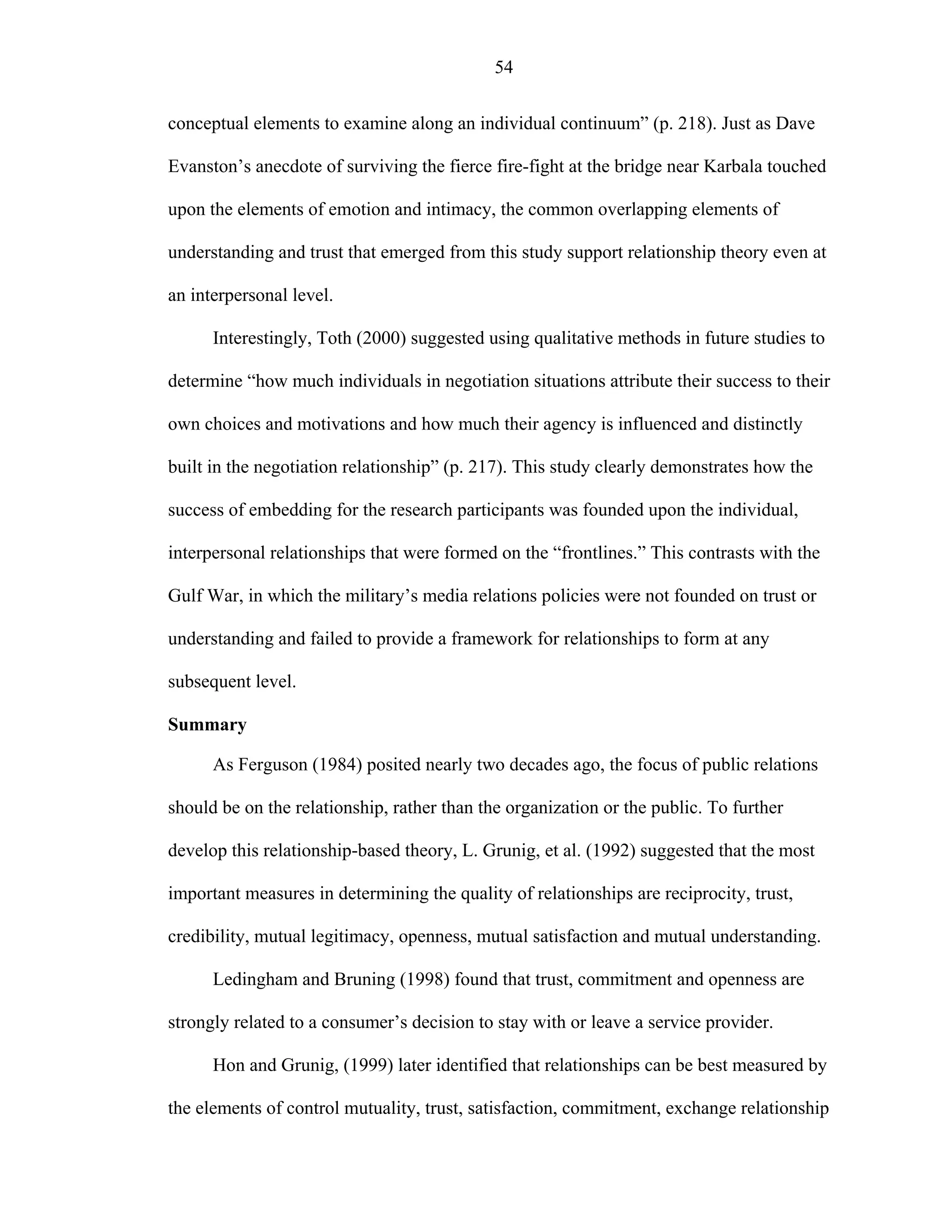
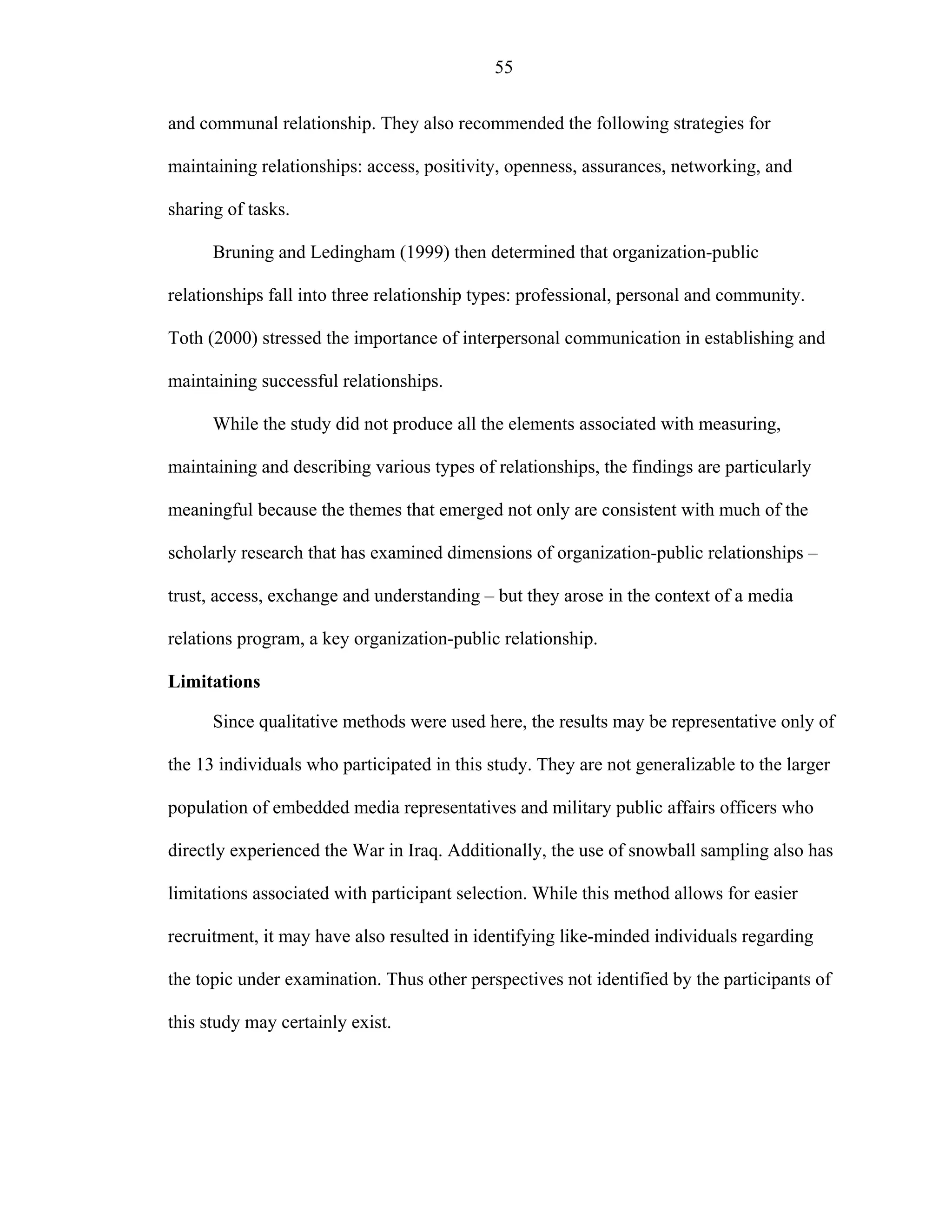
![56
Conclusion
This exploratory, qualitative approach to examining the ubiquitous spectacle of
media embedding during the U.S. military’s largest combat operation since the Gulf War
afforded an opportunity to establish grounded theory. Instead, what emerged were four of
the elements identified in the scholarly literature as central to organization-public
relationships.
More importantly, these themes emerged from the field by way of open-ended
interviews with research participants who were, in all likelihood, not familiar with the
academic theory of relationship management. Furthermore, these findings add even more
stability to relationship theory because 11 of the 13 participants were representatives of
the media who identified some of the same key elements and terminology that public
relations scholars have been using to define, measure and maintain organization-public
relationships over the past several years.
Further reflecting on the methodology of this study, a comparison to quantitative
approaches comes to mind:
The research interview is an interpersonal situation, a conversation between two
partners about a theme of mutual interest. It is a specific form of human interaction
in which knowledge evolves through dialogue. The interaction is neither as
anonymous and [sic] neutral as when a subject responds to a survey questionnaire,
nor as personal and emotional as a therapeutic interview. (Kvale, 1996, p. 125)
The inductive methodology of this study in which words, experiences, expressions
and feelings were candidly revealed by the research participants and which developed
into subsequent emergent themes, offers a measure of triangulation to the relational
theory and perspective of public relations.
Moreover, this study is unique in that it qualitatively examined media relations
from the relational perspective. Apart from Esposito and Koch (2000), who conducted a](https://image.slidesharecdn.com/f1b809f5-114d-4260-9982-5cc91e095028-170129060938/75/Interpreting_the_embedded_media_experience-1-62-2048.jpg)
